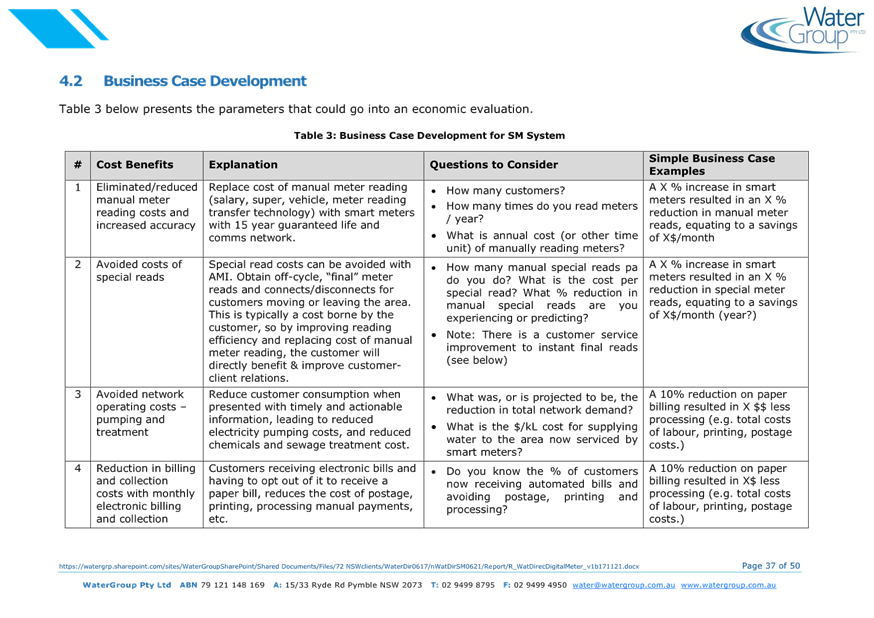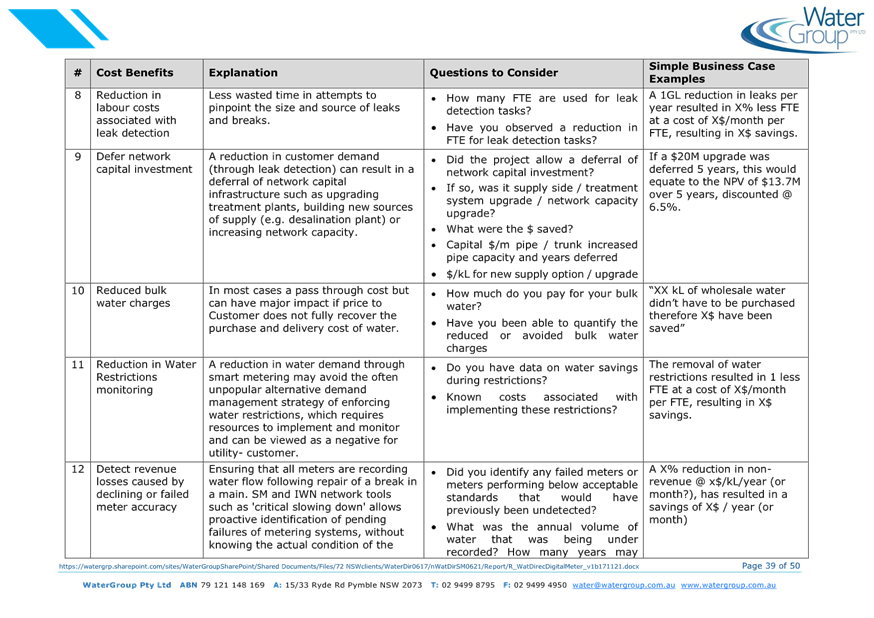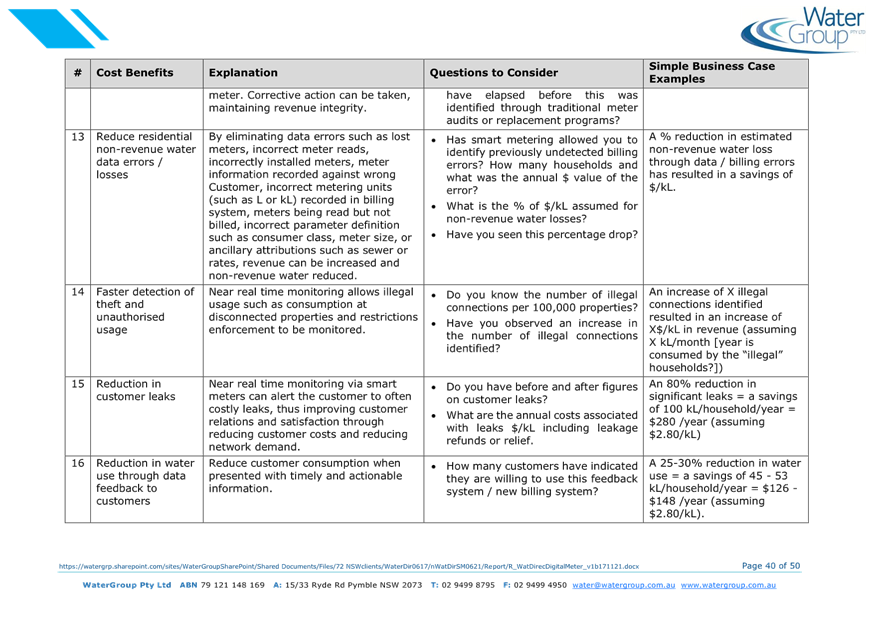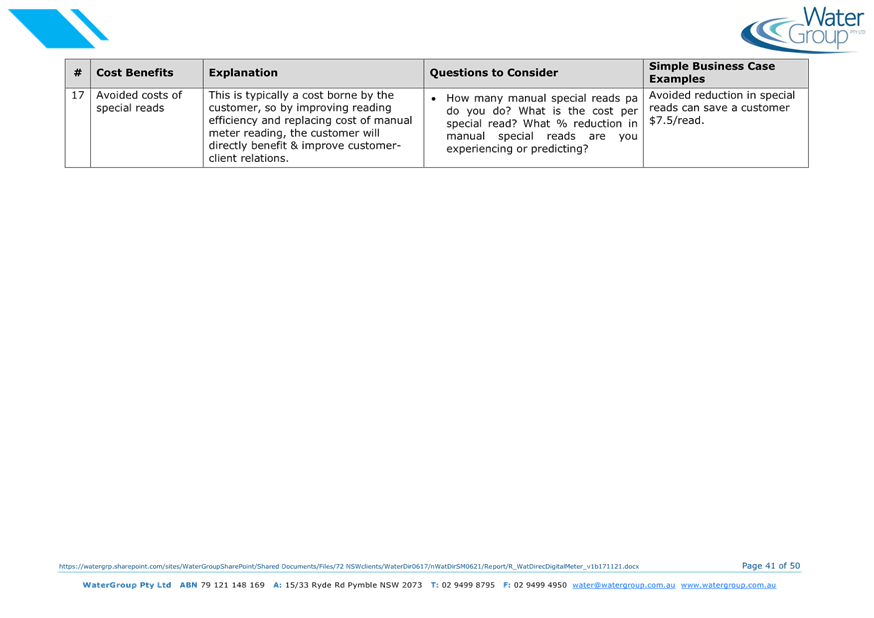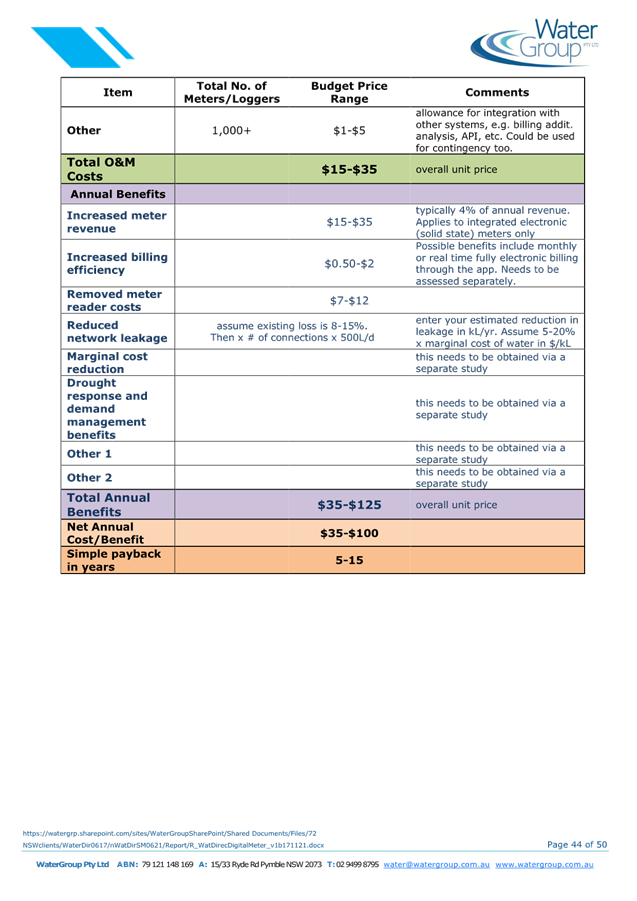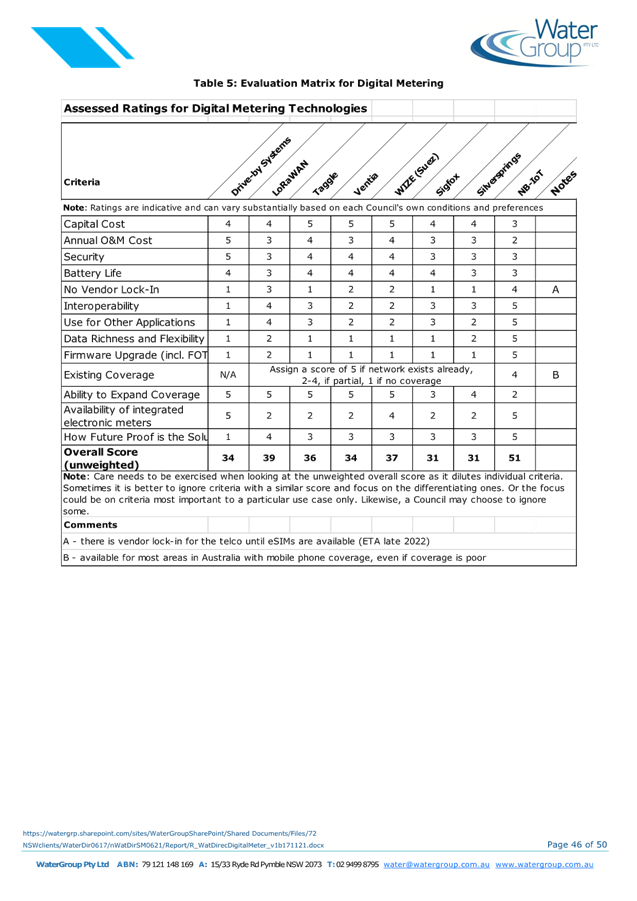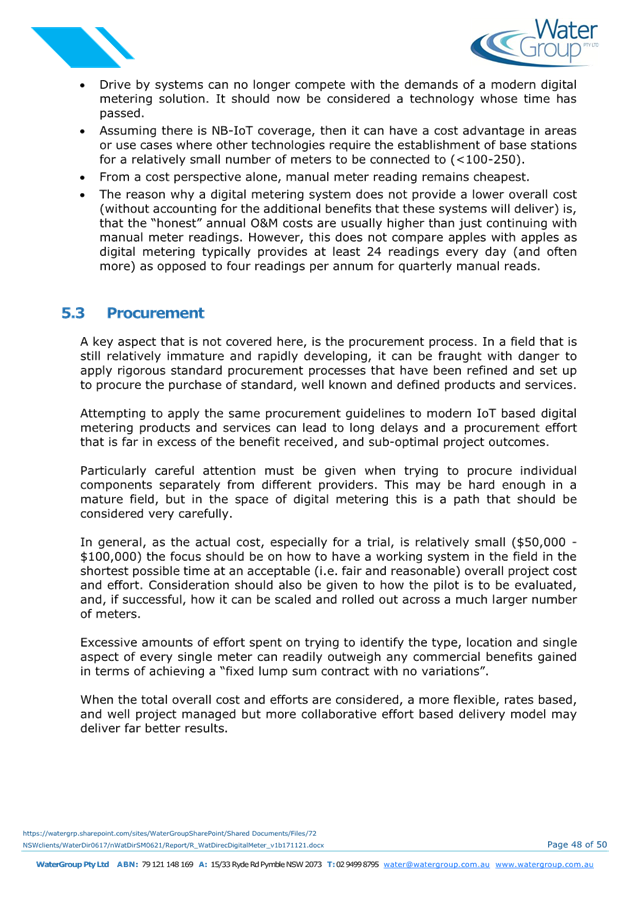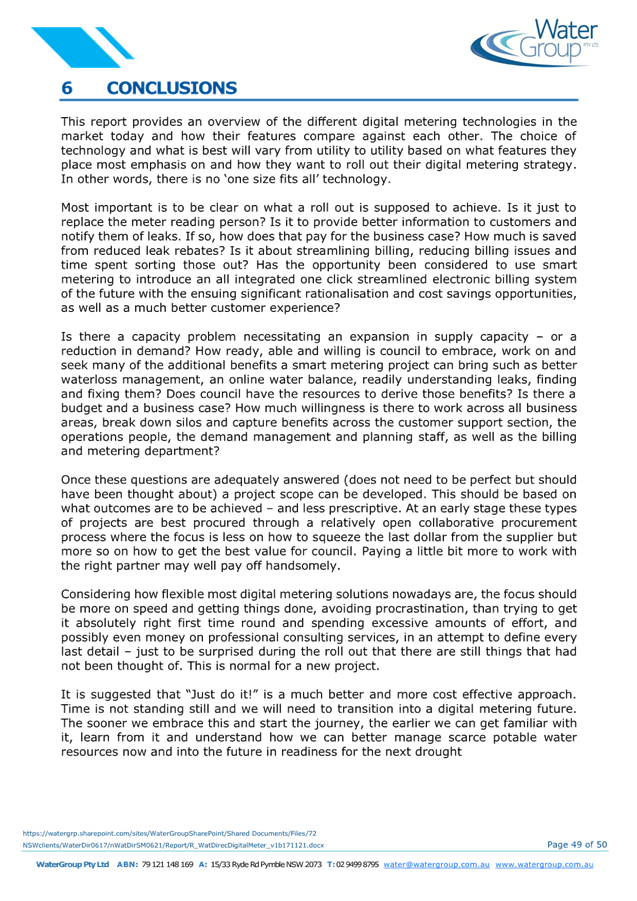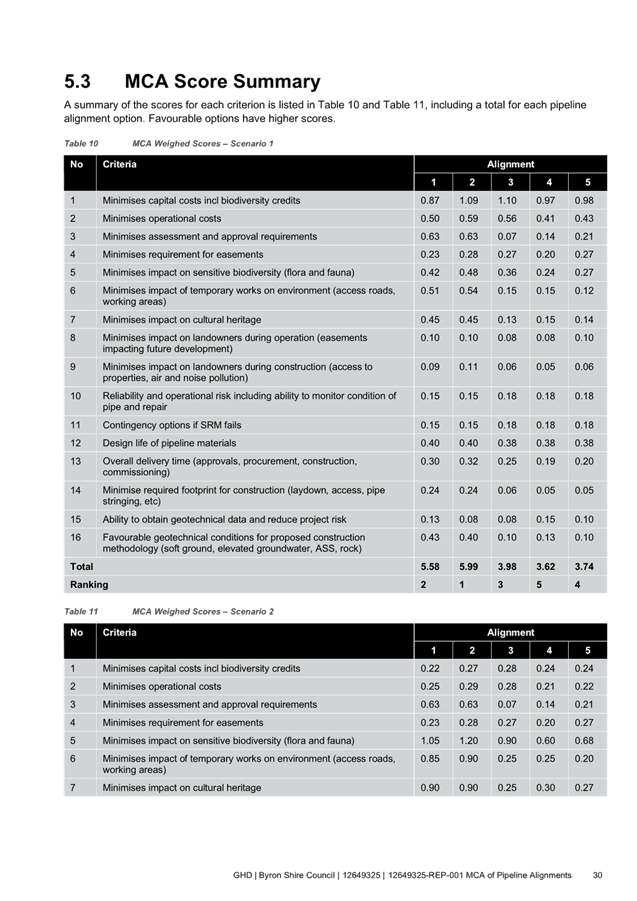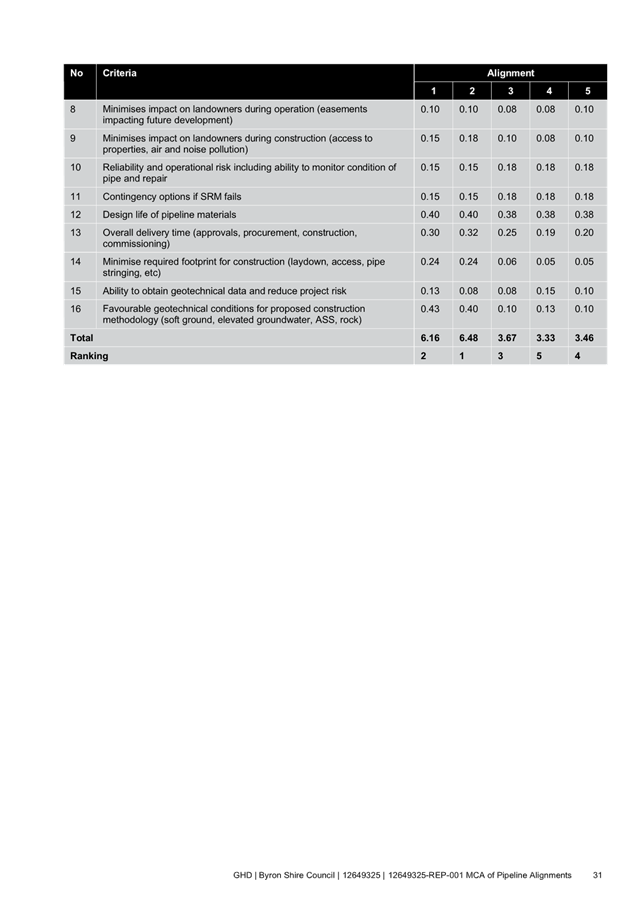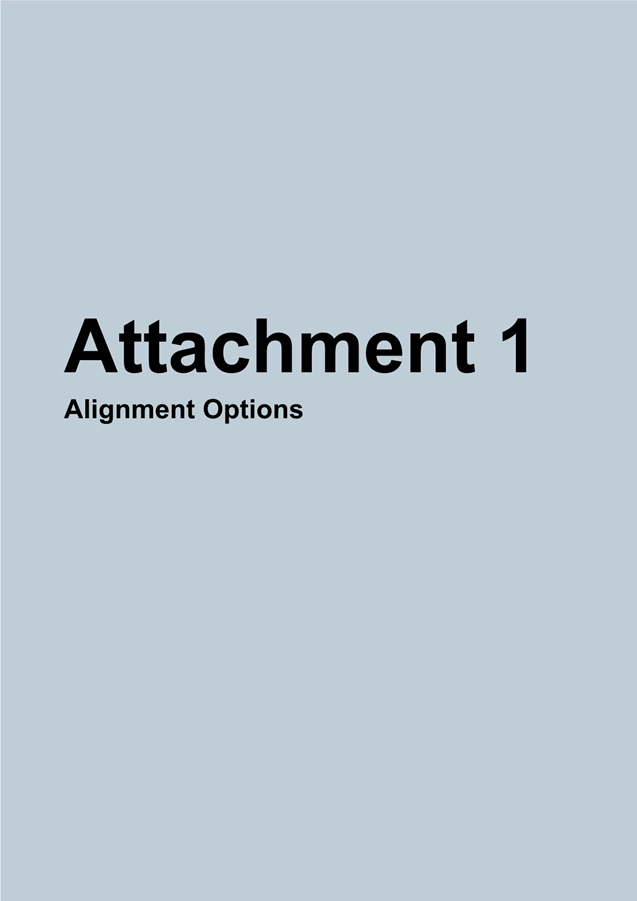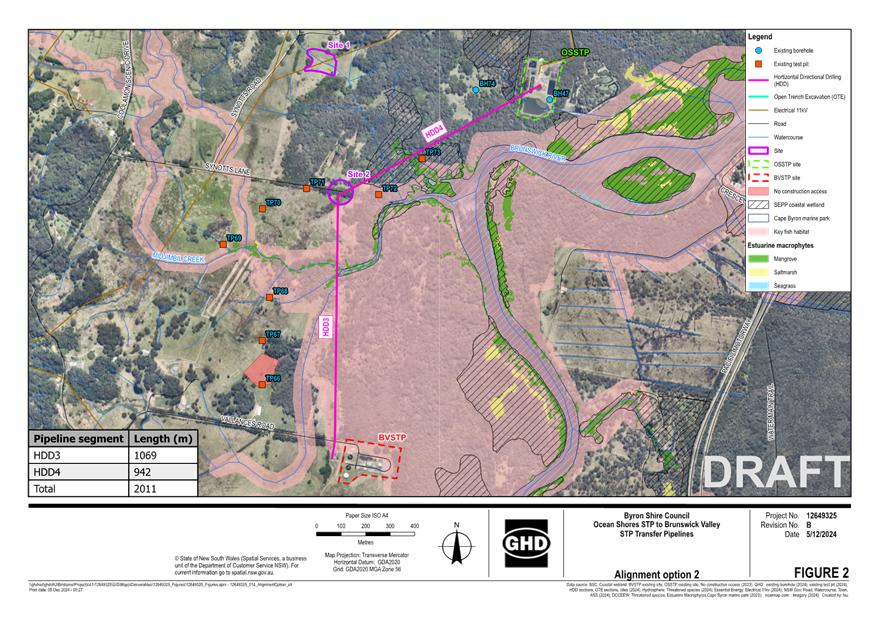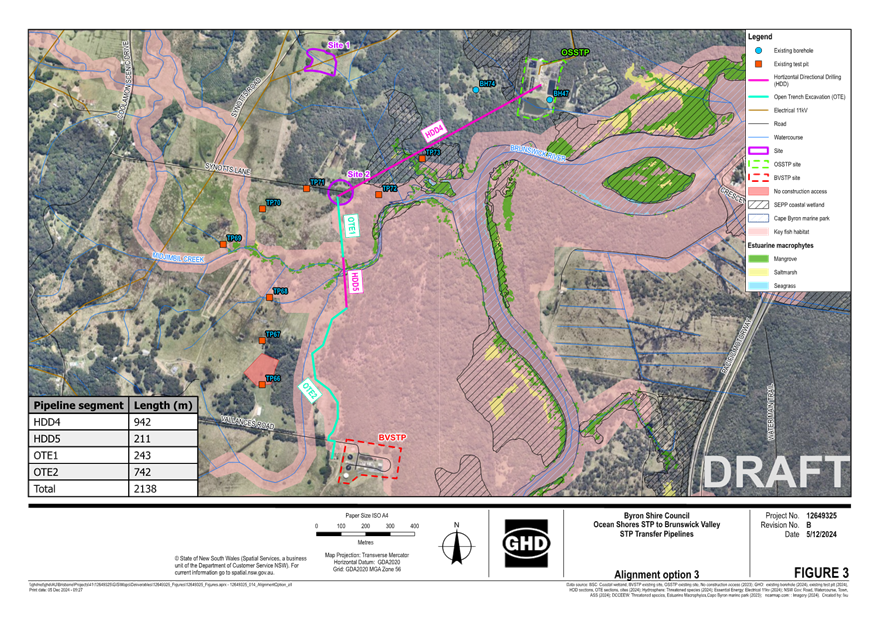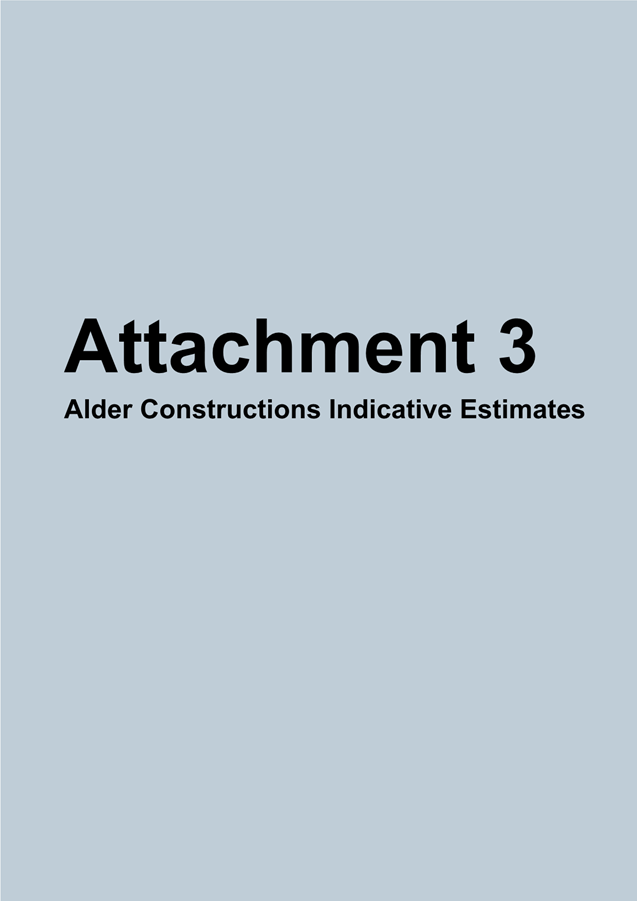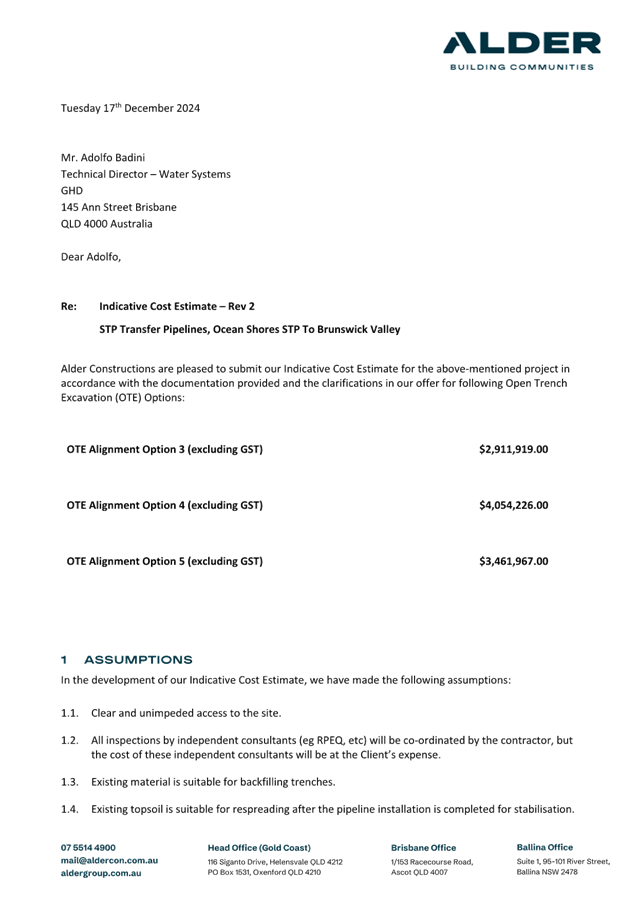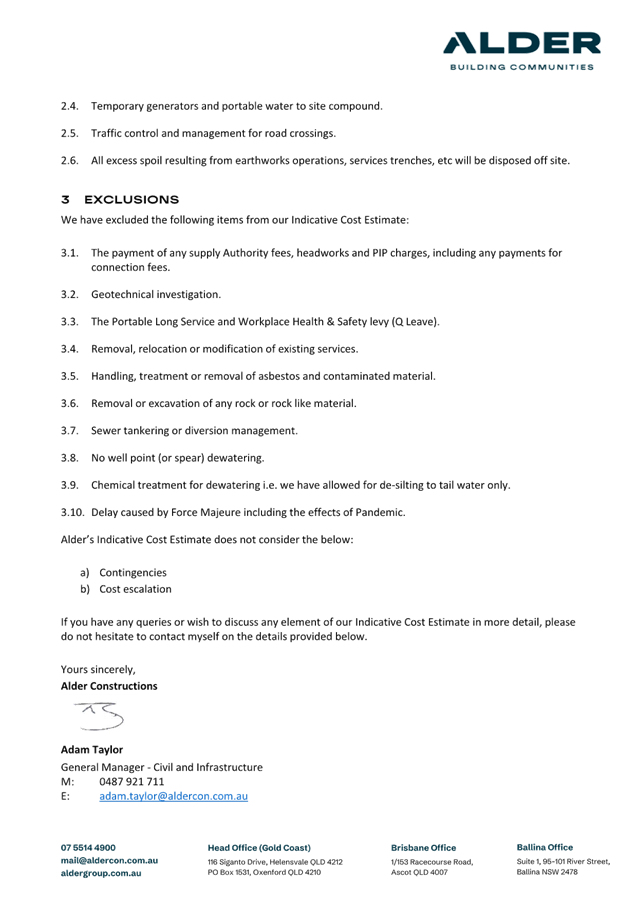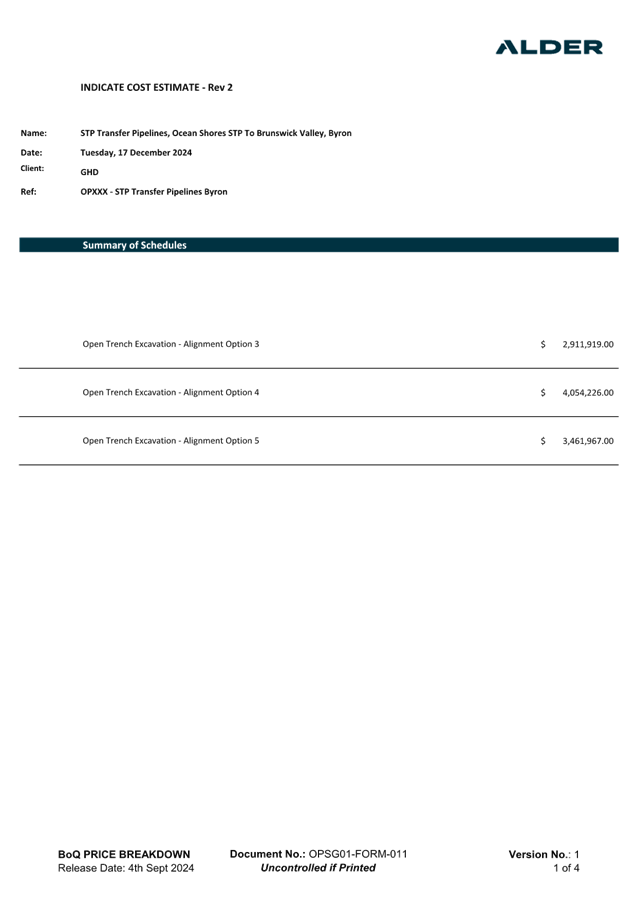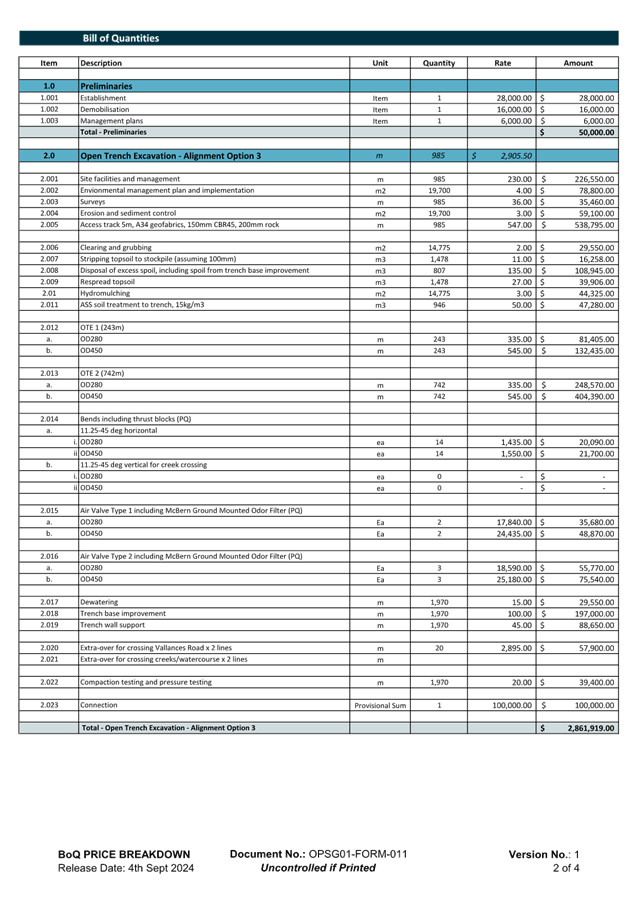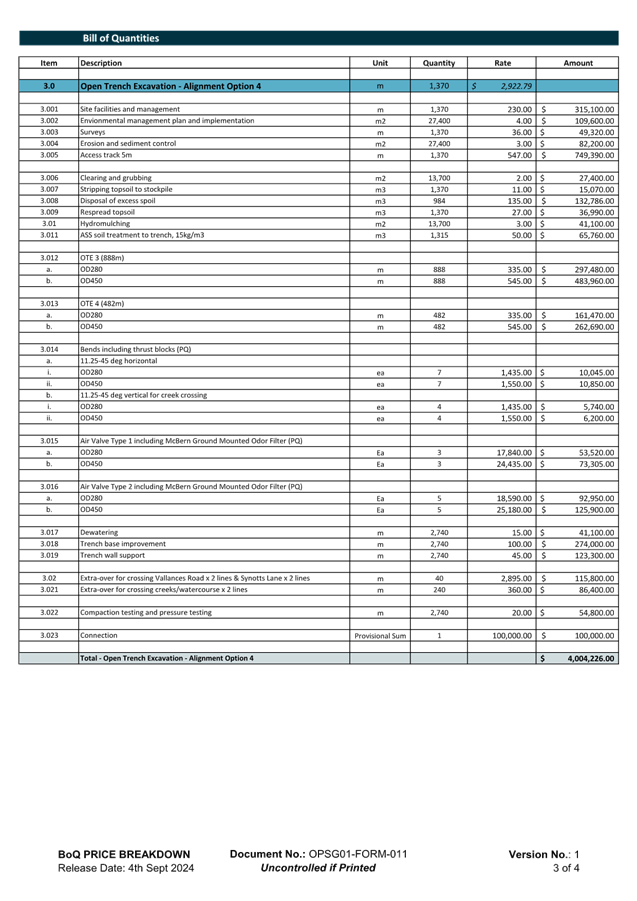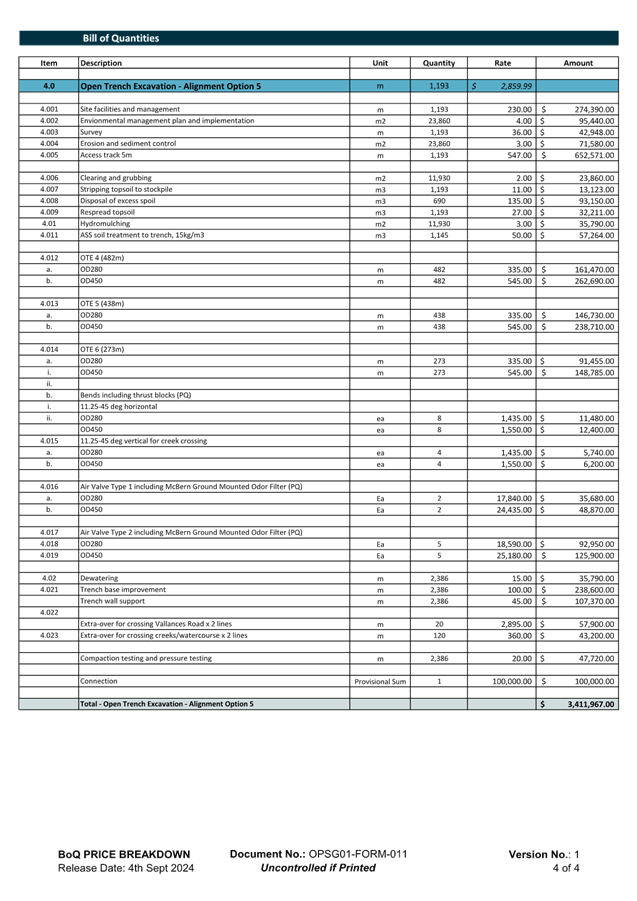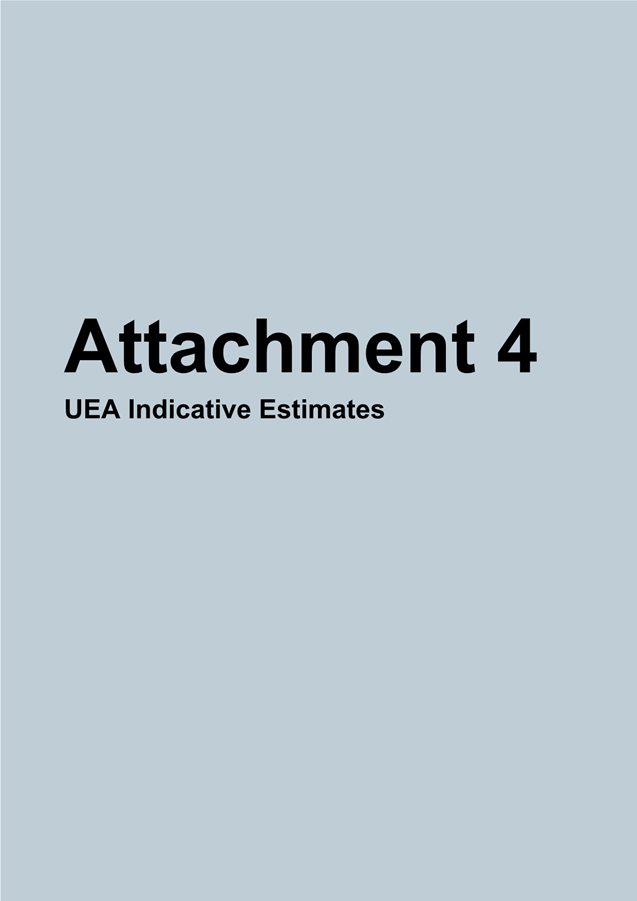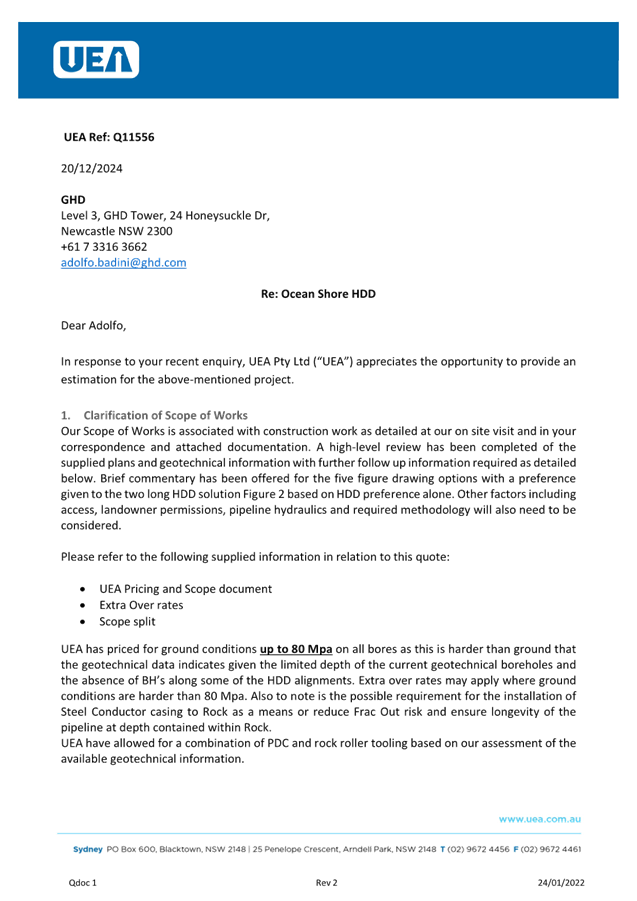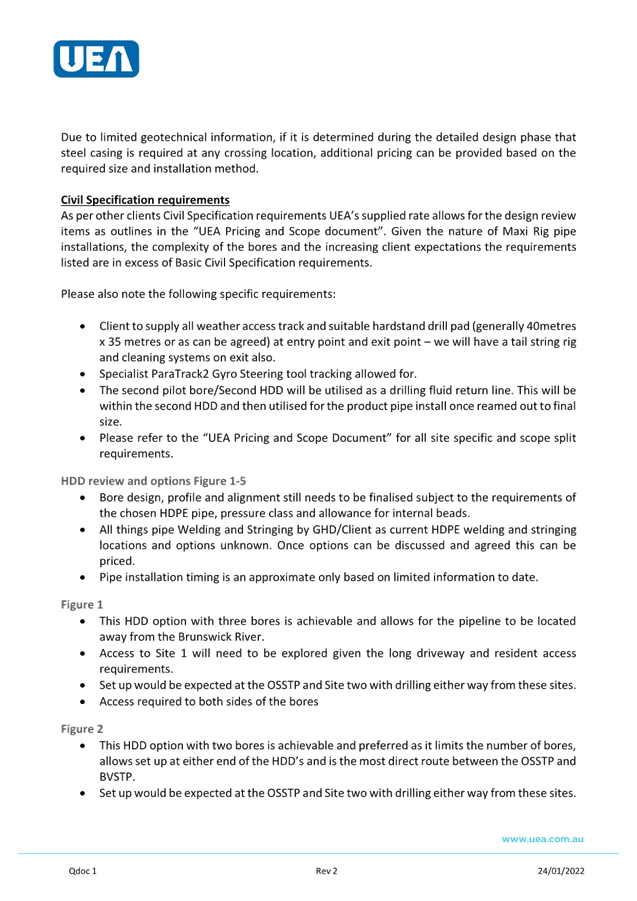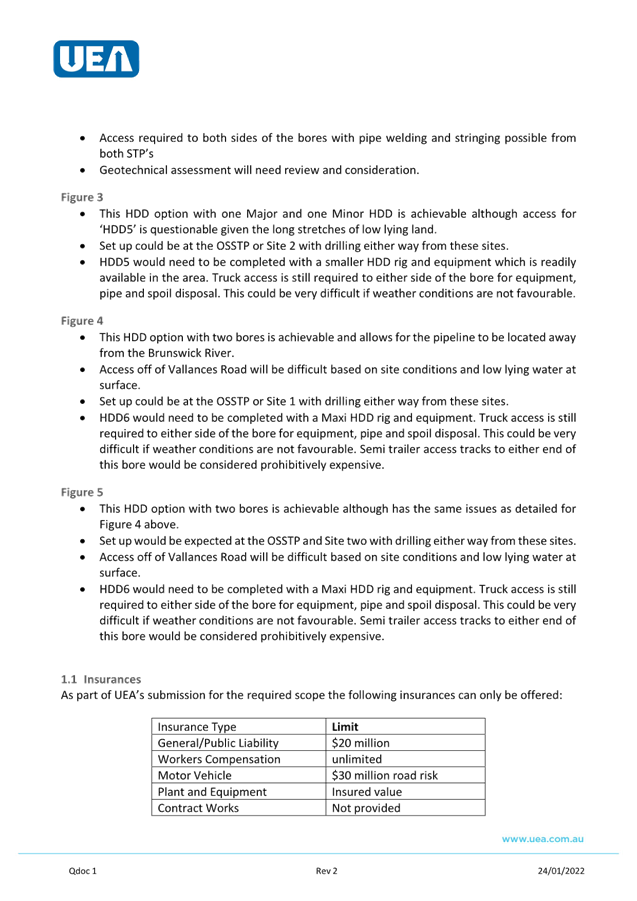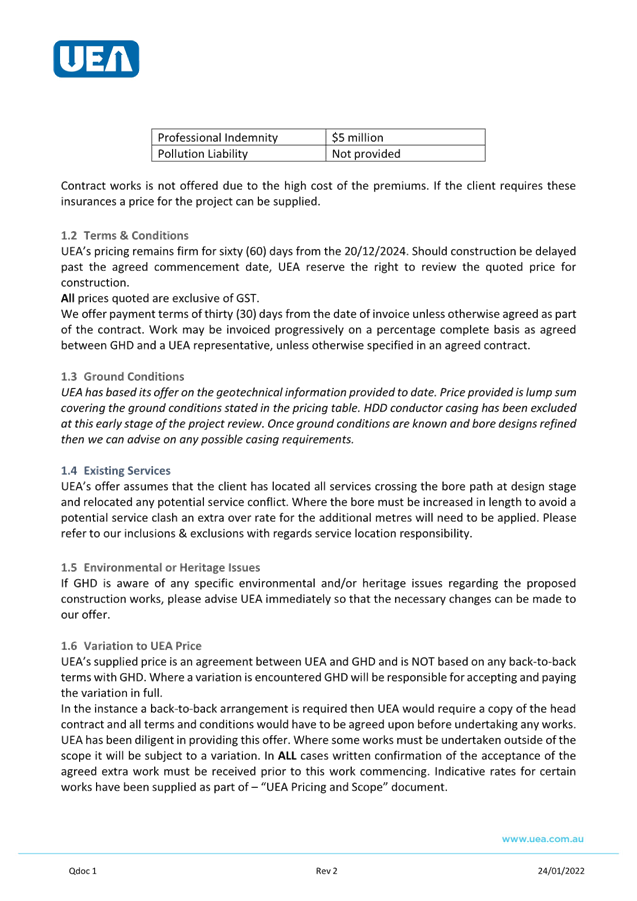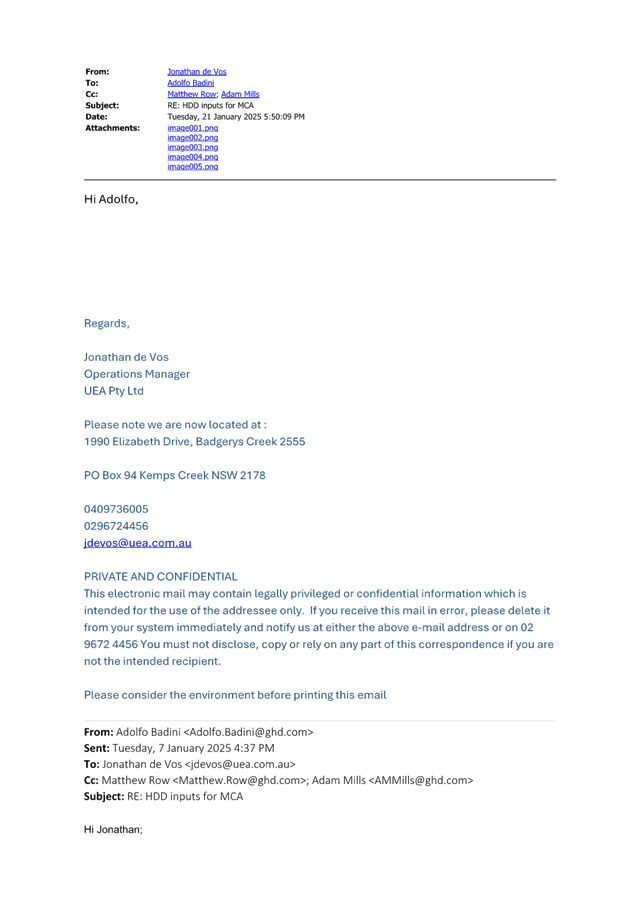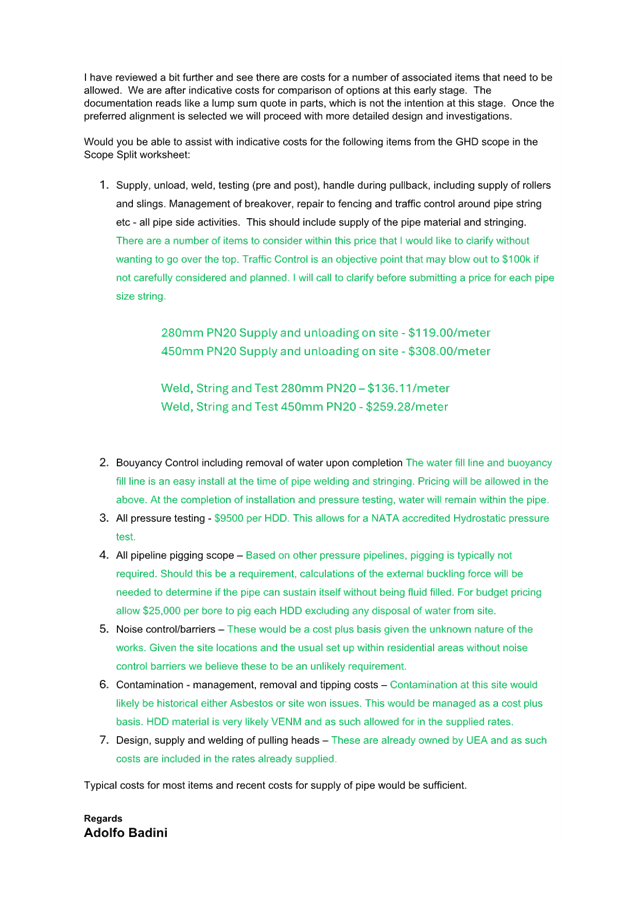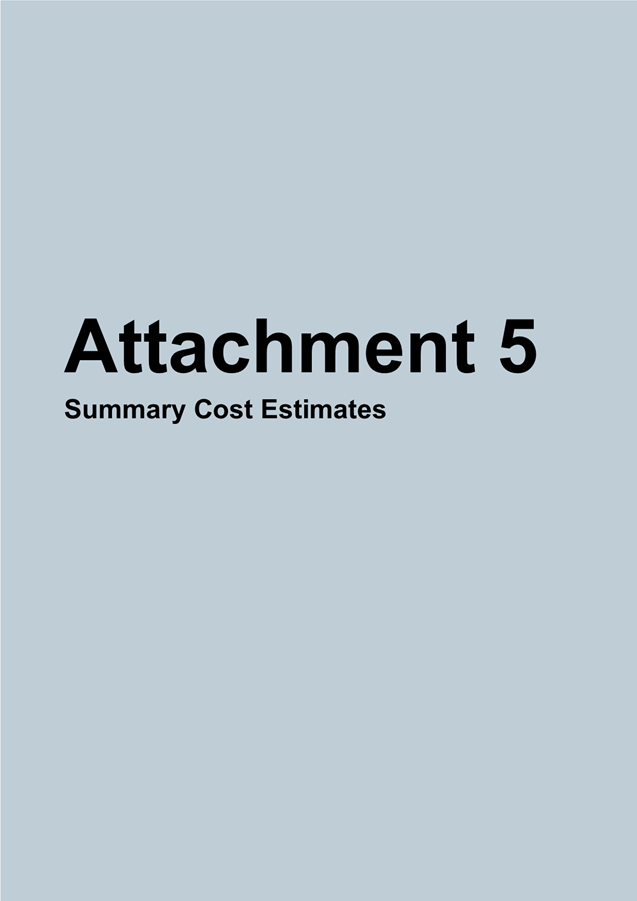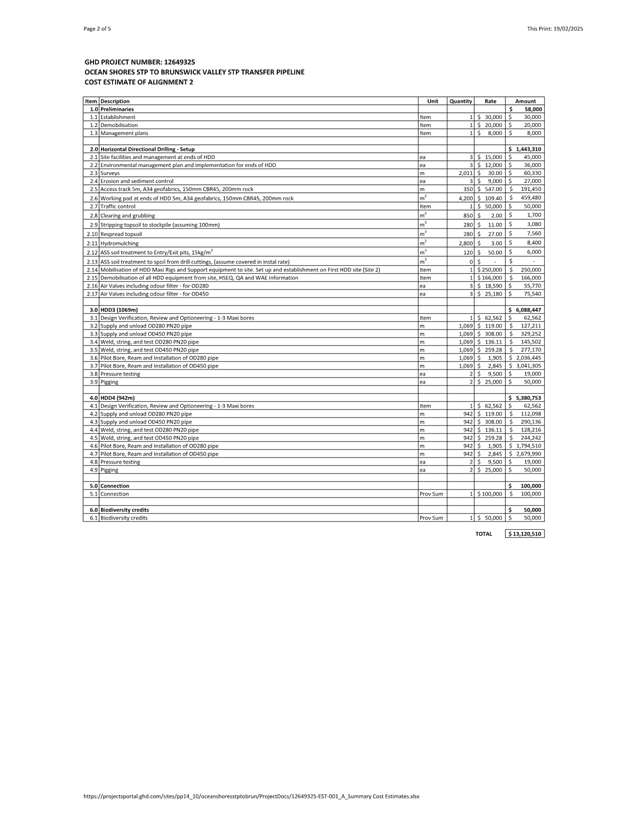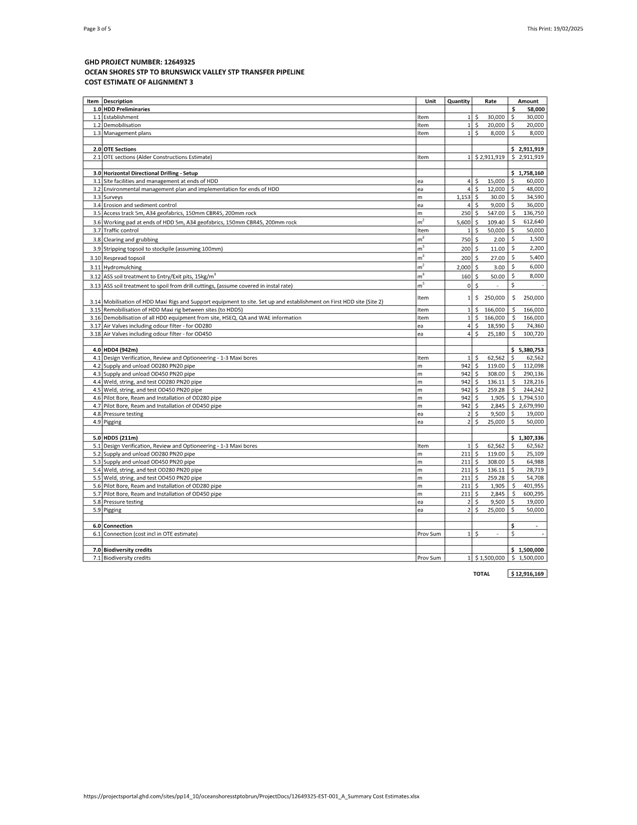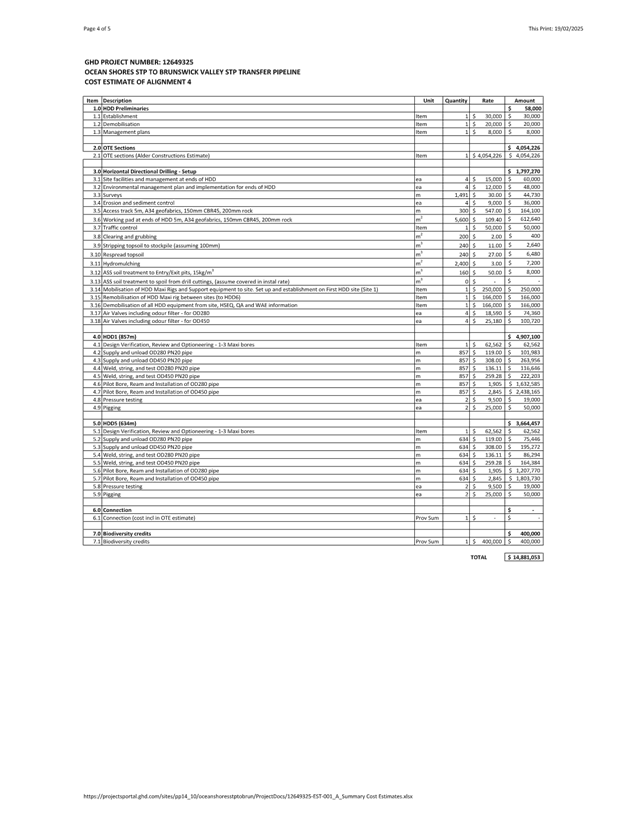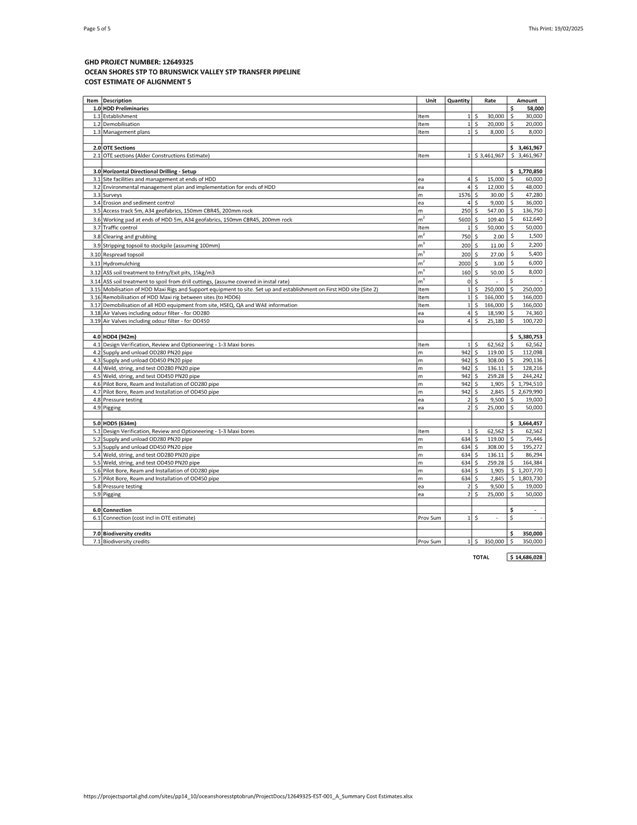Notice of Meeting
Water and Sewer Advisory Committee Meeting
A Water and Sewer
Advisory Committee Meeting of Byron Shire Council will be held as follows:
|
Venue
|
Conference Room, Station Street, Mullumbimby
|
|
Date
|
Thursday, 19 June 2025
|
|
Time
|
11:30 AM
|
Phil Holloway
Director Infrastructure
Services
 I2025/867
I2025/867
Distributed
12/06/25
What is a “Conflict of Interests” - A conflict of
interests can be of two types:
Pecuniary - an interest that a person has in a matter because of a reasonable
likelihood or expectation of appreciable financial gain or loss to the person
or another person with whom the person is associated.
Non-pecuniary – a private or personal interest that a Council
official has that does not amount to a pecuniary interest as defined in the
Code of Conduct for Councillors (eg. A friendship, membership of an
association, society or trade union or involvement or interest in an activity
and may include an interest of a financial nature).
Remoteness – a person does not have a pecuniary interest in a matter
if the interest is so remote or insignificant that it could not reasonably be
regarded as likely to influence any decision the person might make in relation
to a matter or if the interest is of a kind specified in the Code of Conduct
for Councillors.
Who has a Pecuniary Interest? - a person has a pecuniary interest in a
matter if the pecuniary interest is the interest of the person, or another
person with whom the person is associated (see below).
Relatives, Partners - a person is taken to have a pecuniary
interest in a matter if:
·
The
person’s spouse or de facto partner or a relative of the person has a
pecuniary interest in the matter, or
·
The
person, or a nominee, partners or employer of the person, is a member of a
company or other body that has a pecuniary interest in the matter.
N.B. “Relative”, in relation to a person means any of the
following:
(a) the parent,
grandparent, brother, sister, uncle, aunt, nephew, niece, lineal descends or
adopted child of the person or of the person’s spouse;
(b) the spouse
or de facto partners of the person or of a person referred to in paragraph (a)
No Interest in the Matter - however, a person is not taken to have a
pecuniary interest in a matter:
·
If
the person is unaware of the relevant pecuniary interest of the spouse, de
facto partner, relative or company or other body, or
·
Just
because the person is a member of, or is employed by, the Council.
·
Just
because the person is a member of, or a delegate of the Council to, a company
or other body that has a pecuniary interest in the matter provided that the
person has no beneficial interest in any shares of the company or body.
Disclosure and participation in meetings
·
A
Councillor or a member of a Council Committee who has a pecuniary interest in
any matter with which the Council is concerned and who is present at a meeting
of the Council or Committee at which the matter is being considered must
disclose the nature of the interest to the meeting as soon as practicable.
·
The
Councillor or member must not be present at, or in sight of, the meeting of the
Council or Committee:
(a) at
any time during which the matter is being considered or discussed by the
Council or Committee, or
(b) at
any time during which the Council or Committee is voting on any question in
relation to the matter.
No Knowledge - a person does not breach this Clause if the person did
not know and could not reasonably be expected to have known that the matter
under consideration at the meeting was a matter in which he or she had a
pecuniary interest.
Non-pecuniary Interests - Must be disclosed in meetings.
There are a broad range of options available for managing conflicts &
the option chosen will depend on an assessment of the circumstances of the
matter, the nature of the interest and the significance of the issue being
dealt with. Non-pecuniary conflicts of interests must be dealt with in at
least one of the following ways:
·
It
may be appropriate that no action be taken where the potential for conflict is
minimal. However, Councillors should consider providing an explanation of
why they consider a conflict does not exist.
·
Limit
involvement if practical (eg. Participate in discussion but not in decision
making or vice-versa). Care needs to be taken when exercising this
option.
·
Remove
the source of the conflict (eg. Relinquishing or divesting the personal
interest that creates the conflict)
·
Have
no involvement by absenting yourself from and not taking part in any debate or
voting on the issue as of the provisions in the Code of Conduct (particularly
if you have a significant non-pecuniary interest)
Committee members are reminded that they should declare and manage all
conflicts of interest in respect of any matter on this Agenda, in accordance
with the Code of Conduct.
RECORDING OF VOTING ON PLANNING MATTERS
Clause 375A of the Local Government Act
1993 – Recording of voting on planning matters
(1) In this section, planning
decision means a decision made in the exercise of a function of a council
under the Environmental Planning and Assessment Act 1979:
(a) including a decision relating to a development
application, an environmental planning instrument, a development control plan
or a development contribution plan under that Act, but
(b) not including the making of an order under that Act.
(2) The general manager is required to keep a register
containing, for each planning decision made at a meeting of the council or a
council committee, the names of the councillors who supported the decision and
the names of any councillors who opposed (or are taken to have opposed) the
decision.
(3) For the purpose of maintaining the register, a division
is required to be called whenever a motion for a planning decision is put at a
meeting of the council or a council committee.
(4) Each decision recorded in the register is to be described
in the register or identified in a manner that enables the description to be
obtained from another publicly available document and is to include the
information required by the regulations.
(5) This section extends to a meeting that is closed to the
public.
OATH AND AFFIRMATION FOR COUNCILLORS
Councillors are
reminded of the oath of office or affirmation of office made at or before their
first meeting of the council in accordance with Clause 233A of the Local
Government Act 1993. This includes undertaking the duties of the office of
councillor in the best interests of the people of Byron Shire and the Byron
Shire Council and faithfully and impartially carrying out the functions,
powers, authorities and discretions vested under the Act or any other Act
to the best of one’s ability and judgment.
BYRON SHIRE COUNCIL
BUSINESS OF MEETING
1. Apologies
2. Declarations
of Interest – Pecuniary and Non-Pecuniary
3. Minutes from Previous
Meetings
3.1 Adoption
of Minutes from Previous Meeting.............................................................. 6
4. Staff Reports
Infrastructure Services
4.1 The
Case for Implementing Digital Water Meters................................................... 15
4.2 Ocean
Shores STP Transfer Line Update Report................................................ 125
5. Late Reports
6. For Information Only
6.1 Status
update - Mullumbimby Water Supply Strategy Project........................... 202
6.2 Byron
Bay Sewage Treatment Plant Master Plan Update.................................. 221
BYRON SHIRE COUNCIL
Minutes from Previous Meetings 3.1
Minutes from Previous Meetings
Report No. 3.1 Adoption of Minutes from Previous Meeting
Directorate: Infrastructure Services
File No: I2025/869
RECOMMENDATION:
That the minutes of the Water and Sewer Advisory
Committee Meeting held on 17 April 2025 be confirmed.
Attachments:
1 Minutes
17/04/2025 Water and Sewer Advisory Committee, I2025/491 , page 9⇩ 
Report
The attachment to this report provides the minutes of the
Water and Sewer Advisory Committee Meeting of 17 April 2025 .
Report to Council
The minutes were reported to Council on 22 May 2025.
Comments
In accordance with the Committee Recommendations, Council
resolved the following:
|
|
Report No.
14.2 Report of the Water and
Sewer Advisory Committee Meeting held on 17 April 2025
File No: I2025/631
|
|
25-192
|
Resolved
that Council notes the minutes of
the Water and Sewer Advisory Committee Meeting held on 17 April 2025. (Swain/Lyon)
|
|
25-193
|
Resolved
that Council adopts the following
Committee Recommendations:
Report No.
4.1 Integrated Planning and Reporting
File No: I2025/481
Committee Recommendation 4.1.1
That the Water and Sewer
Advisory Committee:
1. Notes
Council’s Integrated Planning and Reporting Framework;
2. Notes
Council’s priorities as identified by Councillors for the 2025 –
2029 and Delivery Program. (Swain/Lyon)
|
|
25-194
|
Resolved
that Council adopts the following Committee Recommendations:
Report No.
4.2 Mullumbimby water supply strategy - High-level project plan
File No: I2025/395
Committee Recommendation 4.2.1
1. That
the Water and Sewer Advisory Committee notes the proposed project design
2. That
the Committee provides feedback to staff on how to improve the project
design, in alignment with:
a)
The aim of the project i.e. provide evidence-based
recommendations for Council to decide on a
long-term water supply strategy for Mullumbimby
b)
The need to provide best-value to ratepayers via sustainable
and efficient water services provision
3. That Council
keeps the WSAC informed of subsequent changes to the project design,
including between WSAC meetings.
4. That
Council considers in the project the investigations previously sought by the
WSAC, and recorded in its Minutes for the meeting of 19 July 2024.
(Swain/Lyon)
|
BYRON SHIRE COUNCIL
Minutes
from Previous Meetings 3.1 - Attachment 1






BYRON SHIRE COUNCIL
Staff Reports - Infrastructure Services 4.1
Staff Reports - Infrastructure Services
Report No. 4.1 The
Case for Implementing Digital Water Meters
Directorate: Infrastructure
Services
Report Author: Pablo
Orams, Integrated Water Management Officer
File No: I2025/855
Summary:
This report aims to brief the WSAC
on the investigations done by Council staff to assess the potential benefits
and feasibility of adopting Digital Water Metering (DWM) across the
Shire’s water supply network. It also provides key recommendations
and a tentative plan/budget for its implementation. Staff hopes to gain
feedback from the WSAC to identify further opportunities and/or challenges
related to this proposal.
RECOMMENDATION:
That the Water and Sewer Advisory Committee: -
1. Notes
the report and attached supporting documentation.
2. Provides
staff with feedback regarding:
a) The
appetite of Council and the community to adopt Digital Water Metering;
b) The
information presented in this report (e.g. the benefits of DWM, recommendations
for implementation, etc); and
c) Any
knowledge gaps that staff may need to explore before presenting a project
proposal to Council.
Attachments:
1 Report
16/10/2024 Executive Team Meeting (Operational) Digital Water Metering Pilot -
Outcomes and Recommendations, I2024/1130
, page 26⇩ 
2 Conceptual
diagram - Digital Water Metering system governance and architecture, E2024/93422 ,
page 58⇩ 
3 WSAA
Digital Metering State of Play Summary Report, E2024/84547 , page 59⇩ 
4 Water
Directorate 2021 Digital Metering Guidelines, E2024/84550
, page 66⇩ 
5 Report
04/12/2024 Executive Team Meeting (Operational) Preliminary implemetation plan
- Digital water metering, I2024/1436
, page 116⇩ 
6 Digital
Water Metering Project - Proposed 30-year budget - 28 May 2025, E2025/57655 ,
page 124
Report
1. Purpose
To brief the WSAC on the investigations done by Council
staff to assess the potential benefits and feasibility of adopting Digital
Water Metering (DWM) across the Shire’s water supply network. This
report includes a tentative implementation plan and budget, funding strategy
and other recommendations. Staff hopes to gain feedback from the WSAC to refine
this project plan moving forward.
2. Background
Driven by the dry weather
conditions leading up to 2019, Byron Shire Council conducted a DWM pilot
project between 2020 and 2023. It involved the installation of 355
digital meters in East Mullumbimby (residential connections) and 31 in Byron
Bay Recycled Water Scheme (municipal and commercial connections), testing the
viability of a full-scale rollout, and the capabilities of the technology to
address water security challenges, improve customer engagement and drive
efficiencies in water services operations and planning.
The pilot provided valuable
insights that highlight the strong potential of DWM, as well as the
capabilities and resources required by Council to implement, operate and
maintain a DWM system. The full pilot report is available in Attachment
1, and has served as the basis to design a roadmap for the adoption of DMW
in Byron Shire.
3. What is DWM, and why is it important
DWM involves collecting and analysing near real-time water
consumption data through a combination of automated remote reading devices
(i.e. digital water meters), telecommunication networks, and data management
and analytics software. Attachment 2 provides
a conceptual diagram that outlines the key elements of a DWM system and how it
may integrate with Council’s management systems.
The potential benefits of this technology are extensive,
driving efficiencies across the potable water service supply chain. A
good way to understand these benefits is to first look at the limitations of
the traditional water consumption monitoring method based on analogue
water meters. This is the approach currently used by Byron Shire Council,
as well as most Councils and water utilities globally.

Figure 1 – A typical analogue water
meter used in Byron Shire (left) and a digital water meter used during
Council’s DWM pilot project (Right).
3.1.
Analogue water metering (and its limitations)
In Byron Shire, a property connected to the water supply
network will typically have an analogue water meter installed at the property
boundary, between the water supply main and the property’s internal water
plumbing. The meters are designed to record the volume of water (e.g.
kilolitres) flowing into such property.
Water consumption data is collected by manually opening the
meter’s casing and visually reading its dials. Meter reads are
typically done by a contractor once every three months (at a cost of over
$80,000/year), in alignment with the standard quarterly water billing cycle.
Collected data is then stored and handled by Council’s
Water Billing team using a combination of Excel spreadsheets and other
dedicated software (e.g. Authority). This data serves as the “point
of truth” from which Council derives water bills, and inform operational,
planning and investment decisions to improve water service delivery (e.g.
demand management, infrastructure upgrades, etc.).
Despite the importance of water consumption data for
Council, there are two fundamental limitations with obtaining it via an
analogue water metering system: low data resolution and limited data
accessibility.
Data resolution is only as good as how often meter
reads are done over a period. The quarterly meter reading cycle (i.e.
four data points per year) means that Council can only know the total water
consumed over three months (see Figure 2 below), but has no visibility
over how consumption changes within this time.
This is
particularly problematic when dealing with issues such as water leaks, as these
are very difficult to identify and quantify using a quarterly meter read.
Leaks can go unnoticed for years, and their
impact on water bills can be substantial. In some cases, leaks have been
known to waste over $250 of drinking water per day. The same goes for
instances of water theft, irregular water connections, faulty water meters,
etc.

Figure 2 – Hypothetical example of
a typical residential property’s water consumption data obtained via
quarterly meter reads. This level of data resolution does not allow for the
prompt identification of water leaks and another water use anomalies.
Similarly, data accessibility is limited by the
manual nature of data collection, handling and quality control. During
the quarterly meter reading process, it typically takes three weeks from the
moment a meter is read to when the data is available in Council’s system
(i.e. Authority). This lag time, combined with the low resolution of the
data, means that Council staff and water users typically rely on outdated water
consumption data to inform decisions.
3.2.
The benefits of DWM
Contrarywise to analogue water metering, DWM can collect
water flow data as frequently as every 15-to-60 minutes (high resolution), an
allow for near real-time access to it via a dedicated user interface software
(high accessibility). Figure 3 below
provides an example how this data may be displayed.

Figure 3 – Example of digital meter
data in the UtiliOS SaaS user portal. The light blue bars show daily total
consumption. The dark blue line shows flow rate in 30min intervals.
Analytics can be applied to this data to discover and
interpret water use patterns/anomalies, and streamline decision-making.
For example, a DWM system can be set up to identify water leaks based on water
flow patterns (e.g. a constant water flow during the night may be an indication
of a leak) and notify Council staff and/or property owners immediately.
More broadly, DWM can drive efficiencies across
Council’s water services supply chain, delivering benefits for customers,
Council and the environment, as summarised in the table below:
|
Benefits of DWM…
|
|
…for customers
|
Improves water literacy and awareness
|
|
Prompt detection and notification of
water leaks
|
|
Improves customer user experience
|
|
Supports behaviour change
|
|
…for Council
|
Reduces non-revenue water
|
|
Reduces cost of bulk water purchases,
and improves water billing revenue
|
|
Detects irregular water uses (e.g. water
theft)
|
|
Improves understanding of water demand
|
|
Supports demand management efforts (e.g.
during droughts)
|
|
Improves operational efficiency and
asset performance
|
|
Improves water monitoring and modelling
capabilities (e.g. water balance monitoring) at different scales
|
|
Reduces low-value labour requirements
associated with analogue water meter (manual meter reads, data handling,
administration, etc).
|
|
Defer water system capacity upgrades
|
|
Reduces occupational health & safety
risks
|
|
Improves billing accuracy and
streamlines billing processes
|
|
Enhances transparency and engagement
with stakeholders (e.g. customer disputes)
|
|
Supports compliance efforts (e.g. liquid
trade waste, water restrictions)
|
|
…for the environment
|
Reduces of water losses
|
|
Reduces water demand
|
|
Improves energy efficiency of water
services, reducing GHG emissions
|
|
Improves resilience to climate
uncertainty
|
|
Enhances collaboration across the water
sector institutions
|
From
the perspective of Council’s Community Strategic Plan, DWM has the
potential support many of its objectives. This has been articulated in Section
5 of Attachment 1.
3.3.
DWM in Australia
Councils and water utilities
across Australia are increasingly moving towards the adoption of DWM.
As observed by the Water Services
Association of Australia (WSAA) in their 2022 Digital
Metering State of Play Summary Report (see Attachment 3), 61%
of utilities and councils participating in the study are trialling digital
metering, and 23% are rolling out the technology. Some examples include:
· City
of Gold Coast - QLD
· Goulburn
Valley Water - VIC
· SAWater
- SA
· South
East Water - VIC
· Sydney
Water - NSW
· Toowoomba
Regional Council - QLD
· Unity
Water - QLD
· Water
Corporation - WA
A more recent example is Rous
County Council (RCC), which since 2024 has rolled out DWM for the majority of
its 2,000+ direct water customers. Using the “My Rous” app,
customers have access to timely data from their meters, and customisable
updates and alerts about water usage and leakage detection. BSC has been
engaging closely with RCC to learn from this experience and explore
opportunities for synergies between both organisations.
Progress has also been achieved
in understanding the business case behind DWM, and providing water utilities
and councils with guidance to advance it. For example, the NSW Water
Directorate released its 2021 Digital Metering Guidelines (see Attachment
4), which provides a framework to assess and understand the costs and
benefits of DWM.
4. How could it be implemented, and what is
required
Key recommendations for a Shire-wide rollout of a DWM system
are summarized in this section. These are informed by the lessons learnt from
Council’s DWM pilot project (see Attachment 1), consultation
across various Council departments (including Finance and the Executive Team -
see Attachment 5), ongoing discussions with RCC and information obtained
from potential DWM service providers.
4.1.
A staged rollout
 Byron
Shire’s water supply network is inherently complex and fragmented across
a large area. It comprises over rateable 13,000 water connections
distributed across 20 water supply catchments (see Figure
4) of varying size and on-ground characteristics.
Byron
Shire’s water supply network is inherently complex and fragmented across
a large area. It comprises over rateable 13,000 water connections
distributed across 20 water supply catchments (see Figure
4) of varying size and on-ground characteristics.
It is recommended that DWM
installations tackle one water supply catchment at a time, ensuring consistency
and efficiency in the installation process and community engagement
efforts. Also, once a supply catchment has been implemented, the full benefits
of DWM can be immediately applied to that area.
 A five-year timeframe (four water supply catchments per
year) is being proposed (see Section 4.2. below).
A five-year timeframe (four water supply catchments per
year) is being proposed (see Section 4.2. below).
4.2.
Implementation plan and budget
Staff proposes a multi-stage implementation plan spanning 30
years. Capital and operational costs (i.e. Capex and Opex) have been estimated
for each project stage. The costs presented below have been updated from
previous estimates (shown in Attachments 1 and 5) as
staff’s understanding of the nuances of DWM progresses. A working
spreadsheet with the most recent costing estimates is available in Attachment
6.
i. Stage 1 –
Planning, consultation and due diligence (Year 0): This is aimed at ensuring Council’s readiness to move
into the implementation stage, reviewing the project plan and budget, and
undergoing the necessary consultation and approval processes.
ii. Stage 2 – System
implementation (Years 1 to 5): This stage
involves the full-scale transition of Council’s water supply network to a
DWM System, tackling 4 water supply catchments per year.
iii. Stage 3 – Ongoing system
operation, maintenance and expansion (Years 6 to 30): This involves the ongoing management of a stablished DWM
system, including its expansion in alignment with future development.
|
Cost (Net Present Value)
|
Stage 1
Planning, consultation, due diligence
(Year 0)
|
Stage 2
Implementation
(Year 1 - 5)
|
Stage 3
Ongoing operation, maintenance, expansion
(Year 6 - 30)
|
|
Capex
|
$0.3 MM
|
$6.9 MM
|
$11.2 MM
|
|
Opex
|
-
|
$2.3 MM
|
$17.4 MM
|
|
Total
|
$0.3 MM
|
$9.2 MM
|
$28.5 MM
|
4.3.
Human resources
Implementing
a DWM System represents a fundamental change in how Council will govern water
use consumption monitoring and related processes (e.g. water billing, leak
detection, operations, planning, etc.).
There
would be a shift from the current manual collection and handling of
low-resolution water consumption data, to an on-demand, high-resolution and
data-rich system with comprehensive analytics capabilities. While this
will greatly reduce resources invested in low value-add manual tasks, it will
increase resourcing requirements for system administration, cross-departmental
coordination and high-value decision making.
It is
also expected that interactions with customers will increase as DWM unveils
leaks and other issues shortly after they happen, rather than being identified
(if at all) through quarterly manual meter reads.
Additional
roles (subject to further consideration and organisational requirements) are
proposed to cater for these changes, and have been included in the cost
estimates presented in Section 4.2. These
roles include:
i. DWM Rollout Project
Manager (1 FTE for 5 years, Grade 11, Skill step 3). This will be a
fixed-term contract to oversee project implementation.
ii. DWM System Coordinator
position (1 FTE, Grade 6, Skill step 3) within Utilities’ Systems
Planning Team. This position will be responsible for coordinating the on-going
operation and maintenance of the system, including technical support to the
various departments using it.
iii. Support officer - Water
Billing and Revenue (1 FTE, Grade 5, Skill step 3). This position will
increase the capacity of the Water Billing and Revenue team to manage increased
requirements for system administration and customer interactions.
5. Other considerations
5.1.
Community acceptance and expectations
During Council’s DMW pilot
project, community consultation results showed basic understanding of DWM, with
benefits recognised for leak detection but concerns over costs,
electro-magnetic radiation from the devices, and data privacy. Residents were
interested in a detailed business case and the possibility of having an
opt-in/opt-out option. There was minimal resistance to digital meter
installations. Recommendations for a full-scale rollout include
dedicating sufficient resources for a communication and community engagement
strategy, considering an opt-in/out policy and assessing viability of providing
direct water use data access to customers.
5.2.
“Smart” or “Digital” water meters
During
the pilot project, Council initially used the term “smart water
meters”. This seems to suggest that the devices have
“smart” capabilities such as a smartphones or laptops. This
is partly true from the perspective of their connectivity capabilities (e.g.
send the information they collect to a ‘cloud’ or server to be
processed), but differently to smartphones and
other smart devices, they don’t have computing or artificial intelligence
capabilities to process data and/or perform complex tasks and decisions on
their own.
To
avoid any confusion regarding the capabilities and role of these devices, staff
recommends Council adopts the term “digital water meters”
instead. This issue should be further assessed when developing a
communications plan for a full-scale rollout of the technology.
6. Final comments
DWM is an innovative technology for water consumption
monitoring that can offers extensive benefits for rate payers, Council
decision-making capabilities and the environment.
Council staff have undertaken extensive investigations,
including a DWM pilot, providing valuable insights, lessons learnt and
recommendations to progress the adoption of DWM.
Adopting DWM represents a paradigm shift in the management
of water services, and will require careful planning, change management and
resourcing.
There is wide-spread support from staff across Council
departments, including the Executive Team, and the Australian water sector is
progressively moving towards the mainstreaming of DWM.
Staff commit to continue with the development of this
proposal, and engage closely with the WSAC and Council to ensure it is
adequately considered.
Strategic Considerations
Community Strategic Plan
and Operational Plan
|
CSP Objective
|
CSP Strategy
|
DP Action
|
Code
|
OP Activity
|
|
|
5:
Connected Infrastructure
|
5.5:
Provide continuous and sustainable water and sewerage management
|
5.5.1:
Water supply - Provide a continuous water supply that is maintained in
accordance with NSW Health guidelines
|
5.5.1.1
|
Continue to maintain Council's
water and sewer assets
|
|
|
|
|
|
|
|
|
|
|
Recent Resolutions
Not Applicable
Legal/Statutory/Policy
Considerations
Not Applicable
Financial Considerations
Various
possible funding options have been identified following consultation with
relevant Council staff. A high-level funding strategy for each stage of the
project is provided below. It is important to note that defining the mix
and magnitude of these options will require further work and consultation with
Council’s Financial Services department.
|
Potential funding stream
|
Stage 1
Planning, consultation, due diligence
(Year 0)
|
Stage 2
Implementation
(Year 1 - 5)
|
Stage 3
Ongoing operation, maintenance, expansion
(Year 6 - 30)
|
|
Council’s Water Fund
|
X
|
|
|
|
Government grants (if available)
|
X
|
X
|
|
|
Loan borrowing
|
|
X
|
|
|
Cost savings / revenue increases
|
|
X
|
X
|
|
Developer contributions
|
|
X
|
X
|
|
Water access charge increase
|
|
|
X
|
Loan
borrowing is likely to be the main source
of funding for system implementation. Council’s borrowing capacity for
this project is to be defined in alignment with Council’s 30-year long
term financial plan.
Government
funding may be available. In the past, the
Australian and NSW governments have offered co-funding programs to regional
water utilities and Councils to undertake projects to improve water security
outcomes. These include the Water Smart Australia program[1] and the Safe
and Secure Water program[2].
However, these are not currently available. Council will need to actively
engage with government counterparts (e.g. DCCEEW) to identify any future
funding opportunities.
Cost
savings / revenue increases are a result
of the efficiency gained as DWM implementation progresses. These can be
used to subsidise the implementation of digital meters, and may include:
· the wind-down of manual meter reading costs, mechanical
meter replacements and the current water billing system (MVRS).
· Reduction of non-revenue water (e.g. leakage), hence
reducing bulk water costs paid to RCC.
· Increased water billing revenue
· Other efficiency gains such as reducing staff time spent on
low-value manual tasks (e.g. data handling) or reactive maintenance of assets
(e.g. water main bursts that could have been predicted if digital pressure
monitoring devices were in place).
As
described in Section 3.2, there are many other benefits to DWM
that could translate into cost efficiencies. Quantifying them monetarily
would require advance economic analysis. Ongoing engagement with Council’s Financial Services
department will be required to better understand and untap these subsidies.
Developer
contributions could also subsidise the
project. By driving water supply efficiencies through DWM (e.g. reducing
non-revenue water), water systems asset renewals and capacity upgrades will be
deferred. DWM benefits will translate to higher levels of service to ratepayers.
Council may decide to pass some of the costs to achieve these gains to
developers, as value-for-money to the community is increased.
Additionally, the cost of supplying and installing DWM for new developments
will be passed on to developers, similarly to what is currently done with
analogue water meters.
Water
access charge increase will be required to
sustain the DWM system into the future. It is considered this will happen only
once the system is fully stablished (from Year 6 onwards) and ratepayer benefit
from the increased levels of service DWM can offer.
Rough
estimates indicate that an average annual charge increase between $18 and
$40 per rateable water connection could be sufficient to cover remaining
project cost. This is after project subsidies via cost savings and
developer contributions have been realised, and will depend on the level of
external funding and loan borrowing obtained.
BYRON SHIRE COUNCIL
Staff
Reports - Infrastructure Services 4.1 - Attachment 1





















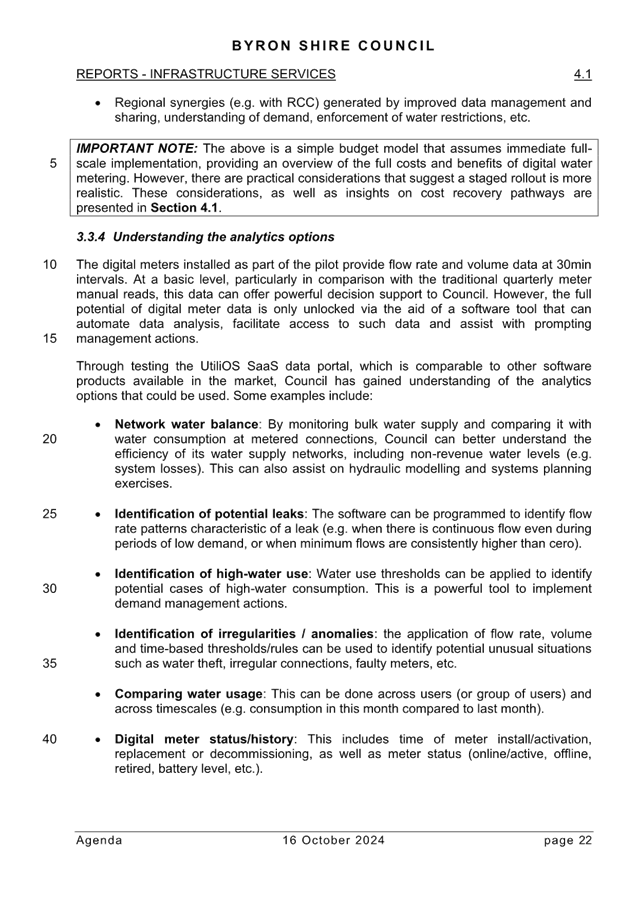

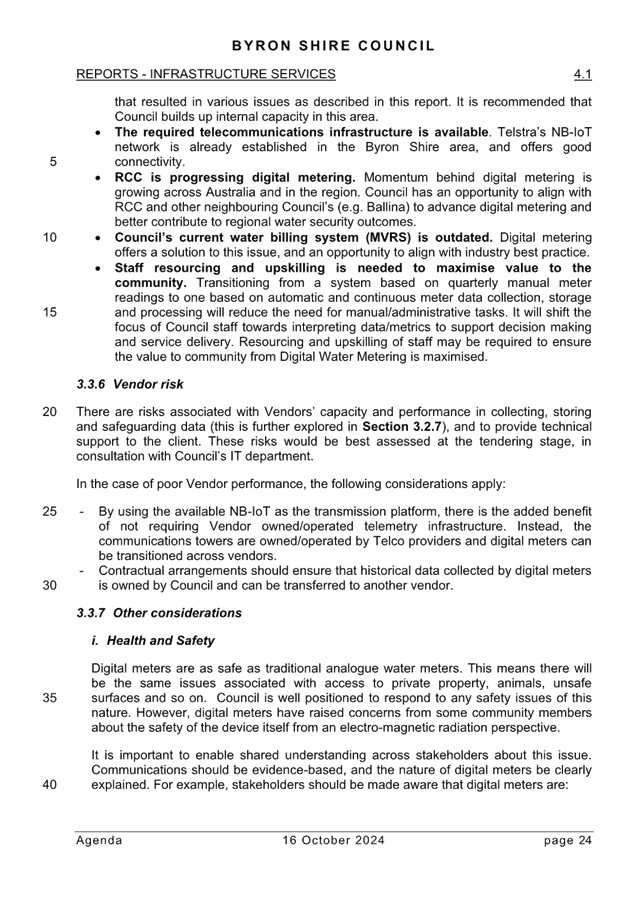





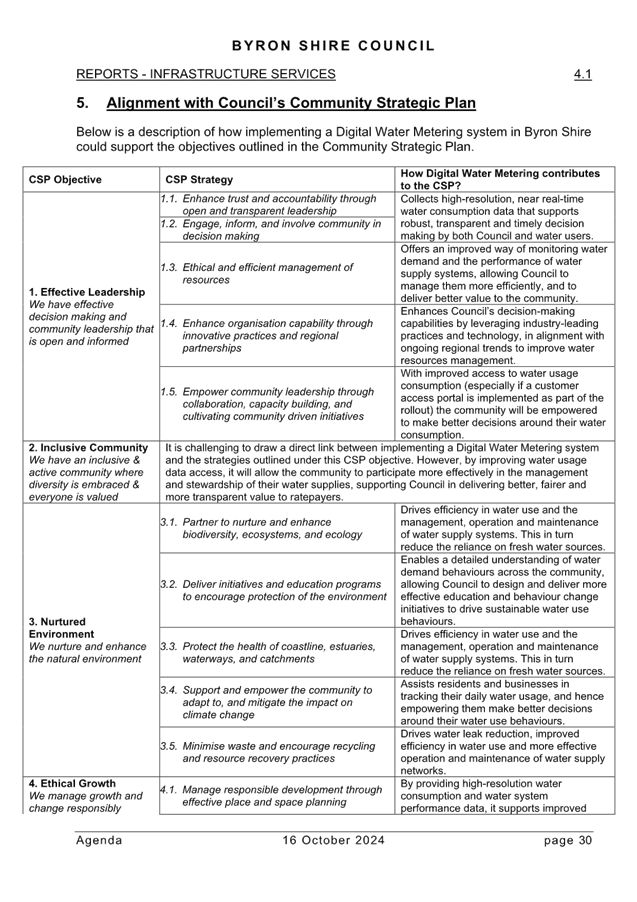
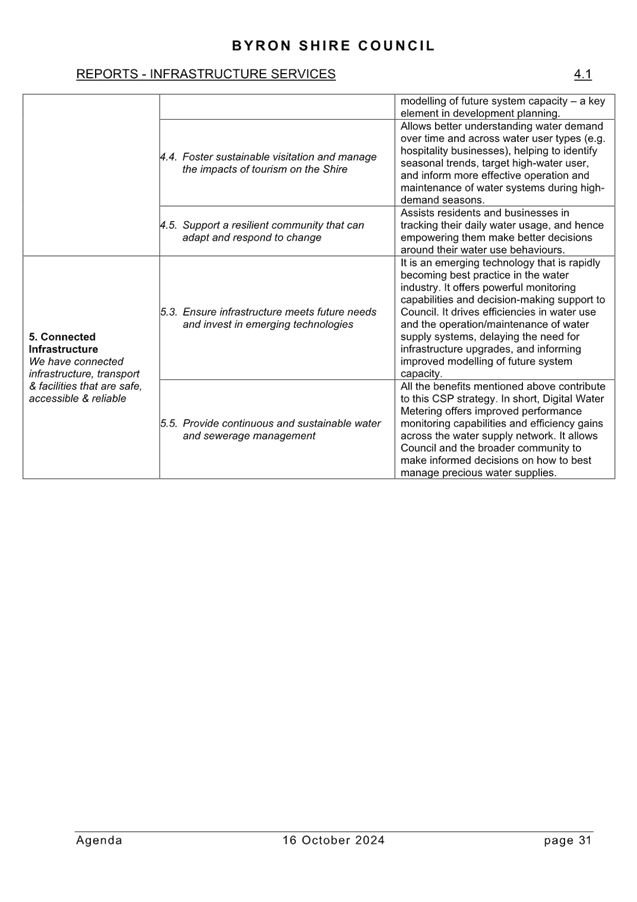
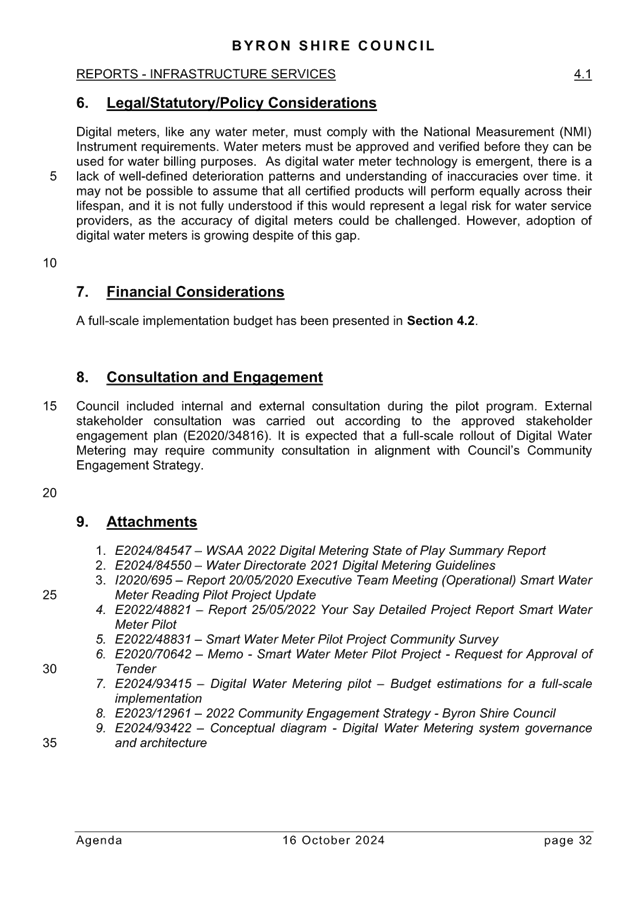
BYRON SHIRE COUNCIL
Staff
Reports - Infrastructure Services 4.1 - Attachment 2
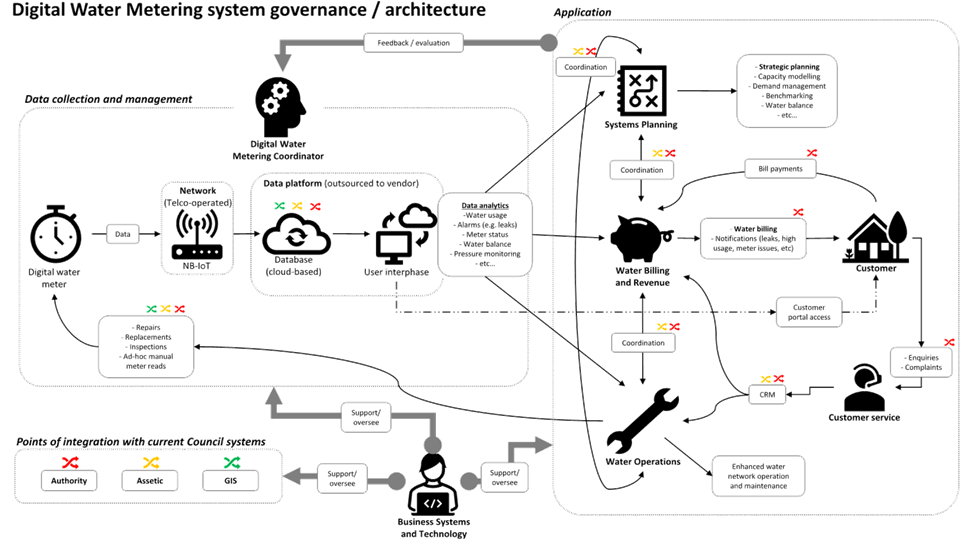
BYRON SHIRE COUNCIL
Staff
Reports - Infrastructure Services 4.1 - Attachment 3

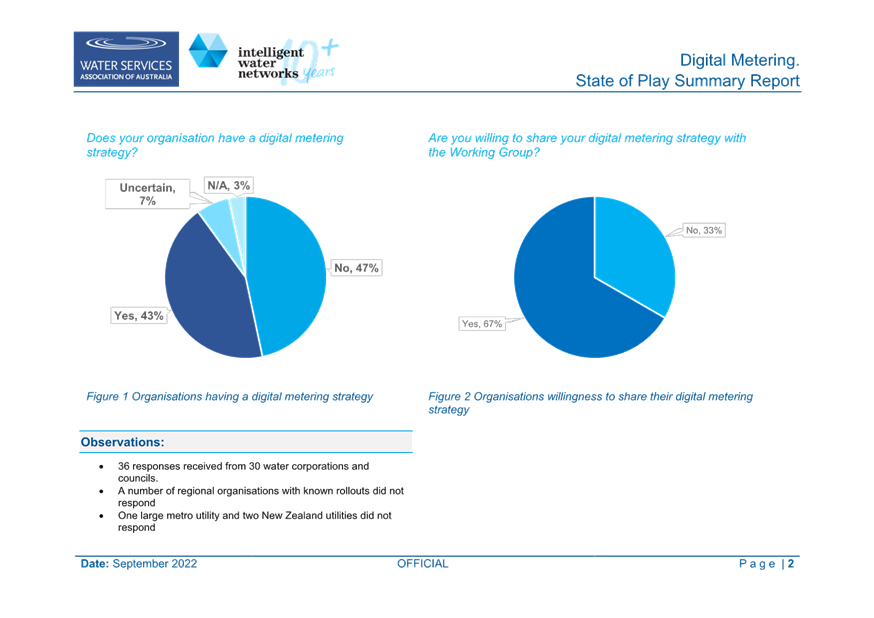



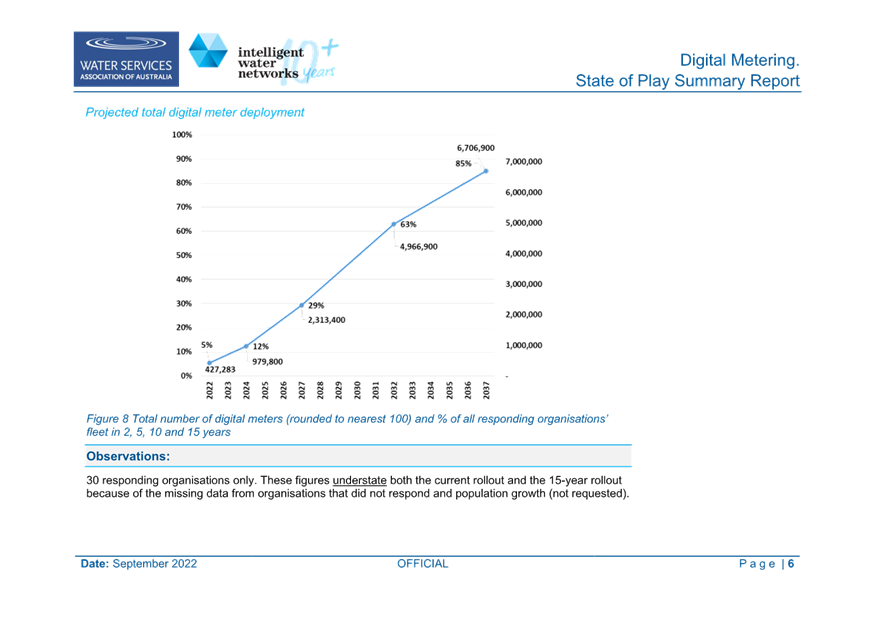
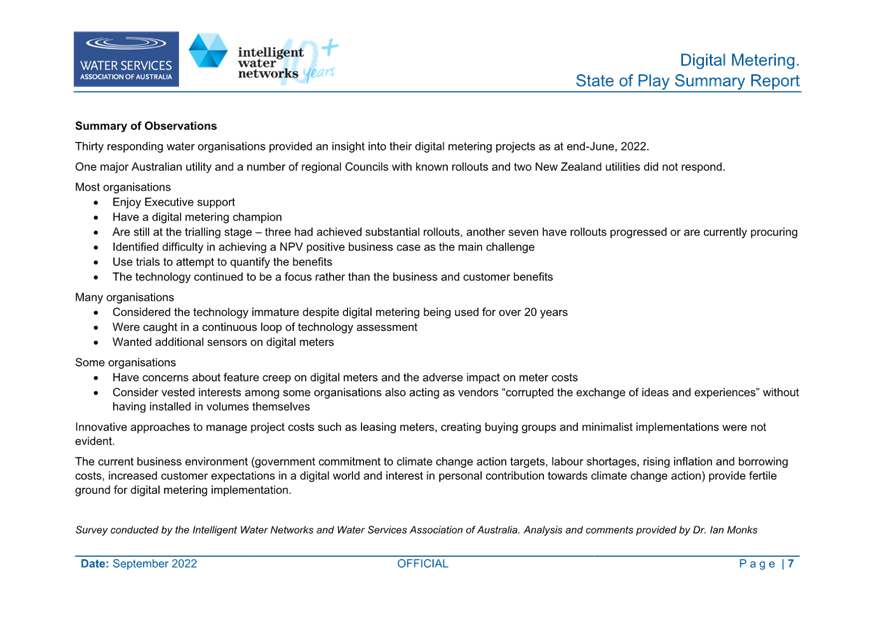
BYRON SHIRE COUNCIL
Staff
Reports - Infrastructure Services 4.1 - Attachment 4
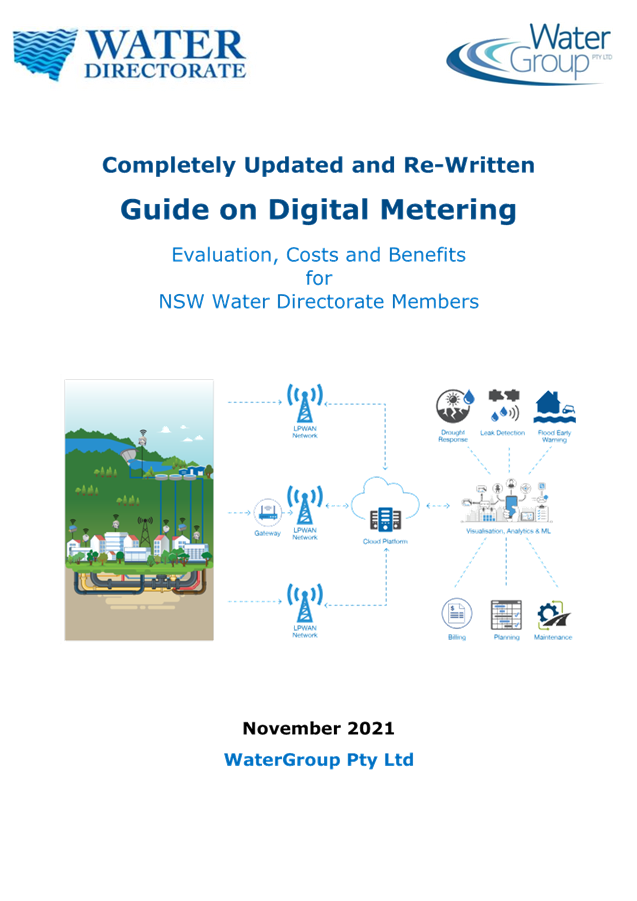

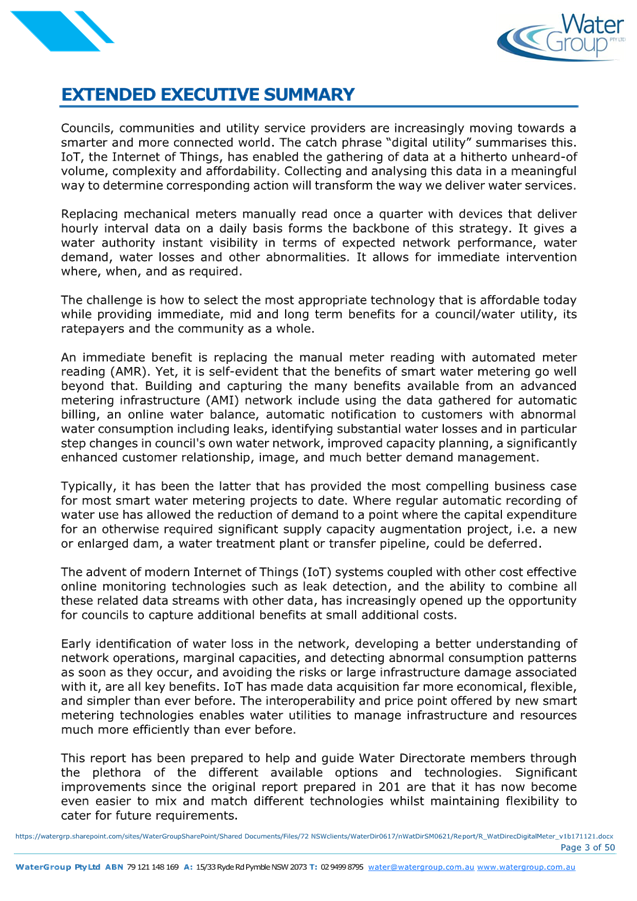

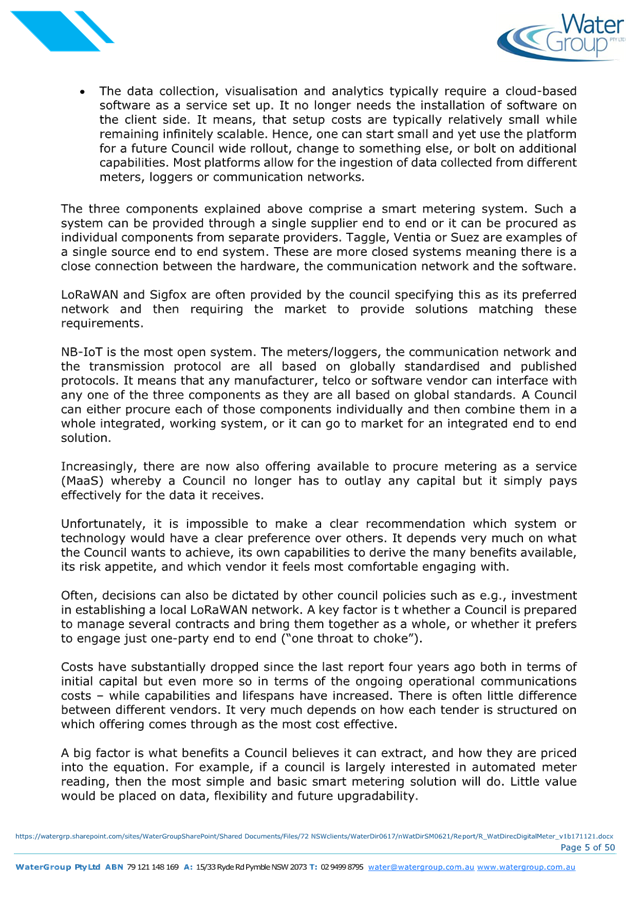
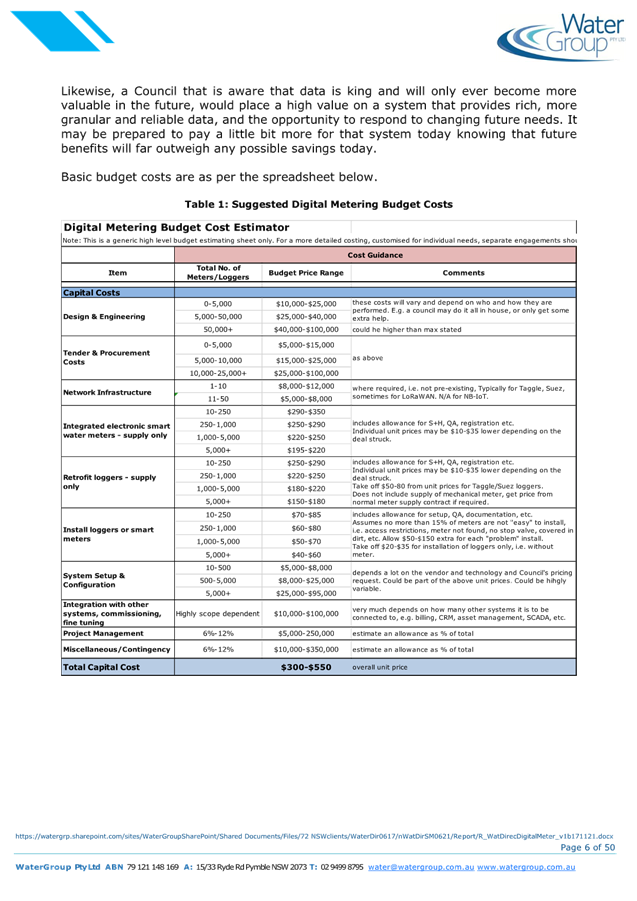

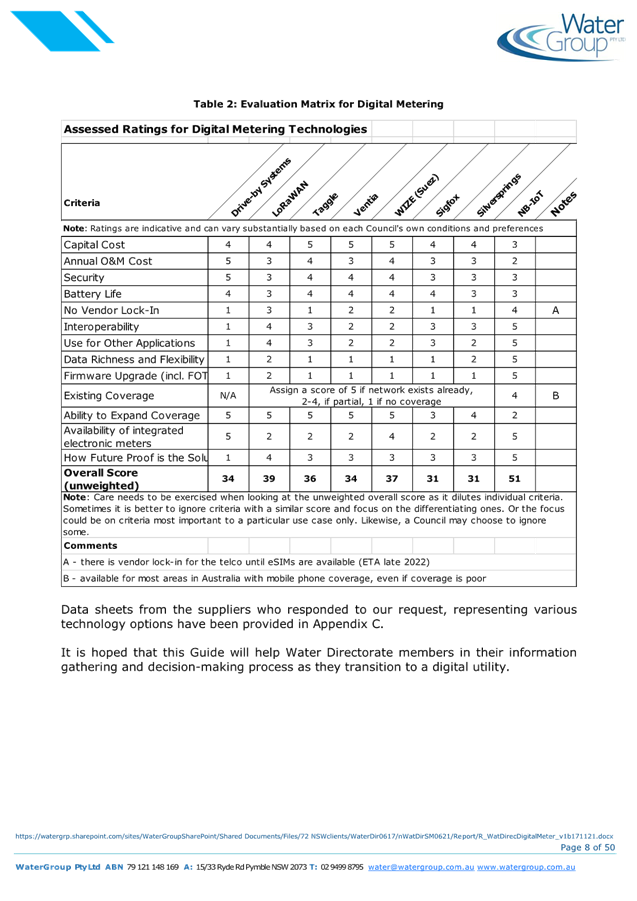
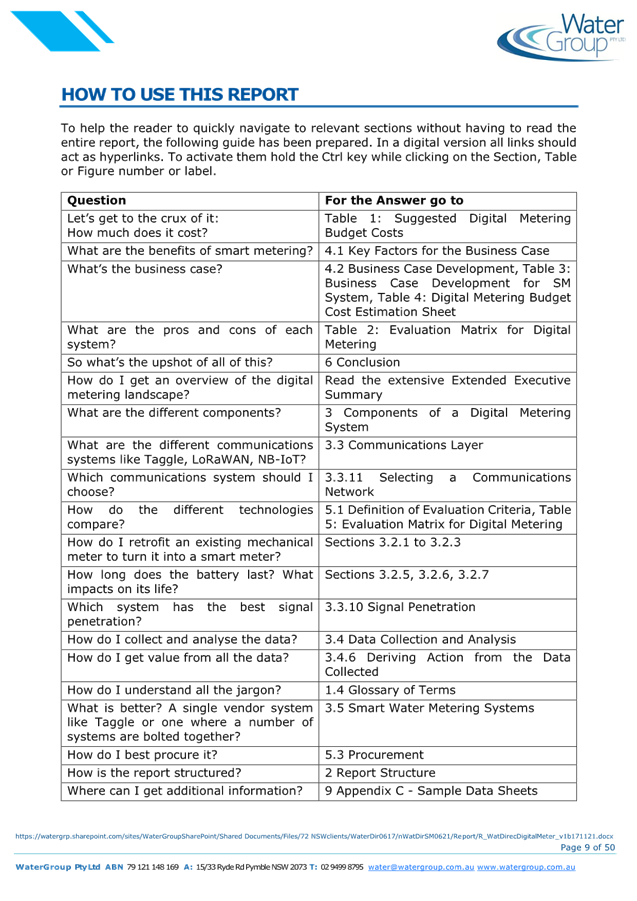
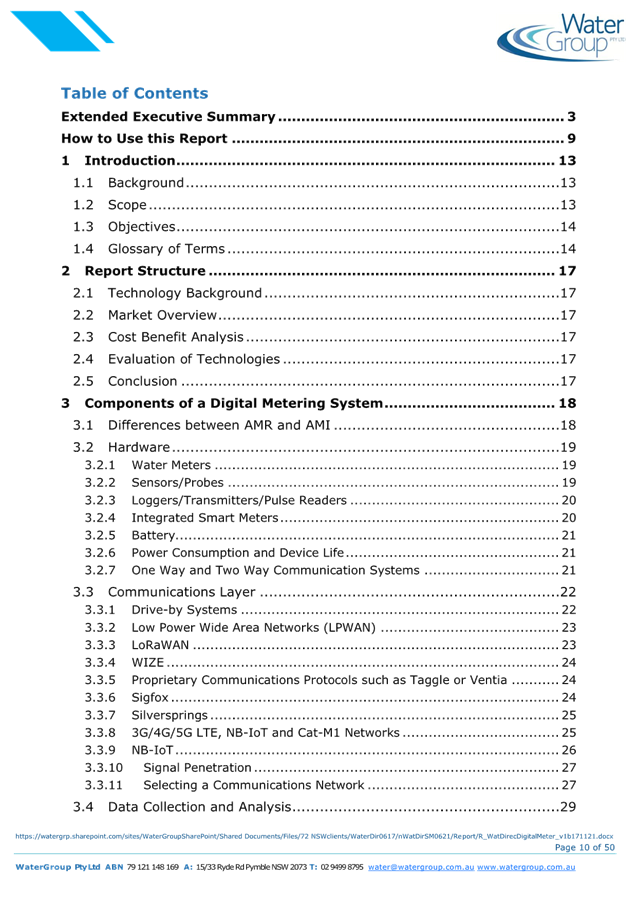
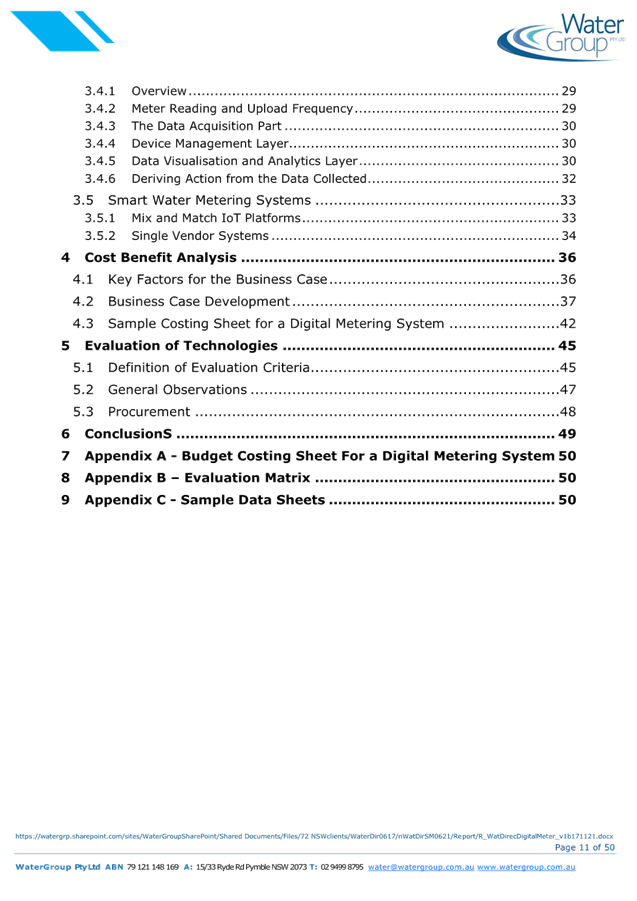

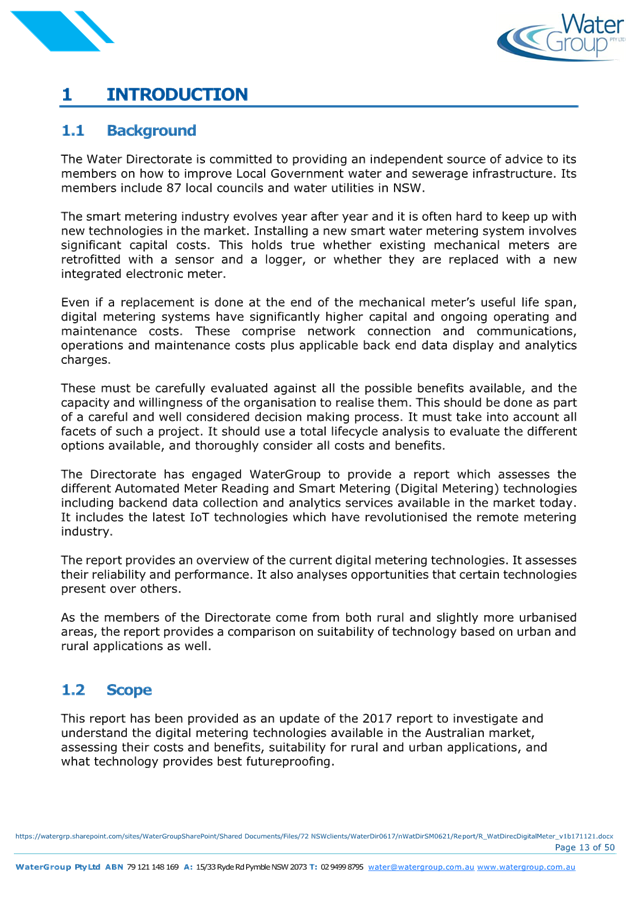
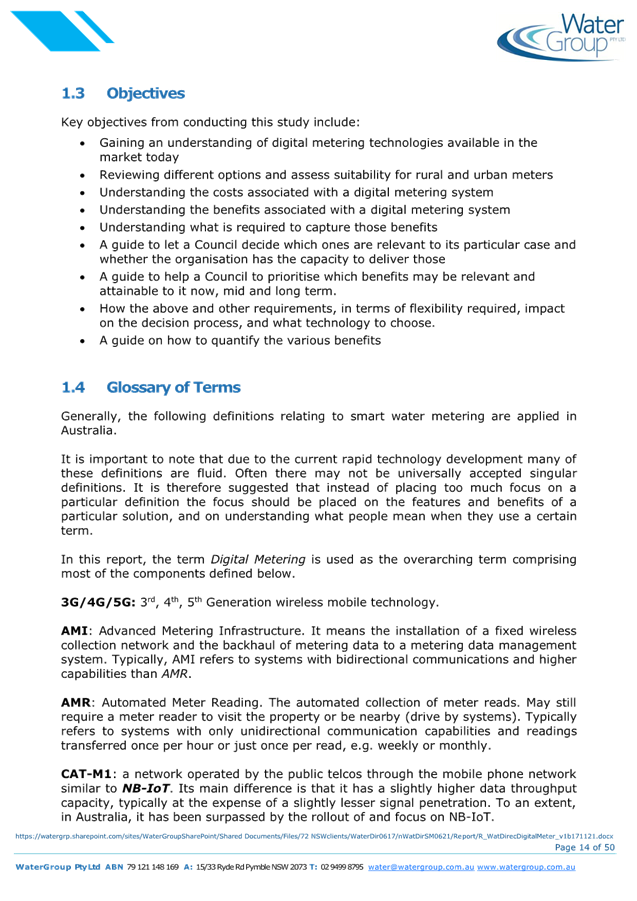

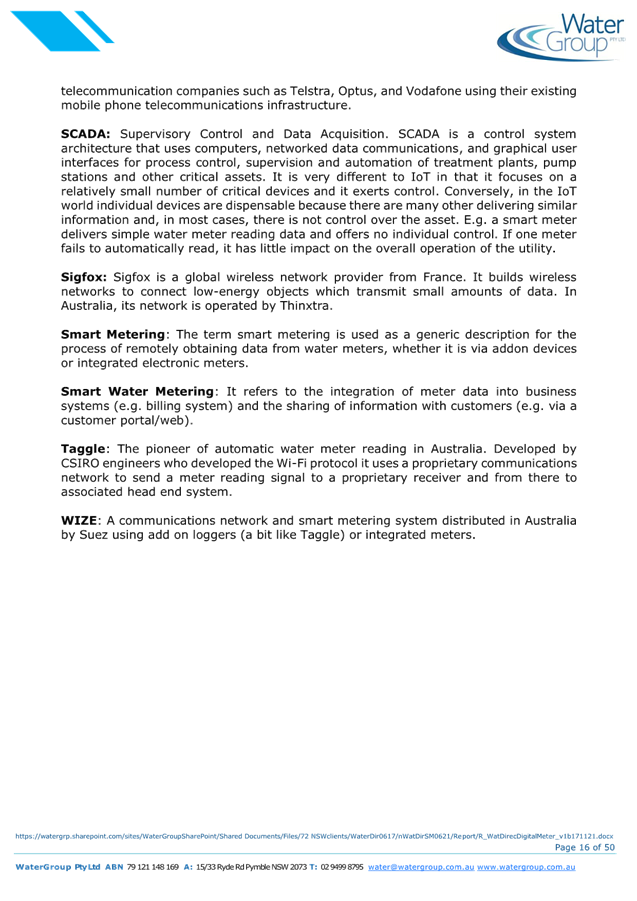
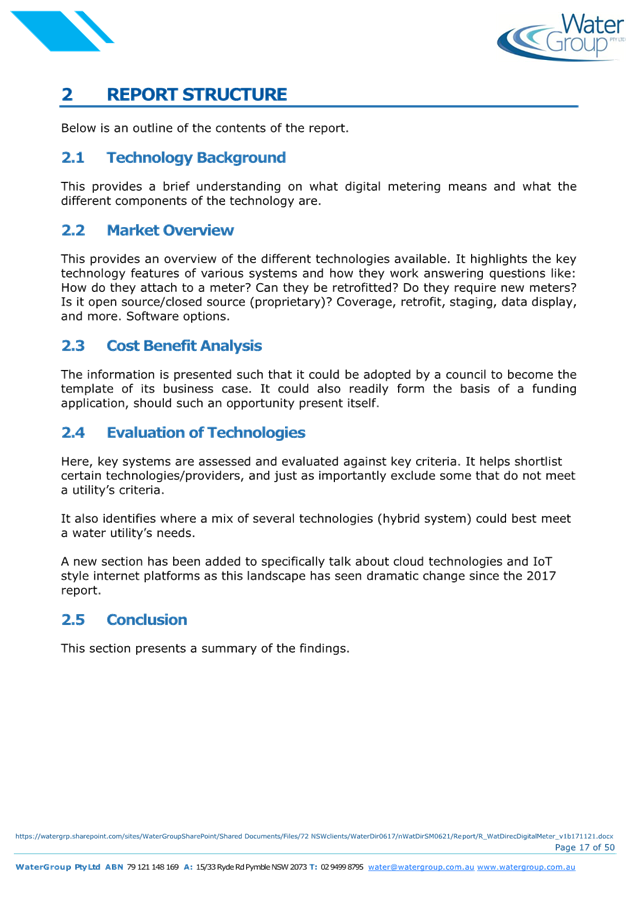

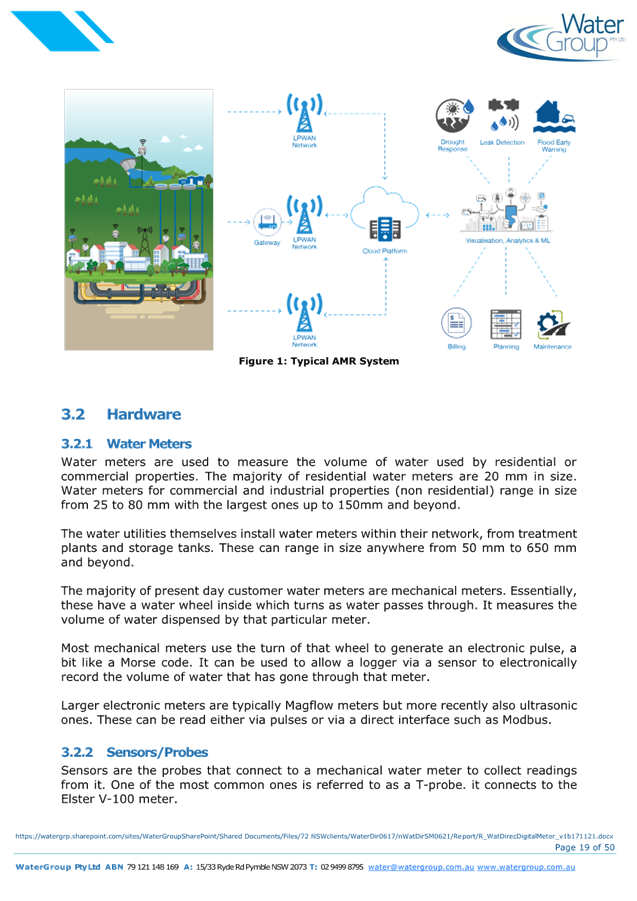

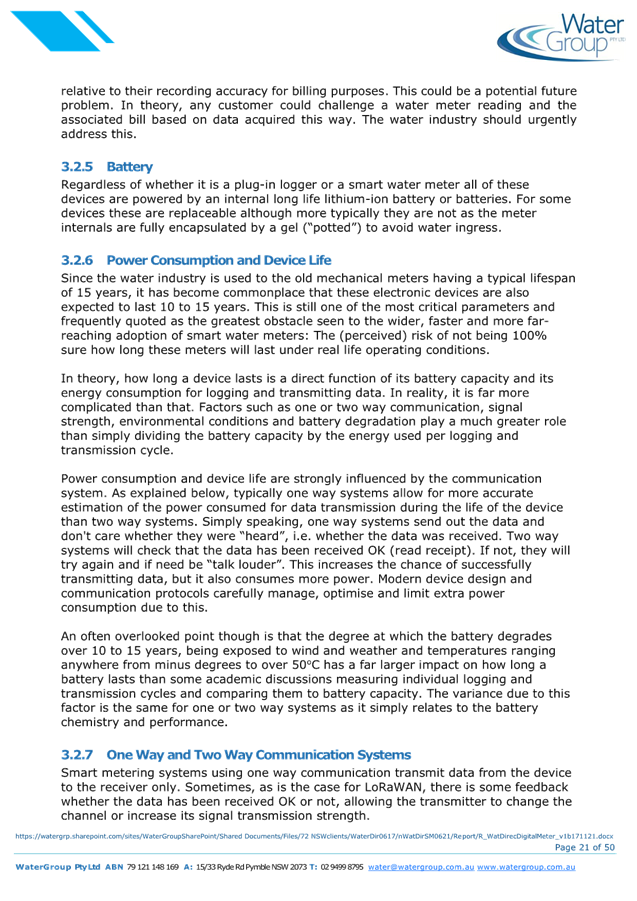
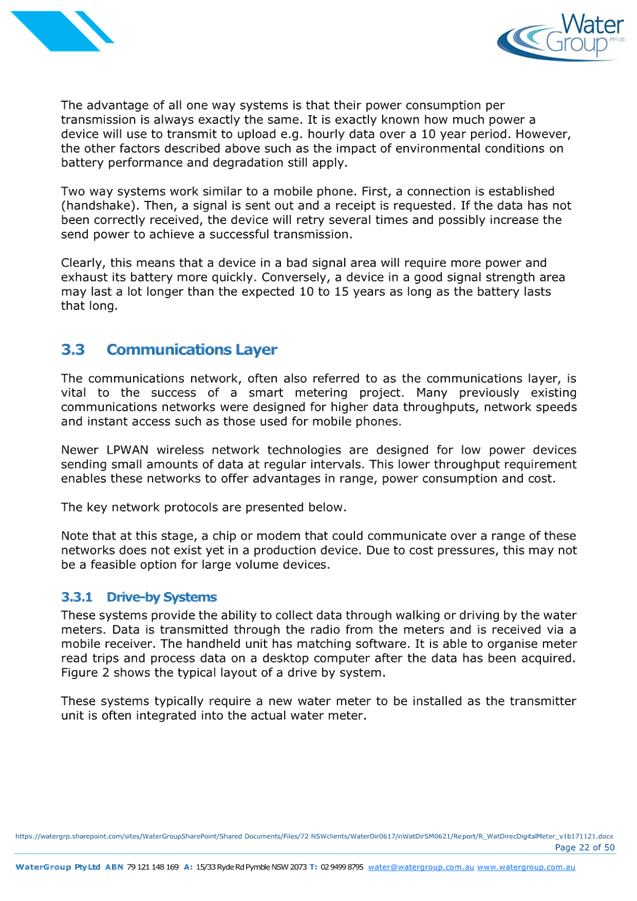

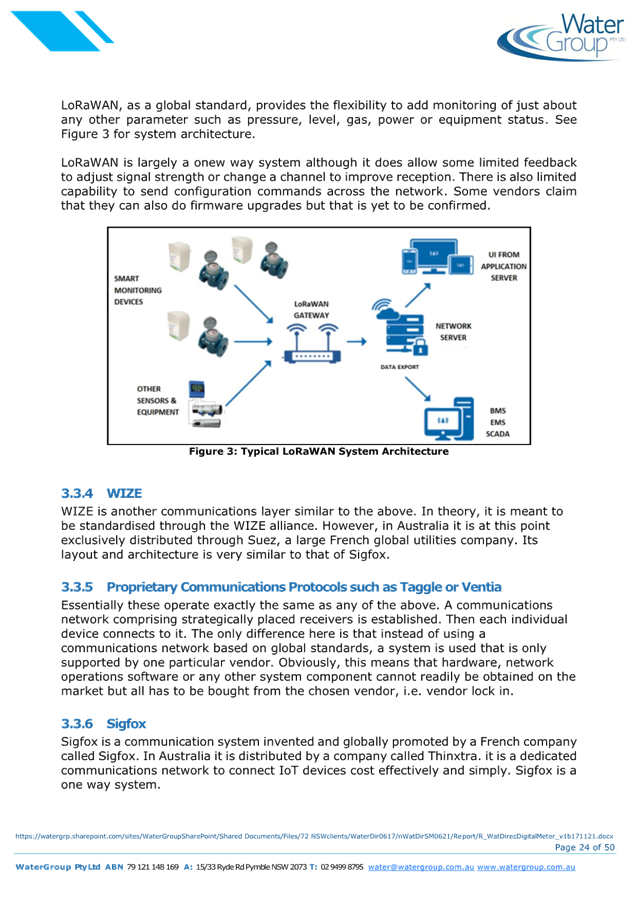
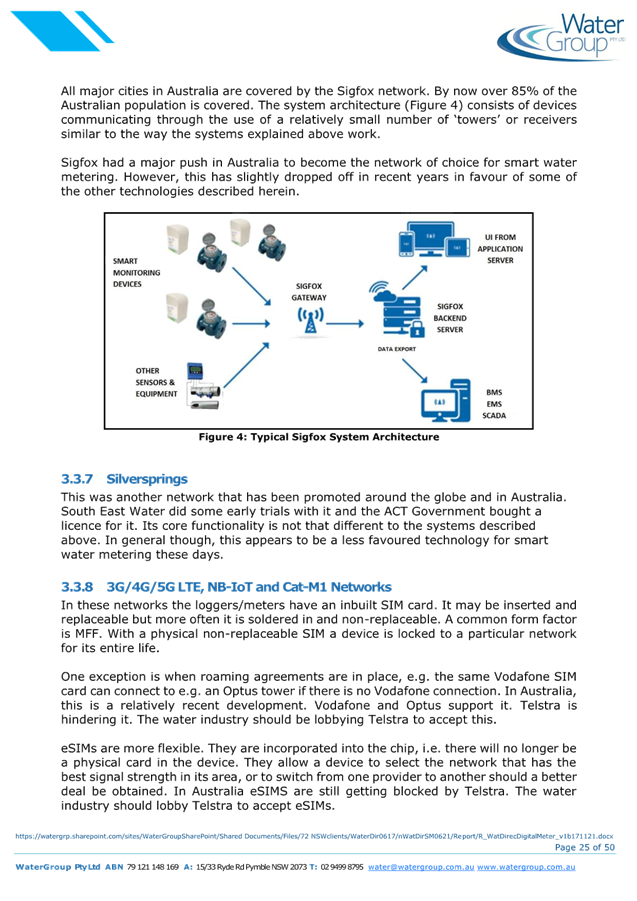


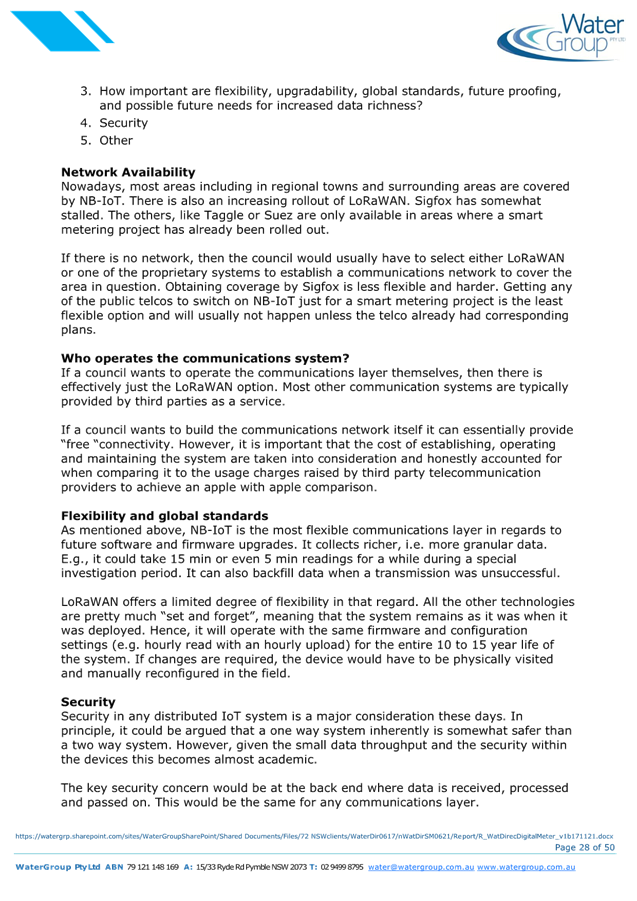
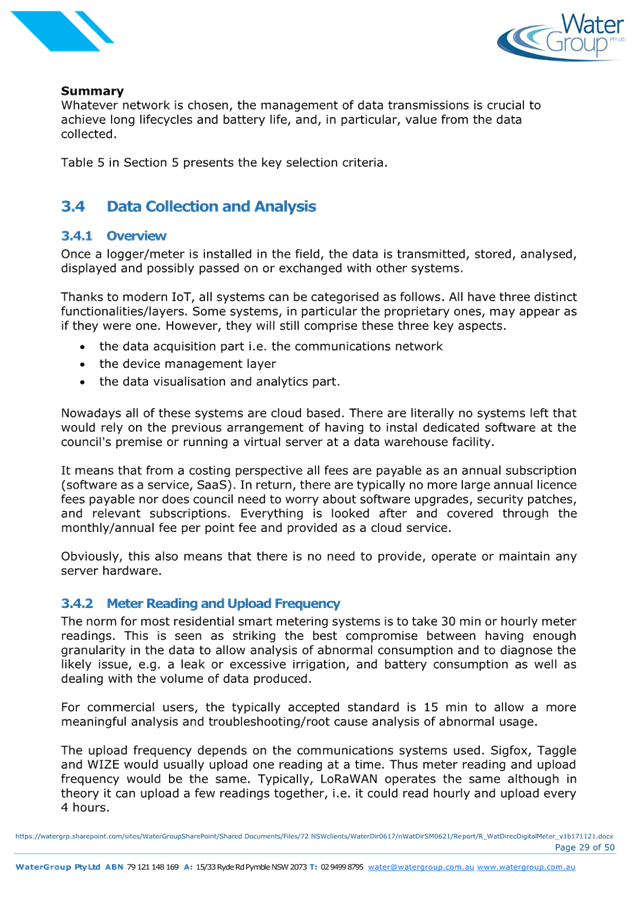
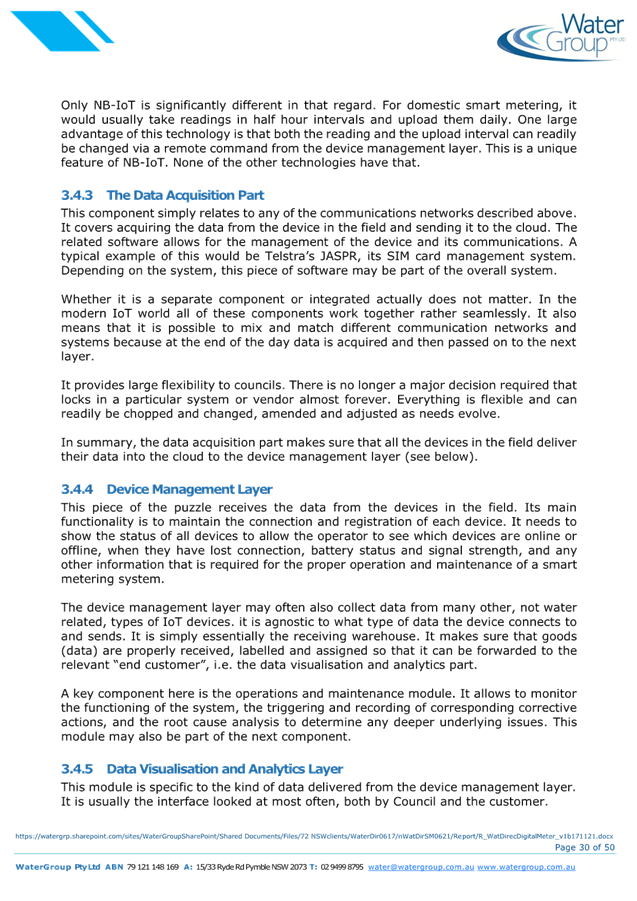
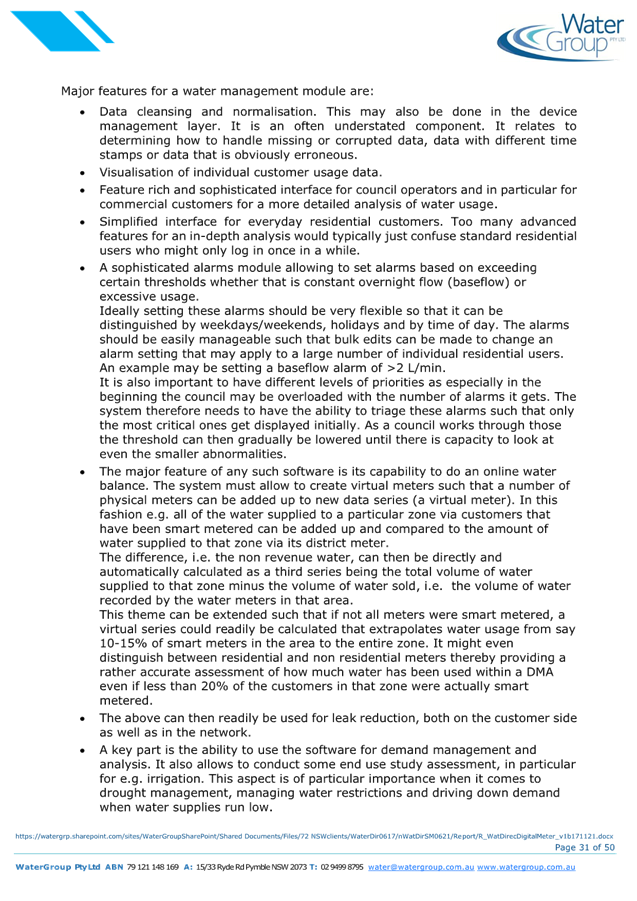
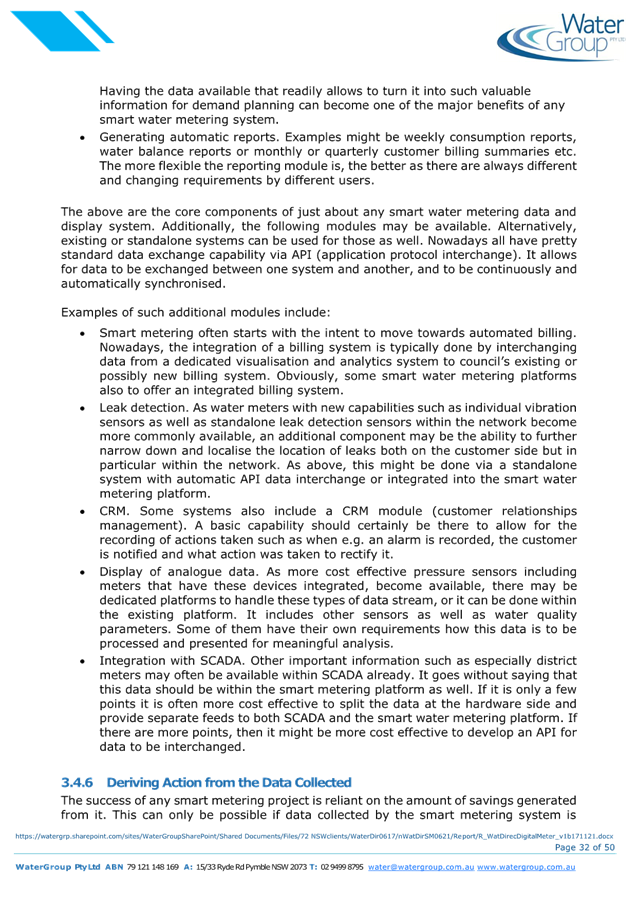

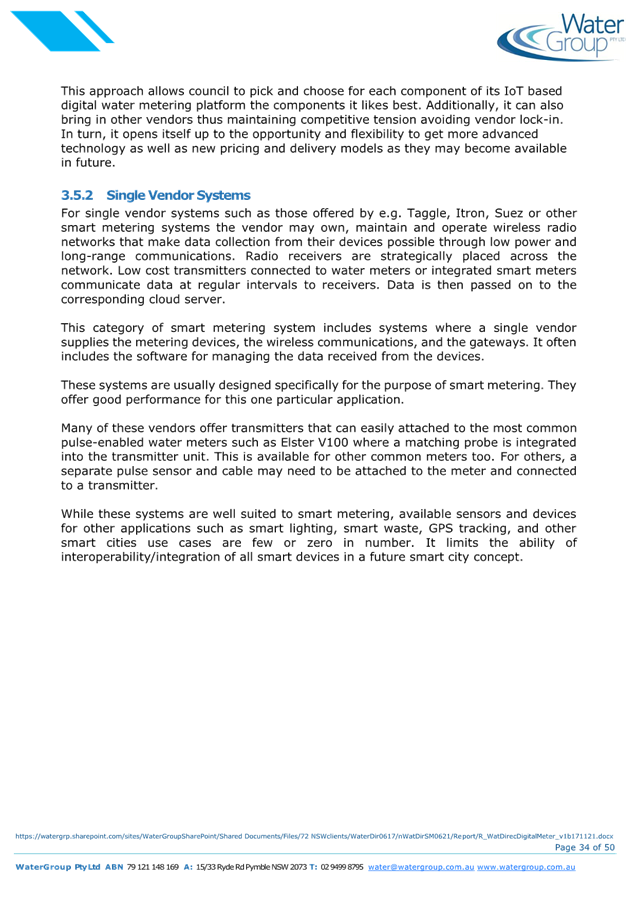
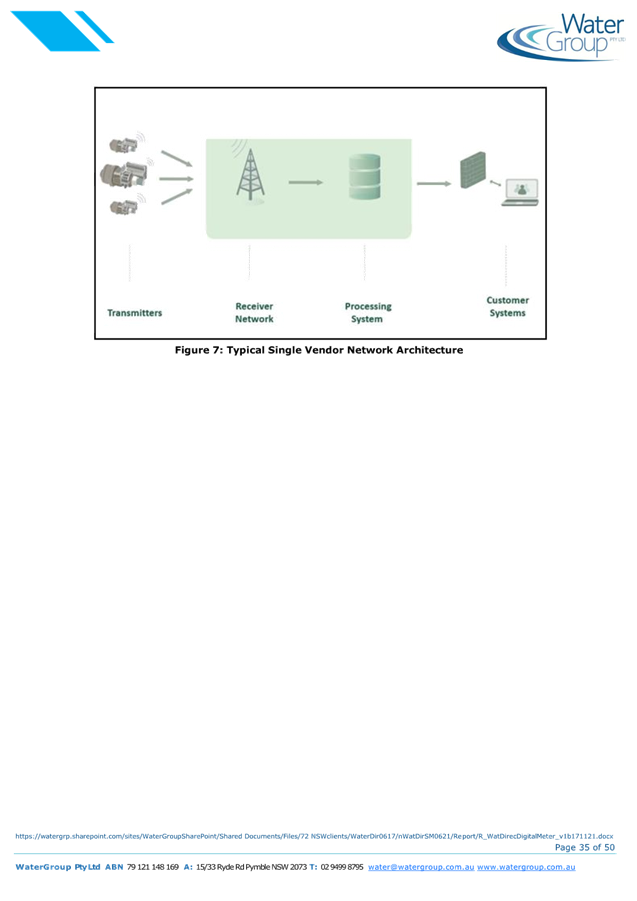
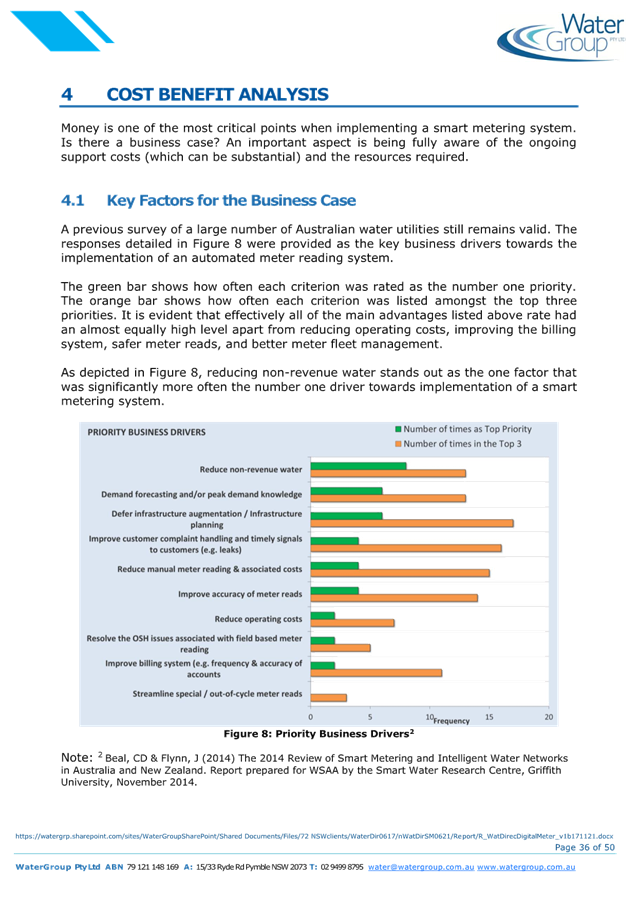
BYRON SHIRE COUNCIL
Staff
Reports - Infrastructure Services 4.1 - Attachment 5
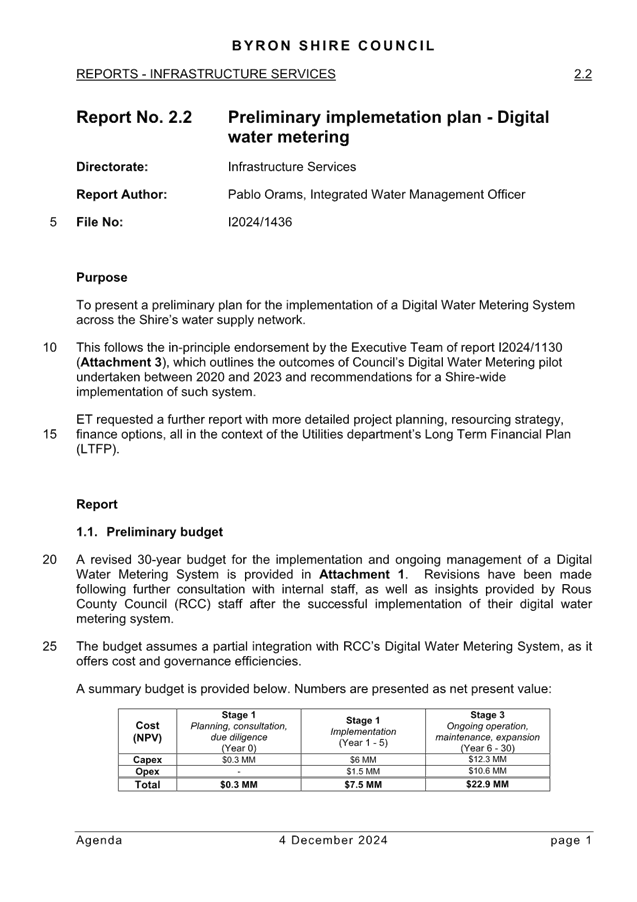

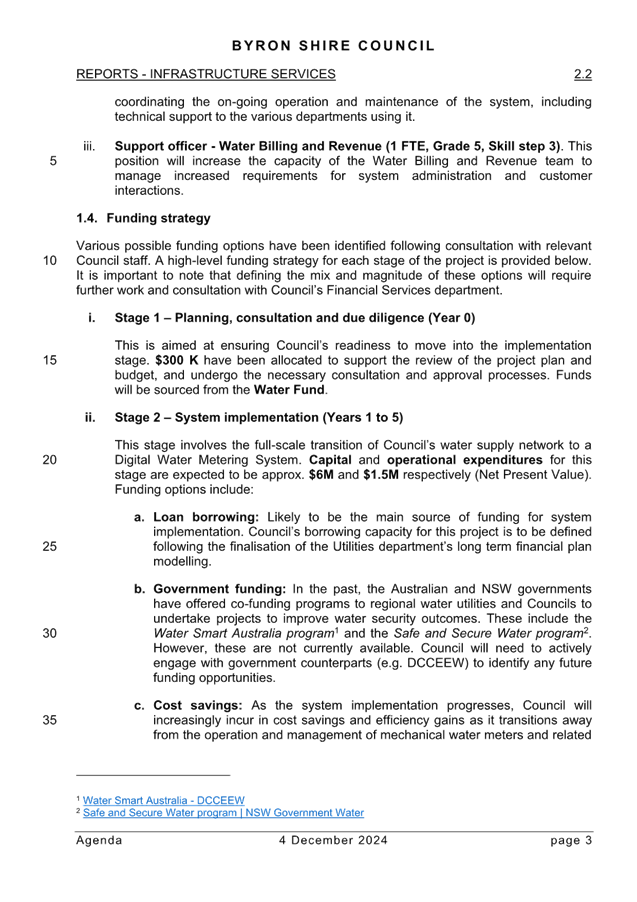
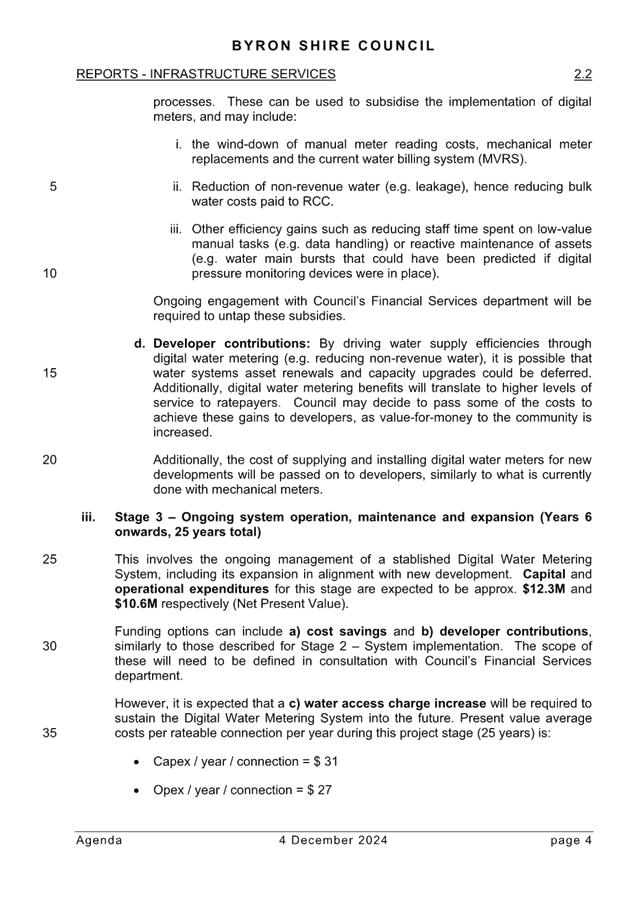

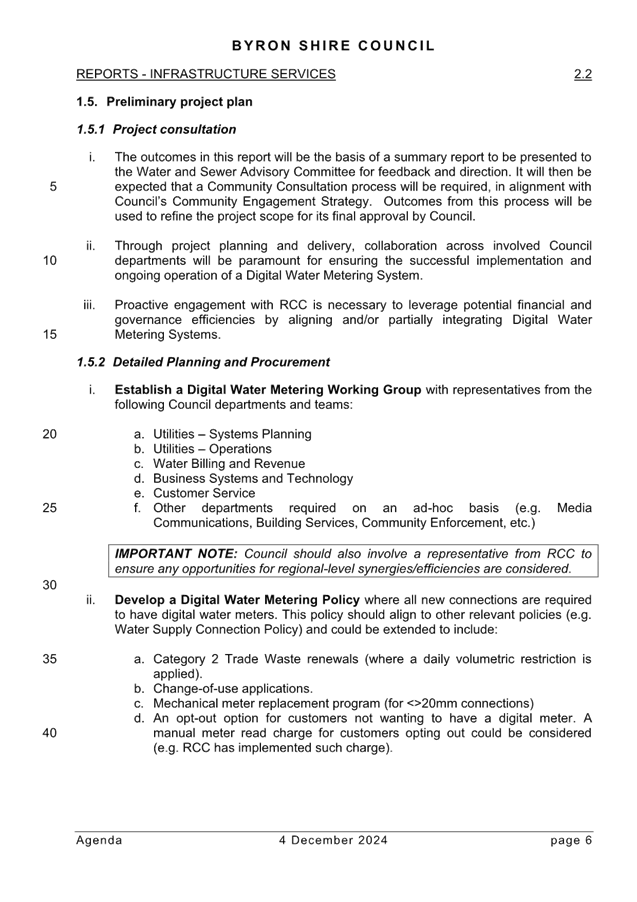

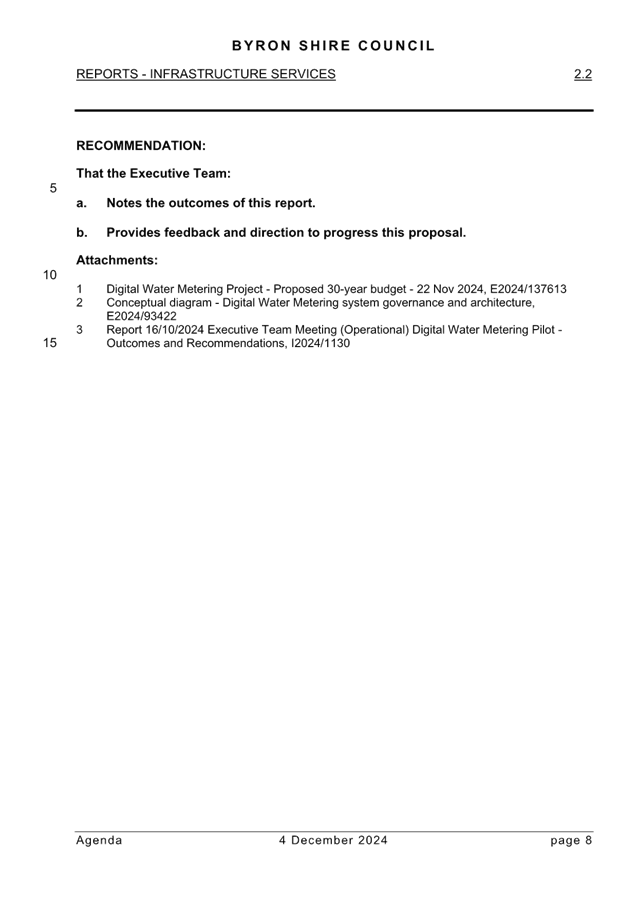
BYRON SHIRE COUNCIL
Staff
Reports - Infrastructure Services 4.1 - Attachment 6

BYRON SHIRE COUNCIL
Staff Reports - Infrastructure Services 4.2
Report No. 4.2 Ocean
Shores STP Transfer Line Update Report
Directorate: Infrastructure
Services
Report Author: Cameron
Clark, Manager Utilities
File No: I2025/860
Summary:
Council has resolved to proceed to detailed design for
infrastructure to transfer sewage flows from the OSSTP to the Brunswick Valley
STP (BVSTP) which will enable ‘load shedding’ to the BVSTP to help
relieve the dry weather loading at the OSSTP, particularly during peak holiday
seasons or during high wet weather flow conditions and reduce the risk of
environmental non-compliance.
Engineering multi criteria analysis and options assessment
was undertaken to identify the best location for transfer line. Alignment
2 was chosen as the best route, for minimal environmental, social, cultural,
financial, construction and operational requirements through a MCA process
(appendix a).
Environmental Planning including Heritage assessments have
been undertaken through different alignments, however Council requires final
stages of planning and heritage works to be completed for alignment 2 (Approx 6
months), prior to detailed design.
Council staff and field
experts recommend alignment two”,
as the preferred line utilising HDD construction technology (Appendix a).
Council staff to write to EPA
and inform EPA of project update and associated timeline.
RECOMMENDATION:
That the Water and Sewer Advisory Committee notes
the report.
Attachments:
1 GHD
MCA OSSTP Transfer, E2025/31880 ,
page 130⇩ 
Report
Background
Council resolved (Res 21-451) to proceed
to detailed design for infrastructure to transfer sewage flows from the OSSTP
to the Brunswick Valley STP (BVSTP) which will enable ‘load
shedding’ to the BVSTP to help relieve the dry weather loading at the
OSSTP, particularly during peak holiday seasons or during high wet weather flow
conditions and reduce the risk of environmental non-compliance.
On 14 December 2023 council resolved to adopt the WSAC
recommendations for council staff to start project initiation for Option 4R-
for the partial transfer of sewage flows from the OSSTP to the BVSTP.
The project
will involve the acquisition and establishment of a new easement underneath two
properties between the OSSTP and the BVSTP,
• As
adopted in the council resolution, Option 4R includes minor upgrades at the
OSSTP and BVSTP to facilitate the transfer of sewage via the new pipeline
and options for construction with and without a wet weather balancing
pond.
• The
proposed alignment maintains assets within BSC controlled land.
• The
project is being monitored by the EPA and project attached to EPA licence.
• Upon
completion planning approvals, detailed design and tender documentation will be
prepared for construction which will require a range of insurance provisions in
accordance with the NSW public Works MW 21 or GC21 form of contract.
Program
Timeline
|
Date
|
Title / Description
|
|
23 Oct 2024
|
GHD were engaged to undertake an MCA of the proposed
pipeline routes between the OSSTP and BVSTP to consider the efficiencies in
the pipeline design that may be gained by using HDD technology. Previously
the preferred route was selected on the assumption that the primary method of
construction would be open trench excavation (OTE)
|
|
24 Oct 2024
|
A site visit was undertaken by key stakeholders
from the design team (GHD), the planning consultant and two industry experts
in consultation with BSC personnel to inspect the BVSTP, OSSTP and walk the
proposed pipeline routes.
|
|
12 Nov 2024
|
Five draft pipeline alignment options were developed
for consideration with the MCA (refer attached PDF). These options are
based on a combination
of OTE and HDD construction methodologies. HDD has been used across
difficult terrain and OTE used where terrain is less constrained
|
|
26 Nov 2024
|
MCA matrix developed including the
assessment criteria and weightings
|
|
3 Dec 2024
|
Pipeline alignment options finalised in
consideration of key stakeholder comments and maps sent to two industry
experts to develop indicative cost estimates for the alignments, and to
provide details of construction requirements and challenges for input into
the MCA
|
|
12 Dec 2024
|
Planning and environmental advice received from
consultant incorporated into the MCA document
|
|
20 Dec 2024
|
Indicative pricing advice received from industry experts
for input into the MCA Report
|
|
6 -20 Feb 2025
|
Indicative pricing advice and final comments
from key stakeholders incorporated into the MCA Report
|
|
20 -24 Feb 2025
|
MCA report and recommendations submitted to the
BSC Sewer and Water Management Team for review before being presented to the
BSC Executive Team for consideration and approval to proceed.
|
|
30 May 2025
|
Forecast date for the receipt of approval to
proceed from the BSC Executive Team
|
Risk
A Multi Criteria Analysis (MCA) was undertaken of five
potential pipeline alignment options. These options are based on a
combination of Open Trench Excavation (OTE) and Horizontal Directional Drilling
(HDD) construction methodologies. HDD has been used across difficult
terrain and OTE used where terrain is less constrained. The risk-based
analysis was undertaken in consultation with the planning, heritage and
construction specialists
Planning Approvals Update
Minor upgrades of both the OSSTP and the BVSTP are
anticipated to be required to address the existing operational issues and
process bottlenecks, and the construction of a wet weather storage facility
will be required at the BVSTP to cater for receival and balancing of the
increased peak wet weather flows. An update on environmental assessments
and planning approvals is as follows:
The Environmental and Heritage Planning consultant will be
requested to update the Aboriginal cultural heritage assessment with the new
approach as follows:
· Undertake the
investigations/ consultation required to update the ACHAR with the alternative
pipeline route – assumed to be alignment 2.
The biodiversity assessment will also be finalised with the
preferred pipeline route and location of the BVSTP balancing pond.
Once the final alignment is approved it is proposed that the
approvals process (including Part 5 and REF) would run in parallel with the
detailed design.
Heritage
The Aboriginal Cultural Heritage
Assessment Report (ACHAR) has progressed, however, further work still required
for alignment 2.
Council have assumed that the adopted HDD route and new
BVSTP balancing pond site will not impact on cultural heritage. However,
assessments are still being carried out.
This is expected to take 14 weeks including the required RAP
consultation. Council to arrange the required access to private property
and any resident consultation.
Next Steps
1. The
Project team proceeding forward with the recommended route alignment and
complete the following: -
a. Environmental
assessment and
b. Landholder
consultation
Once stages a and b are complete, Council
will then undertake detailed design prior to going to construction.
Strategic Considerations
Community Strategic Plan
and Operational Plan
|
CSP Objective
|
CSP Strategy
|
DP Action
|
Code
|
OP Activity
|
|
5:
Connected Infrastructure
|
5.5:
Provide continuous and sustainable water and sewerage management
|
5.5.2:
Wastewater management - Manage effluent in an ecologically sustainable way
that ensures public health and protects and enhances the natural environment
|
5.5.2.11
|
Ocean Shores transfer to
Brunswick Valley Sewerage Treatment Plant - process elements and transfer
pipeline
|
Financial Considerations
Cost: Design cost estimates as follows:
1. OSSTP upgrade- $9mil
minimum upgrade – (design cost $398,000)
2. BVSTP upgrade and
augmentation including 20ML wet weather storage facility $16.4mill cost
estimate (design cost- $200,000)
3. New HDD pipeline –
($15mil cost estimate) – (Geotech, survey, Design verification, review
and optioneering - $185,000).
Note: Cost of design for transfer
pipeline of $200,000 is in the budget for next OP/FY.
Consultation and
Engagement
|
Who was
consulted?
|
How did
consultation occur? e.g. email, verbal etc
|
Comments/Feedback
|
|
EPA
|
Updates on project progress has been communicated to the
EPA via memos on 10 Sep 2024 and 24 Dec 2024
|
No formal response received, other than acknowledgement.
|
|
Potential effected landholders
|
Preliminary discussions have been held with potential
effected landholders for all MCA options reviewed
|
Request to meet on site to review the full scope of this
project and what is involved in installation and ongoing inspections and
maintenance
|
|
SEE Environmental Team
|
Phone and email correspondence
|
Approved environmental planning and systems process
|
|
Water and Sewer Advisory Committee
|
Report
|
Ongoing feedback throughout the project lifecycle
|
BYRON SHIRE COUNCIL
Staff
Reports - Infrastructure Services 4.2 - Attachment 1
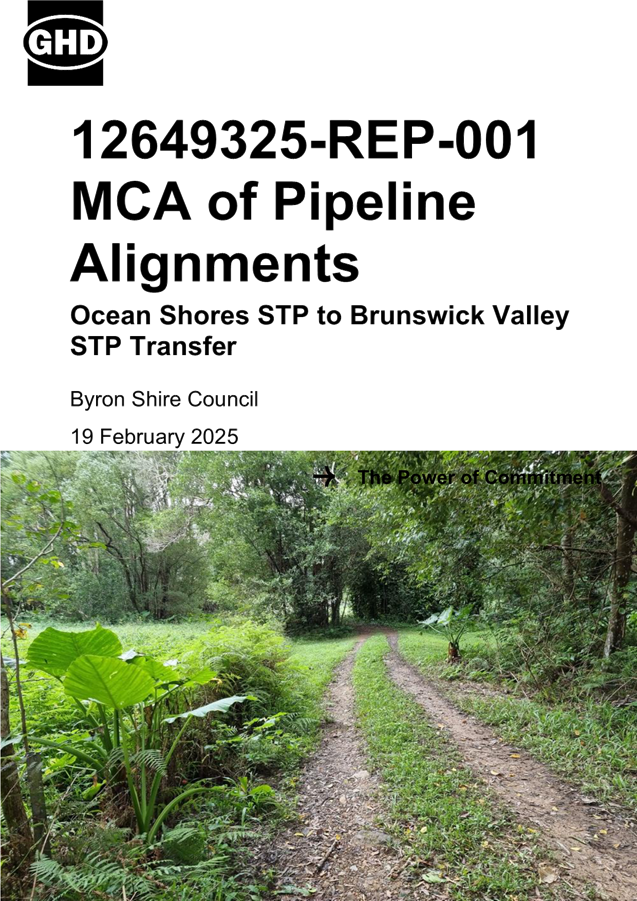

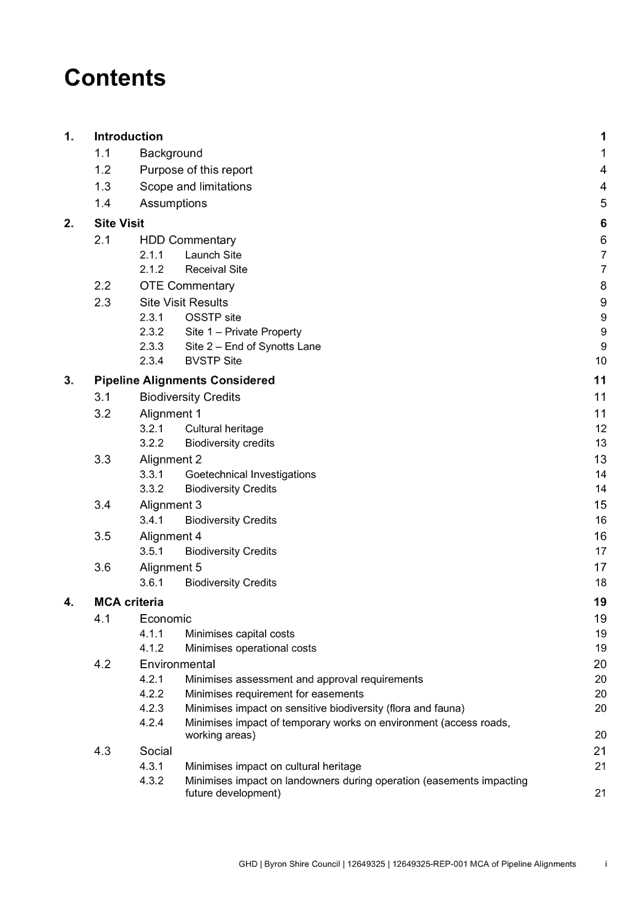
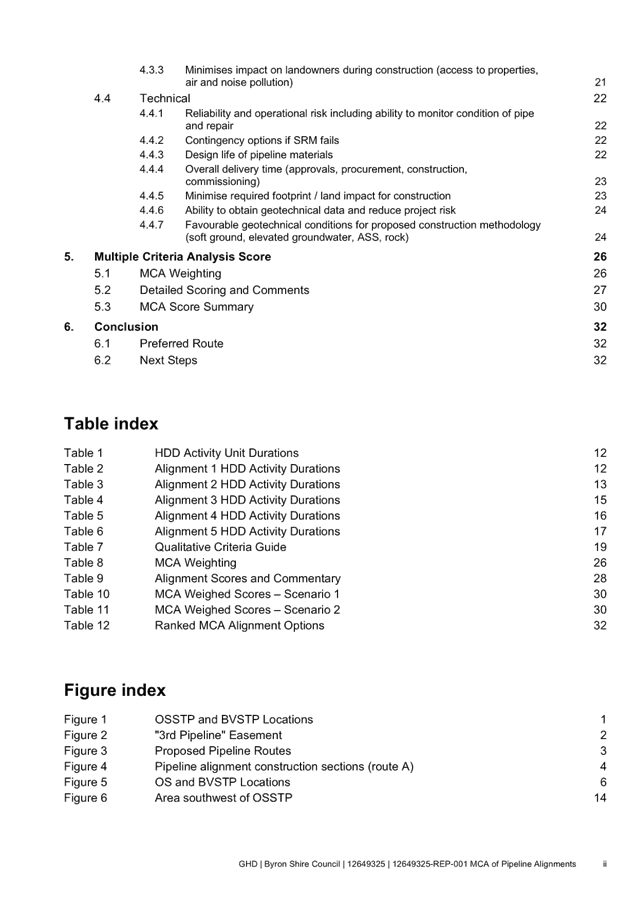
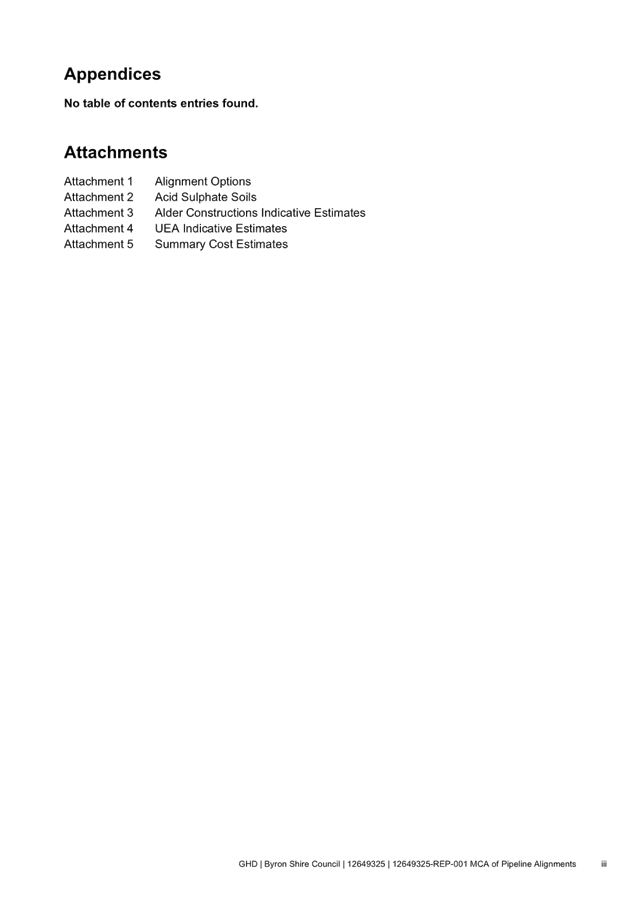
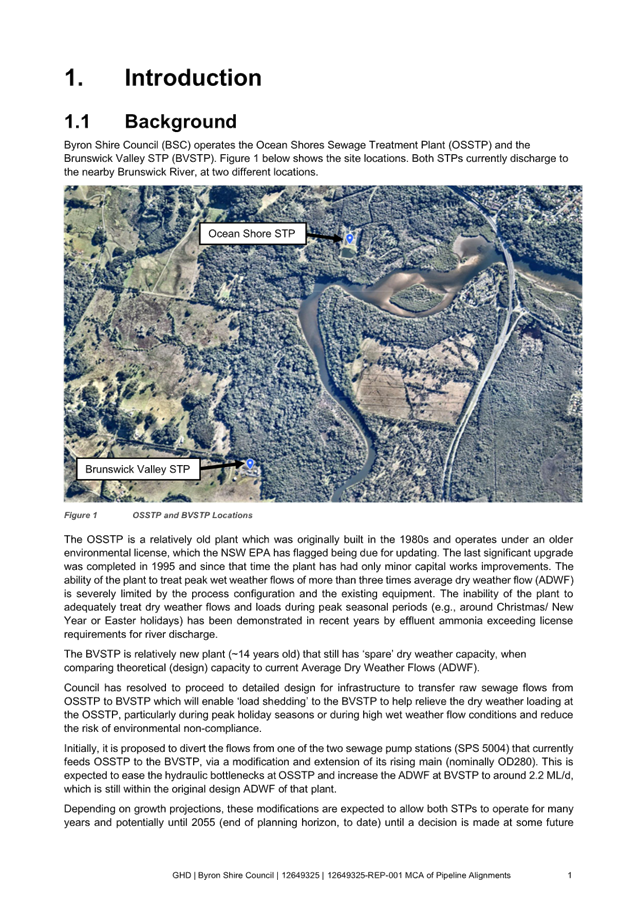
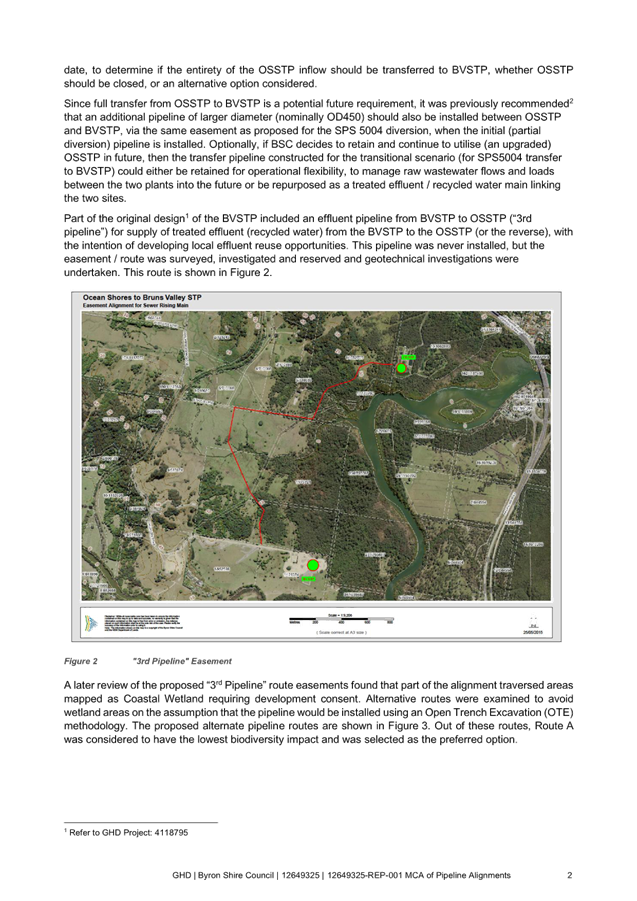
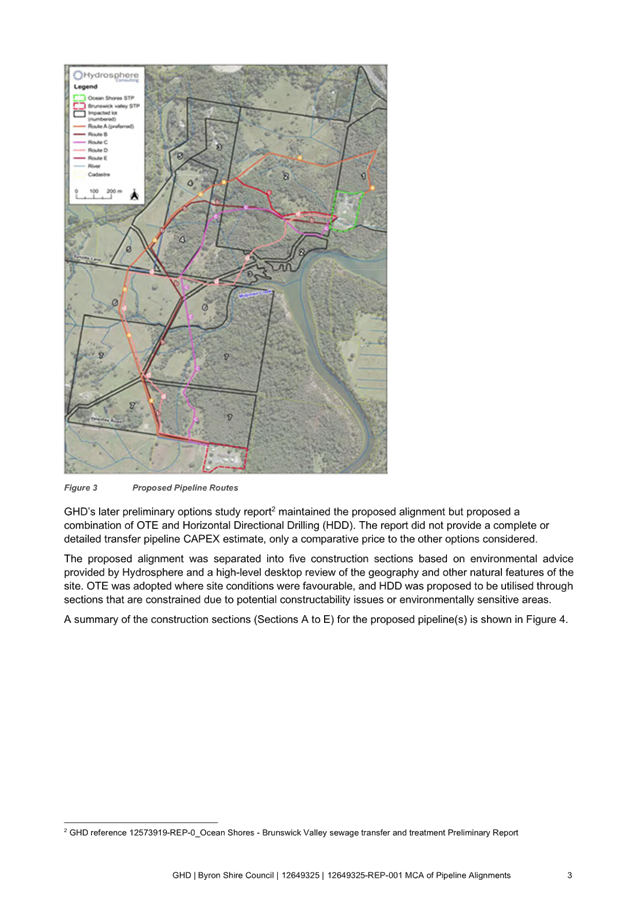
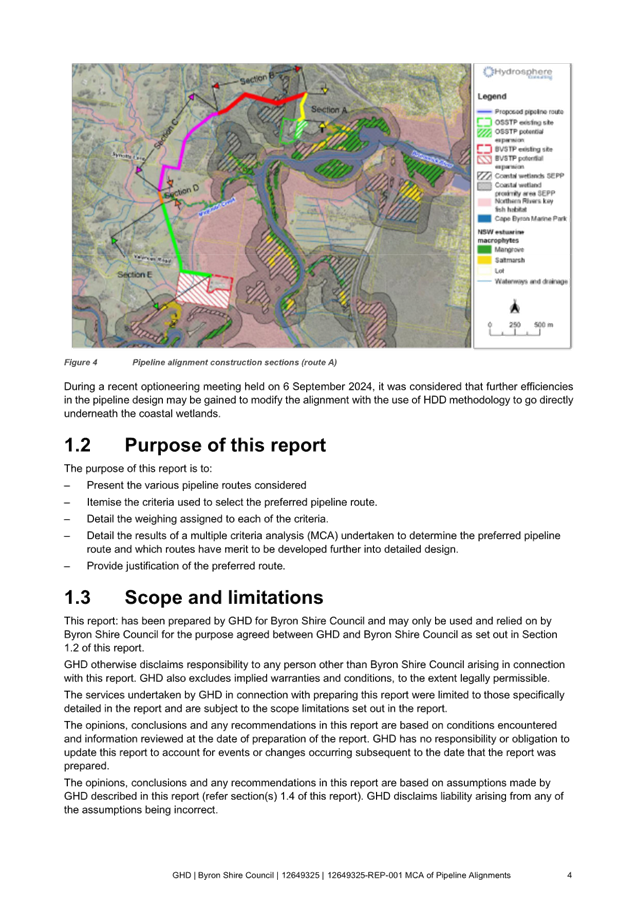
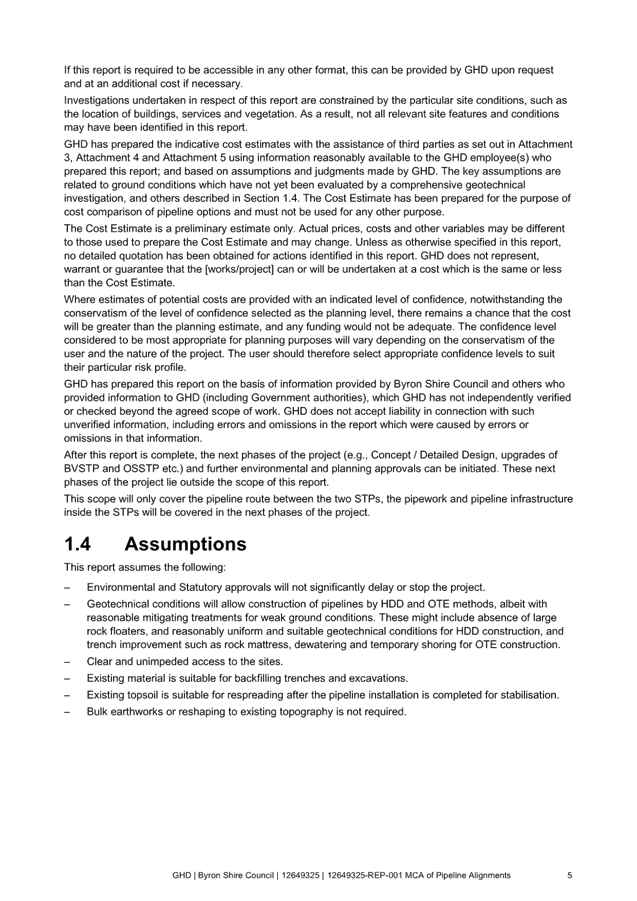
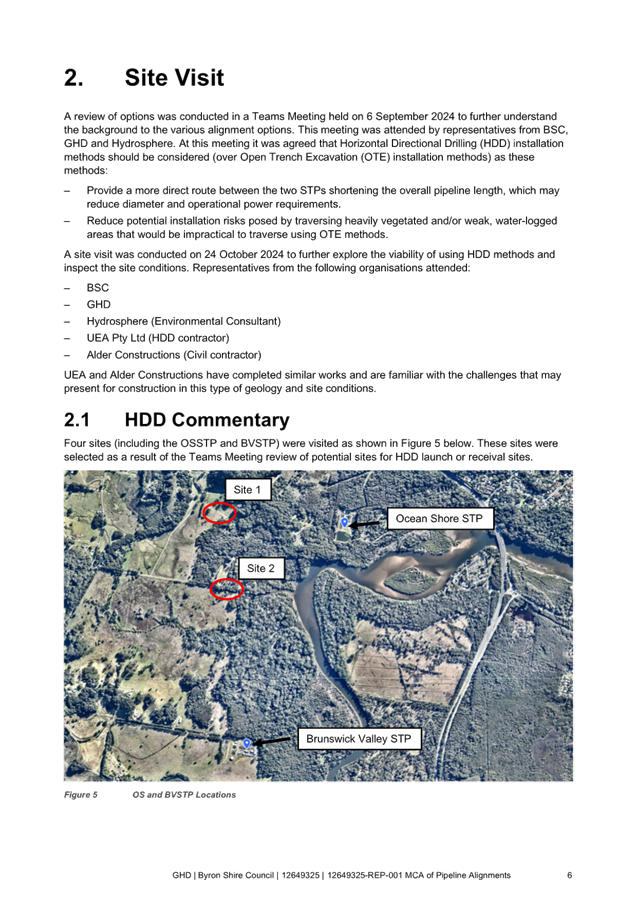
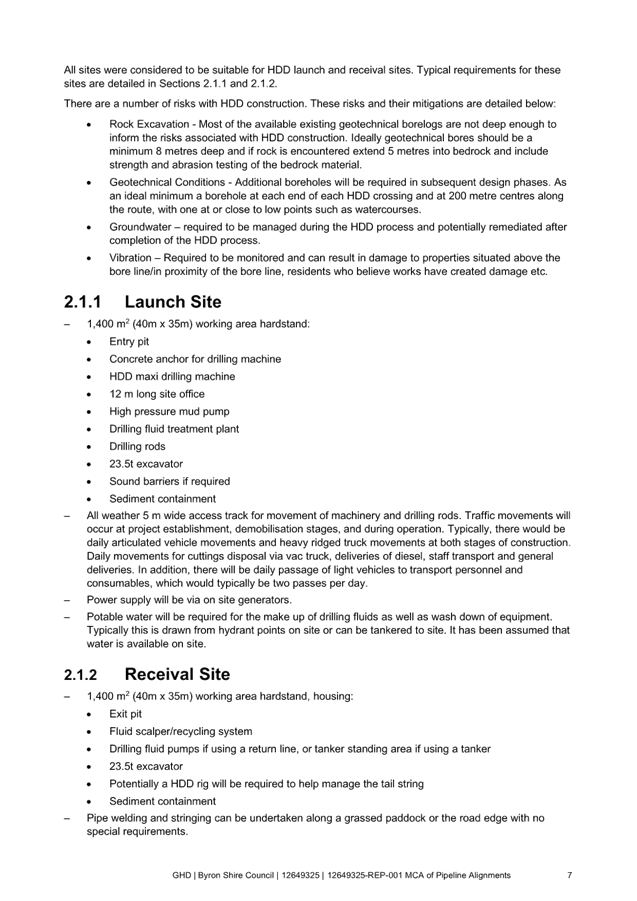
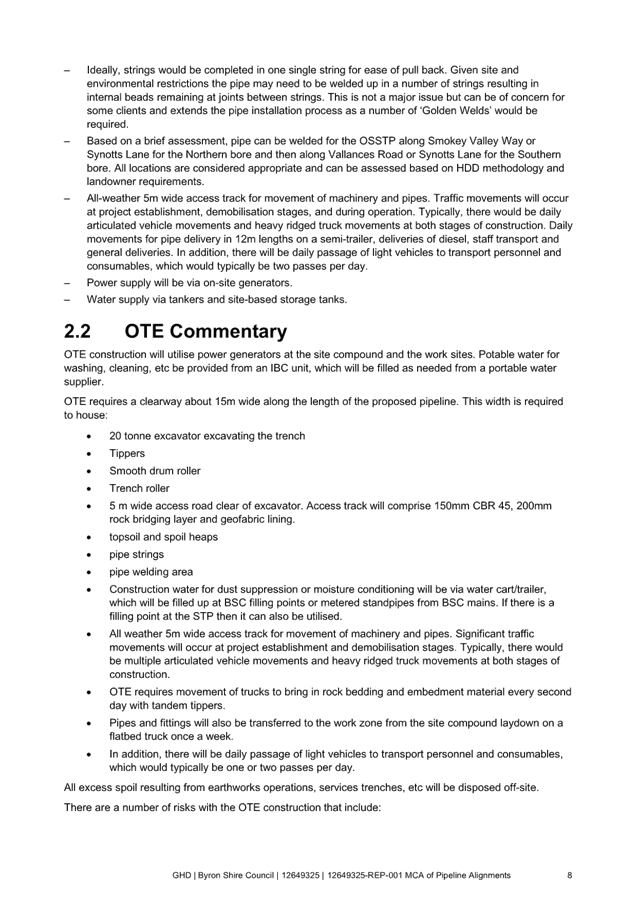


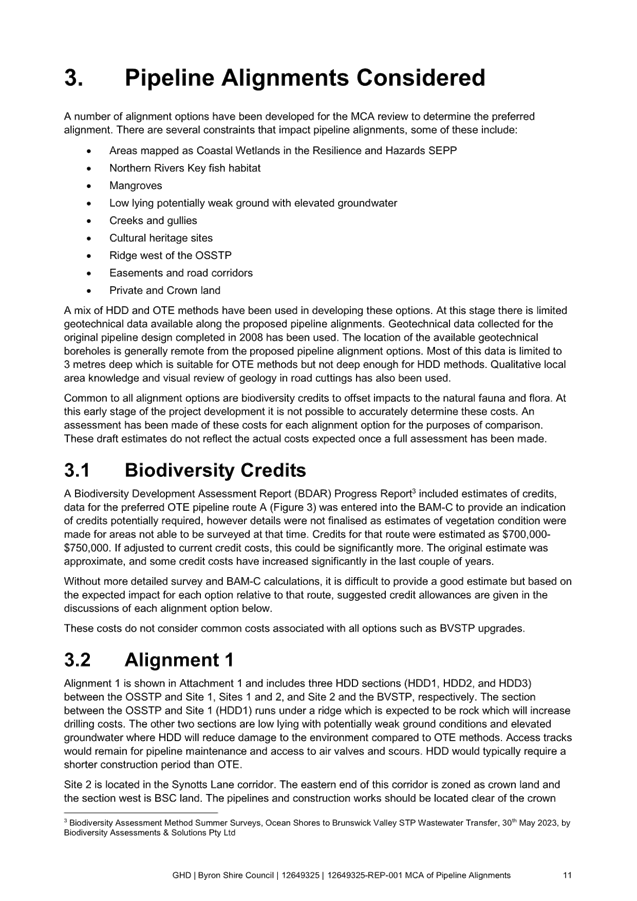


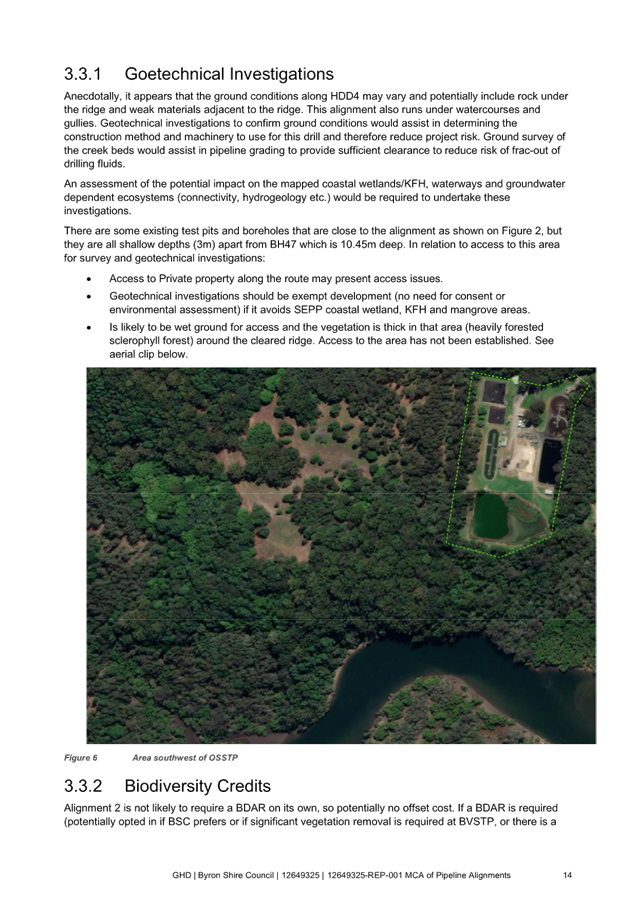
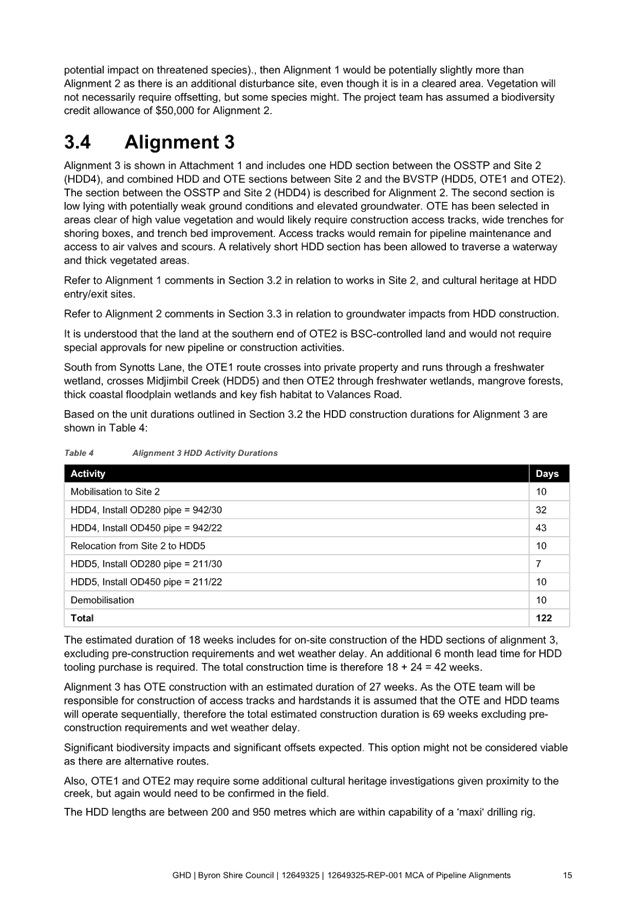
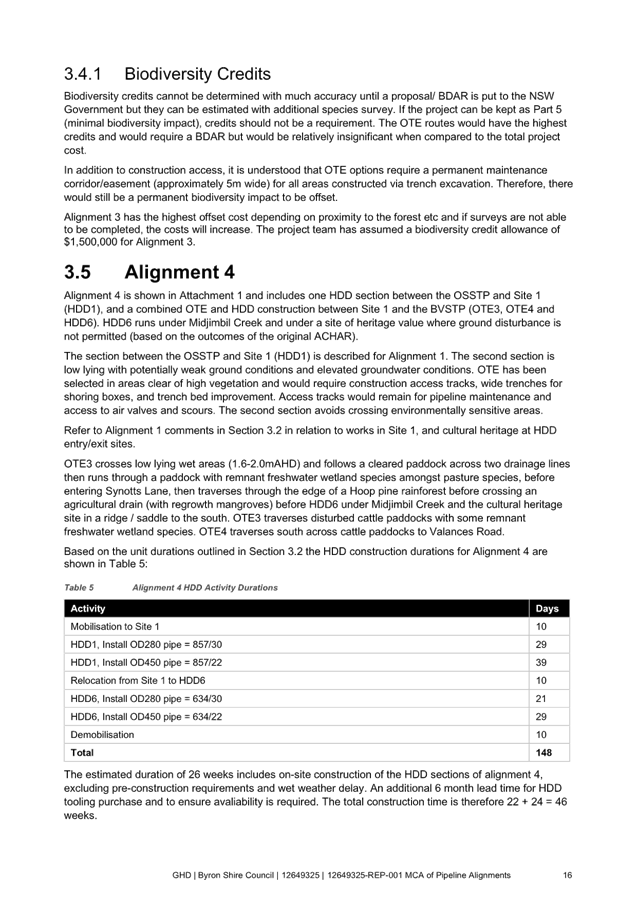
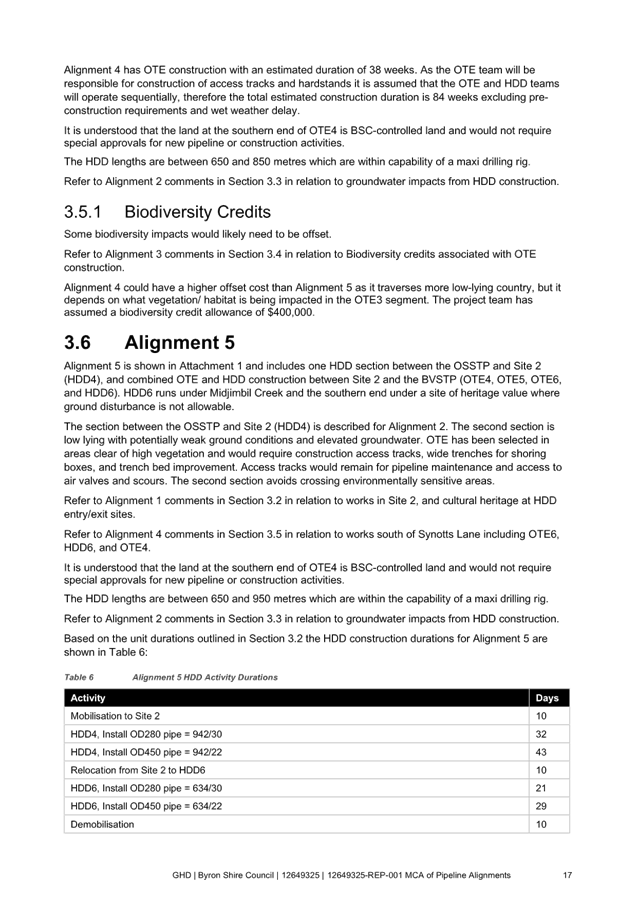
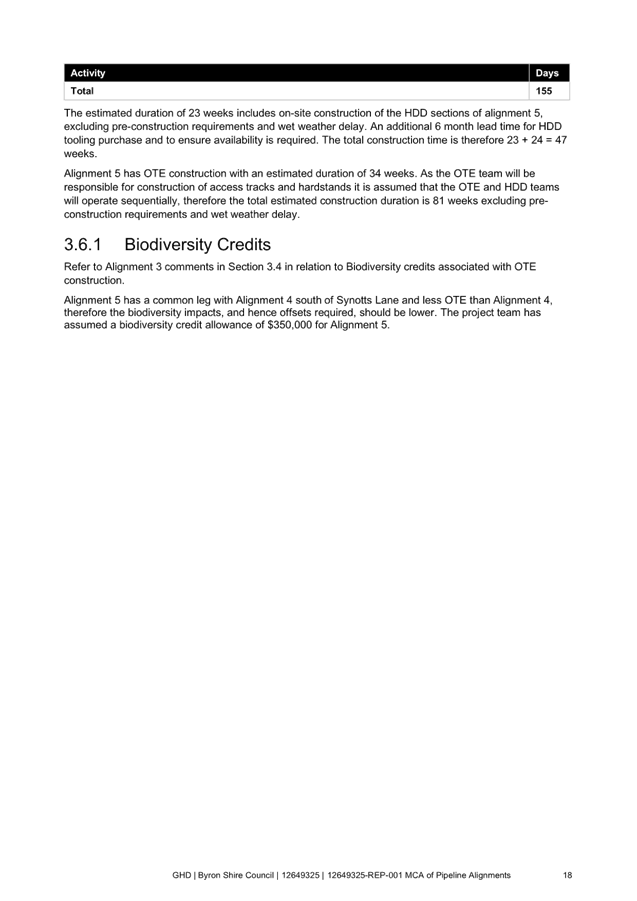
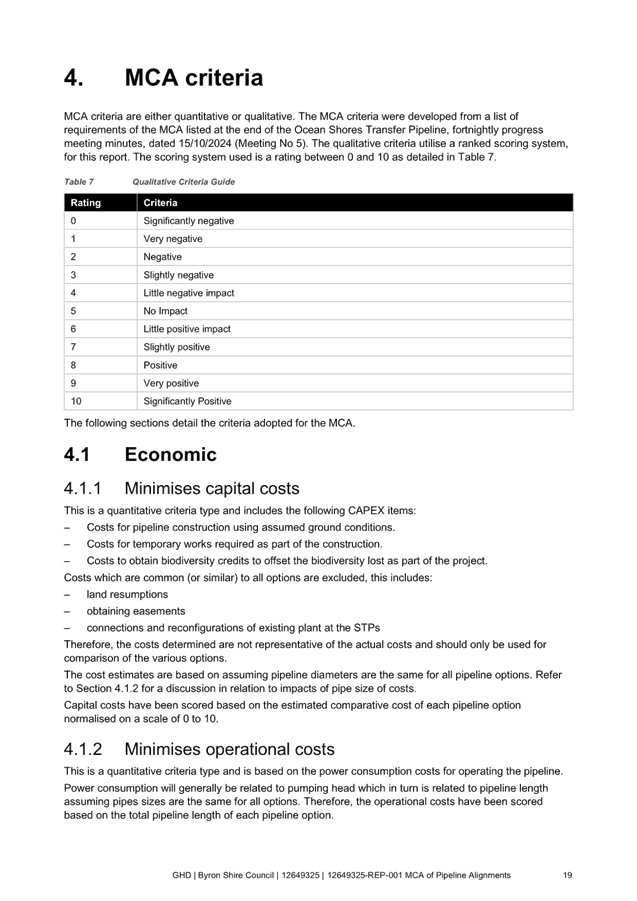

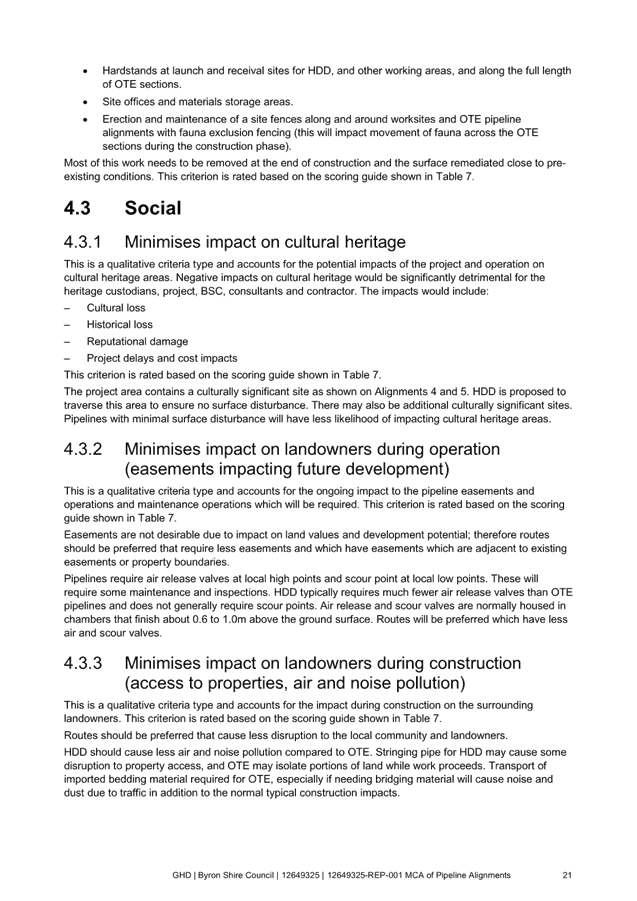

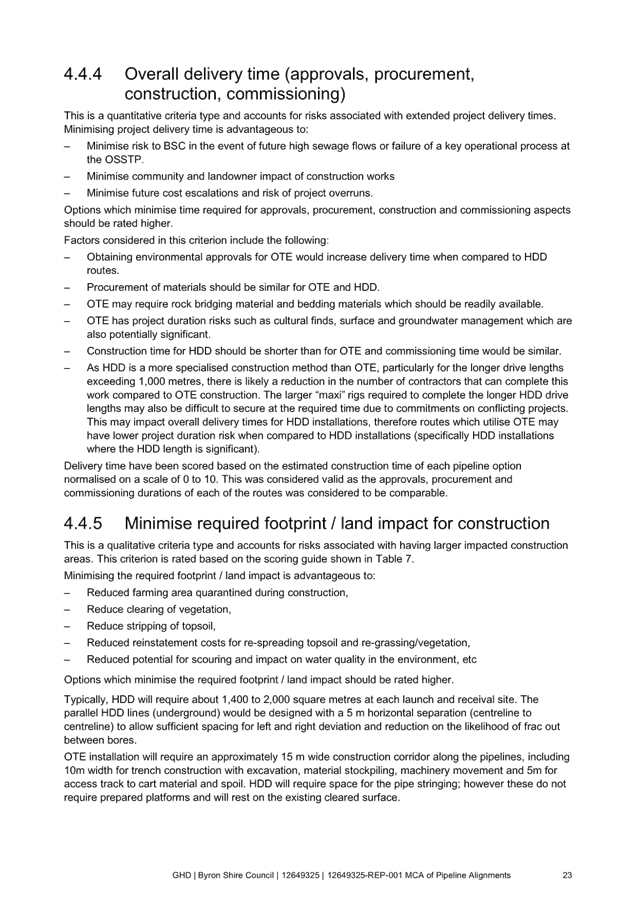


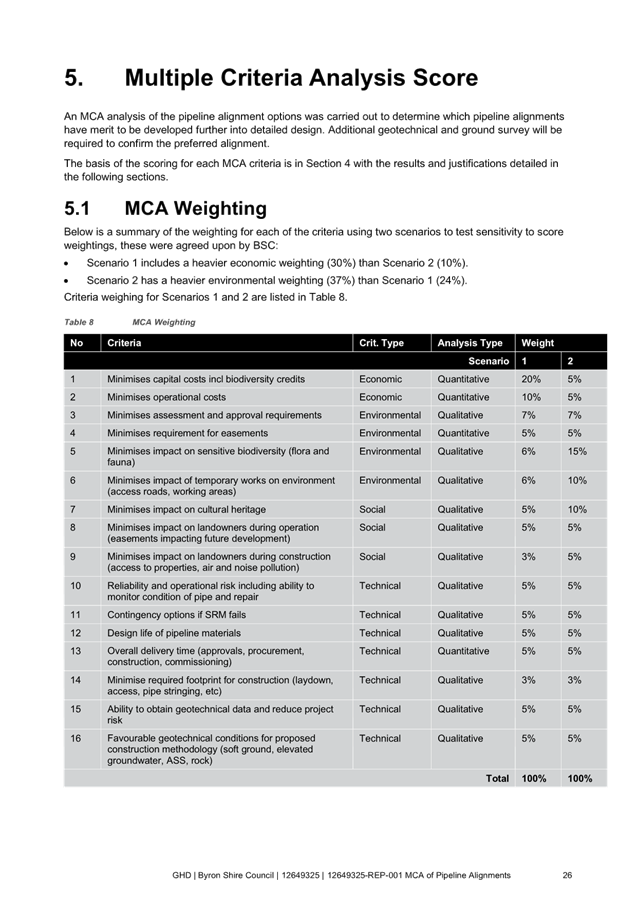

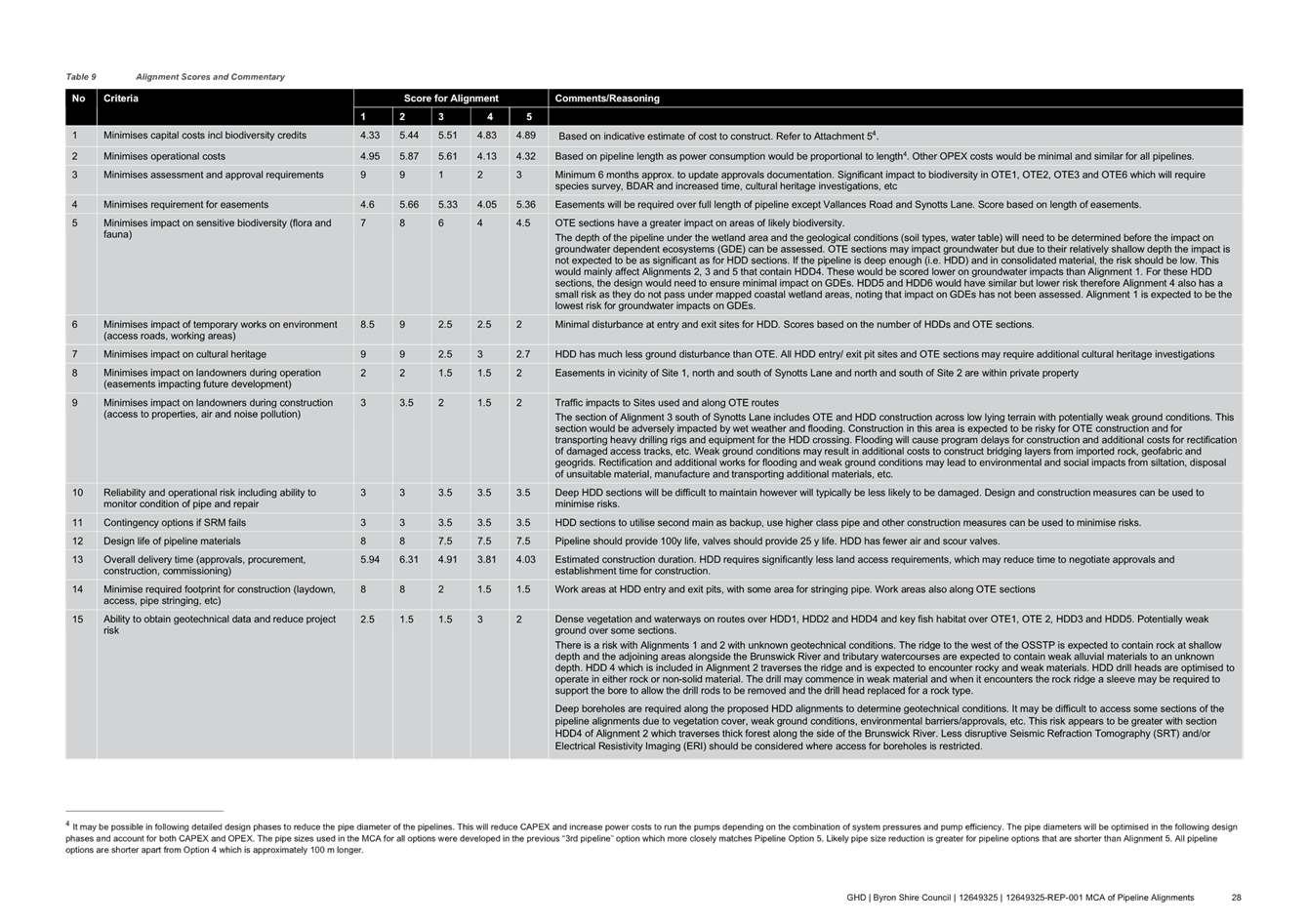
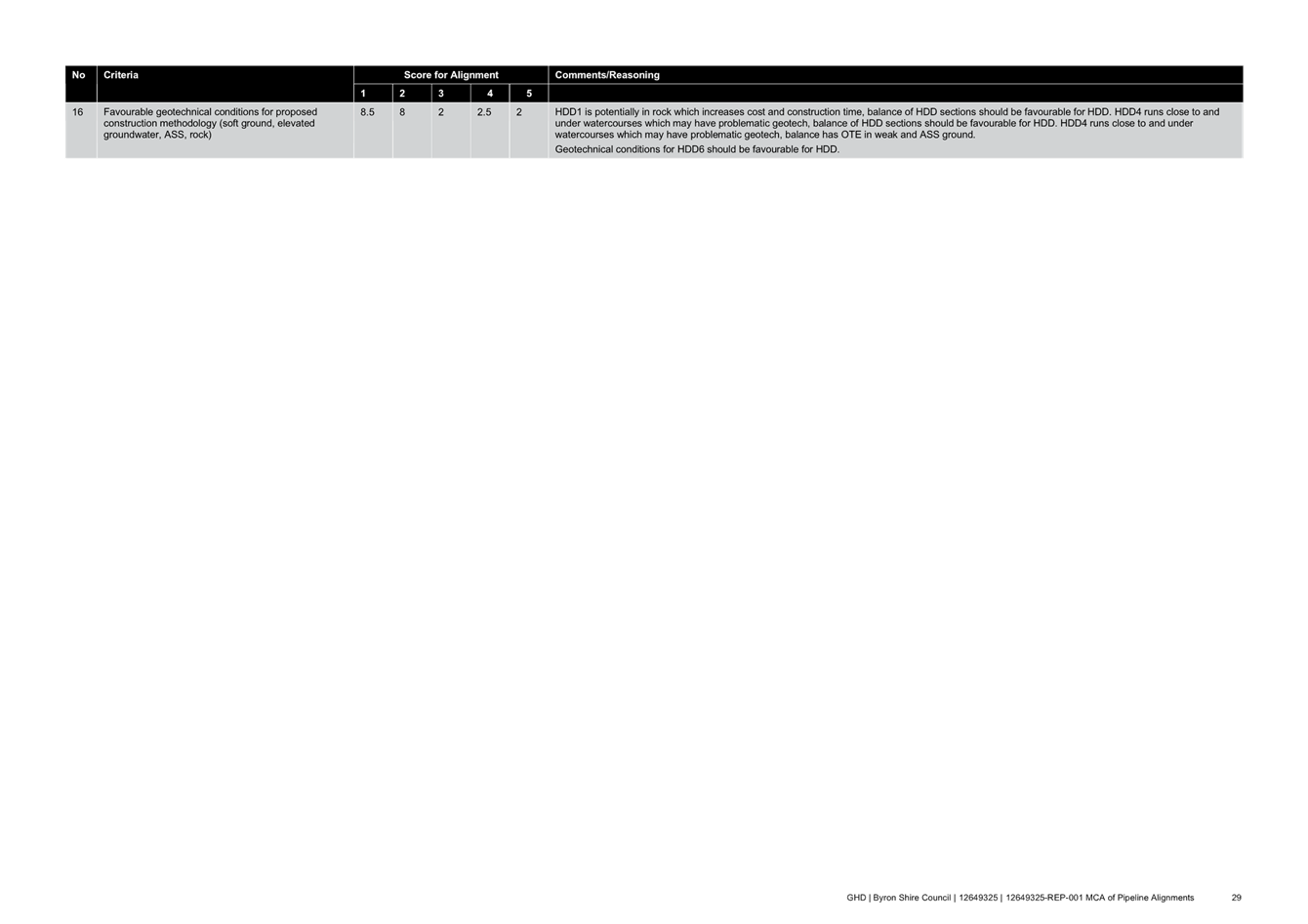

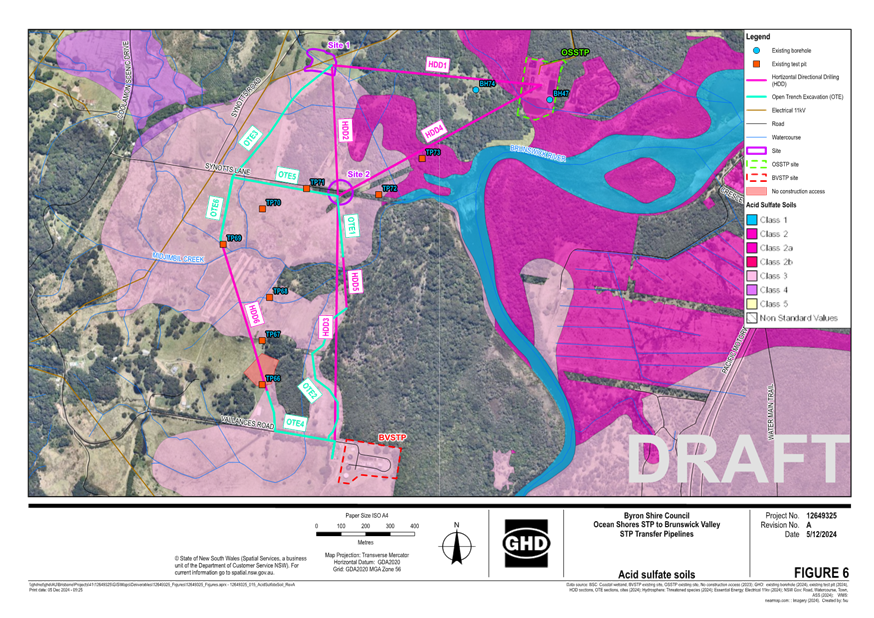
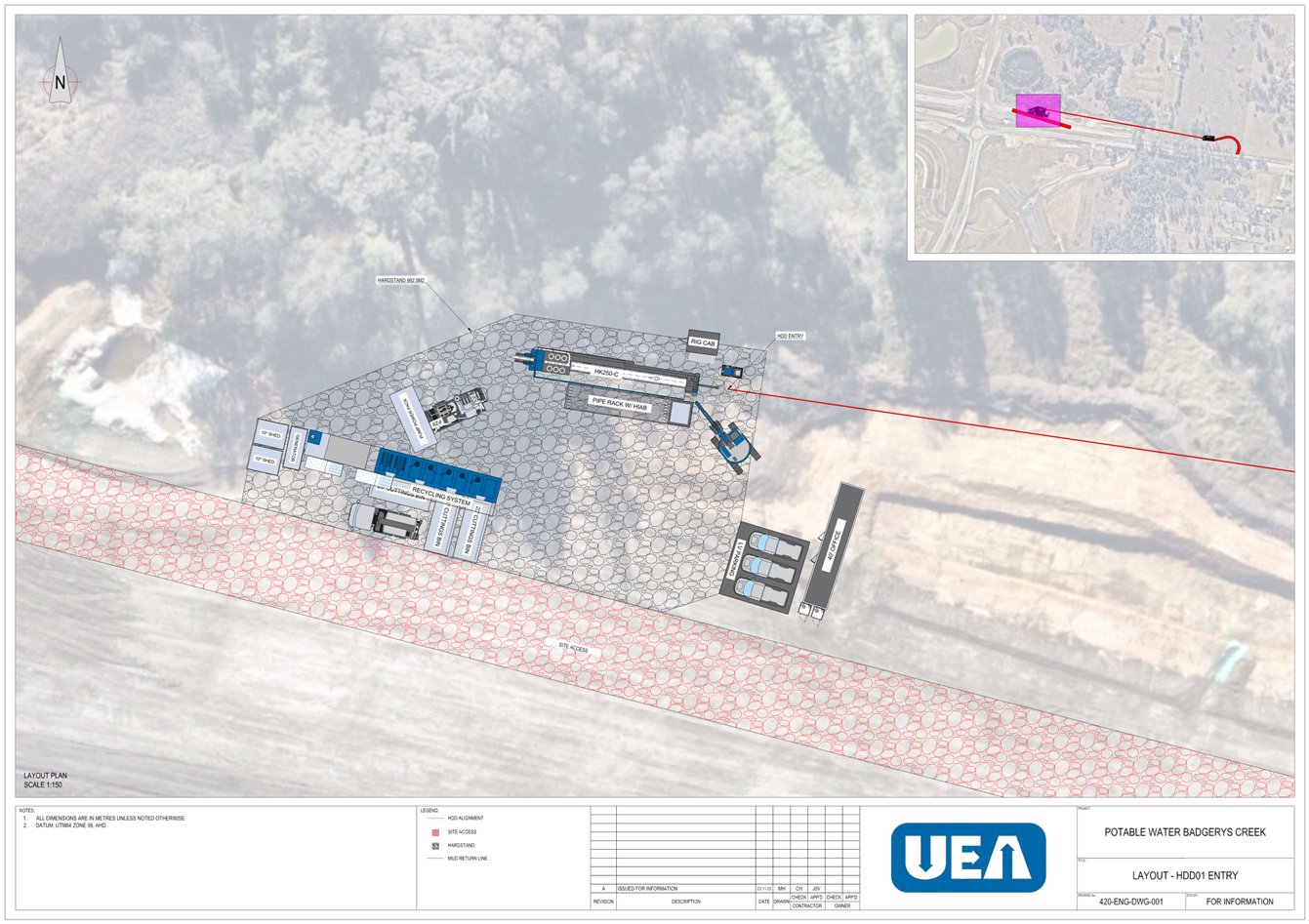
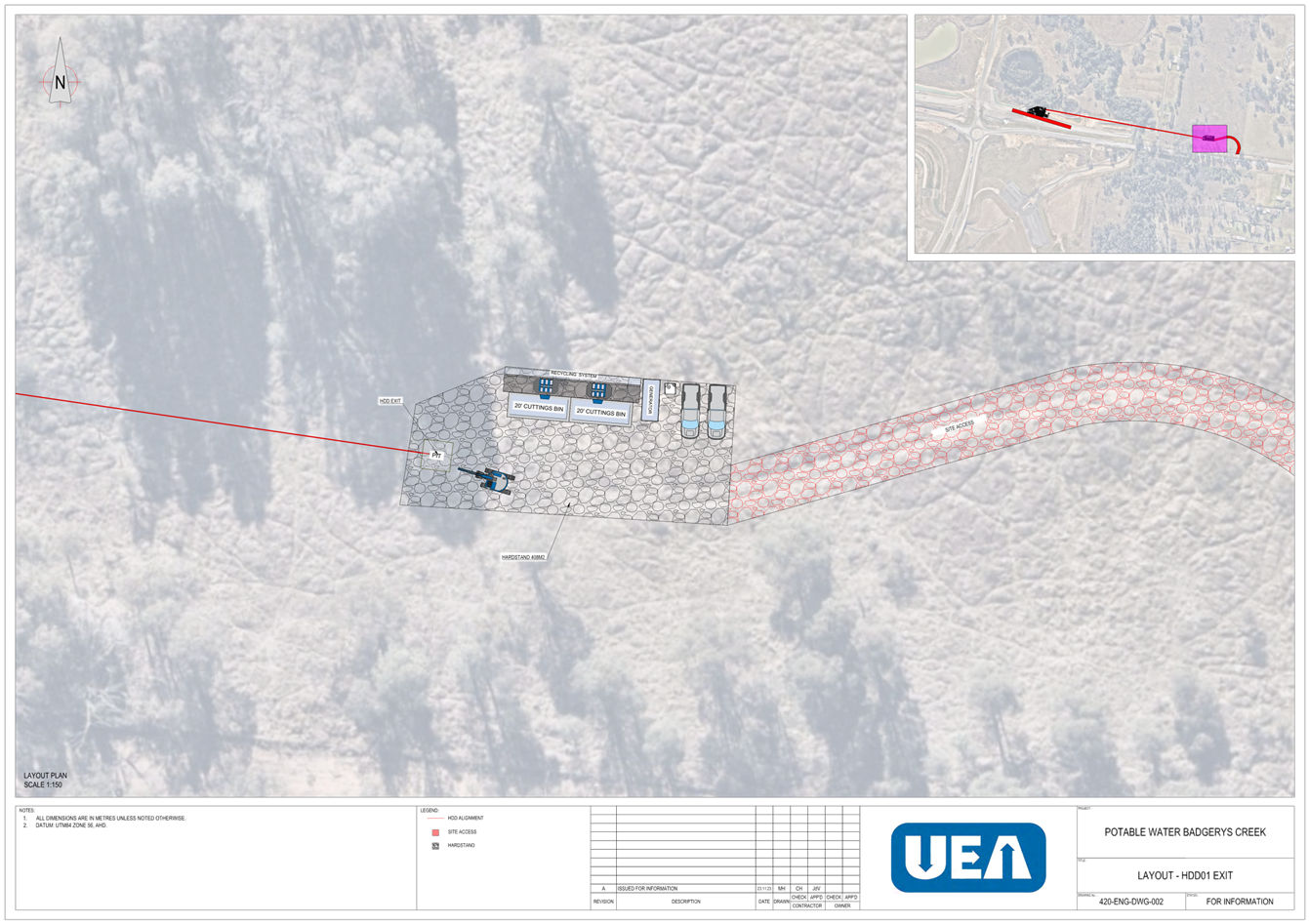
BYRON SHIRE COUNCIL
For Information Only 6.1
For Information Only
Report No. 6.1 Status
update - Mullumbimby Water Supply Strategy Project
Directorate: Infrastructure
Services
Report Author: Pablo
Orams, Integrated Water Management Officer
File No: I2025/751
Summary:
This report aims to brief the WSAC on the status of the
Mullumbimby Water Supply Strategy project, including updates on:
- Project
delivery plan
- Response
to previous WSAC meeting’s recommendations
Feedback from the WSAC is
welcomed.
Attachments:
1 NSW
Gov Business Case Guidelines on a page (TPG24-29), E2025/53961 , page 207⇩ 
2 Minutes
17/04/2025 Water and Sewer Advisory Committee, I2025/491 , page 209⇩ 
3 Minutes
19/07/2024 Water and Sewer Advisory Committee Extraordinary, I2024/1042 , page 215⇩ 
Report
1. Project delivery plan
1.1. Stage 1 – Project methodology development
Following the outcomes of the previous WSAC meeting (17
April 2025), and subsequent refinement of the project concept plan, Council has
engaged consultancy firm Natural Capital Economics (NCEconomics) to assist in
the development of a robust, best-practice methodology to deliver the desired
project outcome (i.e. “provide Council with evidence-based
recommendations for deciding on a long-term water supply strategy for
Mullumbimby”).
This stage will cost $19,899 and will be completed
before the end of June 2025. It will include:
- Task 1 - Development of a decision-making framework that aligns with the NSW Government Business Case
Guidelines - TPG24-29 (see a summary of the guidelines in Attachment 1).
These provide an established framework to guide policy or investment decisions,
and will ensure that Council’s consideration of water supply options for
Mullumbimby is aligned with best practice. If external public funding is
required (and available), the assessments and outputs from this project can
then be easily included into a detailed business case to the NSW Government.
- Task 2 - Audit and gap analysis of previous assessments, including (but not limited to):
o Technical
assessments of option development.
o Extent
of stakeholder/community engagement.
o Robustness
of current and projected water demand assessments.
o Environmental,
economic, financial and social impact assessments.
This evaluation will gauge the
appropriateness of previous work to feed into the decision-making framework
developed in Task 1. This will be supported by engaging with Council staff and,
where feasible, with previous consultants, to understand challenges and
complexities with previous assessments.
- Task 3 - Identify additional technical assessments based on the outcomes of Task 2. Consideration will be given to appropriate sequencing of
these technical assessment to inform the methodology for delivery.
- Task 4 - Develop robust stakeholder engagement strategy that can directly and meaningfully feed into the
decision-making process. This may include:
o Surveys
to capture specific stakeholder input into multi-criteria analysis.
o Facilitating
focus groups and/or workshops to identify key social impacts from options.
o Targeted
engagement with a community or stakeholder reference group or other fit-for-purpose
deliberative process.
- Task 5 - Consolidate
approach and budgeting. This task involves consolidating findings from
preceding tasks into a recommended project delivery plan and indicative budget
for the next 14-16 months of work.

1.2. Stage 2 – Implementation of decision-making framework
Having developed a robust
best-practice methodology and a clear delivery plan, Council will move into
Stage 2 of the project, undertaking the necessary technical assessments and
stakeholder engagement to feed into the decision-making framework that Council
will use to make its final decision.
Completion of Stage 2 is expected by October 2026.
While the cost of Stage 2 is to be defined based on the
outcomes of Stage 1, early estimates indicate a budget scope of $150K to
$200K.
2. Consideration of recommendations from the WSAC
As per the minutes from the 17 April 2025 WSAC meeting (see Attachment 2), Report No. 4.2, the WSAC provided
two recommendations:
“3. That Council keep
the WSAC informed of subsequent changes to the project design, including
between WSAC meetings.”
“4. That Council
consider in the project the investigations previously sought by the WSAC, and
recorded in its Minutes for the meeting of 19 July 2024.”
Item 3 is noted. Staff will maintain regular and transparent
engagement with the WSAC.
Item 4 has been considered by staff. The
“investigations previously sought by the WSAC” are outlined in Item
5 of Report 4.1 of the referred minutes (see Attachment
3), and summarised in the below table with comments from staff for
their relevance and adequacy for the project.
|
WSCA
recommendation
|
Staff comment
|
|
5. [That
Council] Proceeds with the investigations previously outlined in Parts 7 and
8 of Resolution 23-120 with some additions in 8b and 8c, namely:
7. [That
Council] Investigates a strategy for Mullumbimby’s long term water
supply based on the following concept:
|
|
|
a) Lavertys Gap as the source during flows in excess of
environmental requirements;
|
Noted.
This scenario has already been considered in previous investigations. To be
further assessed during Task 2 and Task 3 of project Stage 1.
|
|
b) water stored off-stream between the source and
Mullumbimby;
|
|
c) water treated at a new location between the storage
and Mullumbimby;
|
|
d) water delivered to Mullumbimby and possibly beyond;
and
|
Noted. Investigation will focus on the Mullumbimby system.
Commentary on potential spare supply capacity may be provided.
|
|
e) maximising demand management, including the
harvesting of roof water.
|
Noted.
To be assessed during Task 2 and Task 3 of project Stage 1.
|
|
8. [That
Council] Includes in this investigation:
|
|
|
a) the
topography of the terrain between Lavertys Gap and Mullumbimby, to identify
potential dam sites;
|
Noted.
While high-level commentary will be provided regarding potential locations
for an off-stream storage, detailed topography assessments are not required
to develop reasonable cost estimates.
|
|
b) the
hydrology of Wilsons Creek and its capacity to supply, including
(i) seasonality,
(ii) establishing environmental flows for
future EPA licensing;
|
Noted.
To be assessed during Task 2 and Task 3 of project Stage 1.
|
|
c) the
impact of climate change on supply and on demand (using up-to-date CC data
and methodologies in the pilot phase for local water supply through DPE, and
applied in Regional Water Strategies);
|
|
d) infrastructure
needs including offtake, storage, treatment and linkages to the town’s
reservoirs;
|
Noted.
To be assessed during Task 2 and Task 3 of project Stage 1.
Detailed
design, technical specifications or planning consent materials, beyond those
required to develop a reasonable estimate of costs, will not be pursued. The condition of
Lavertys
Gap weir’s condition is being assessed, monitored and managed in
alignment with the Utilities Department’s Asset Management System.
|
|
e) environmental
assessments for the creation and operation of that infrastructure, including
greenhouse gas emissions;
|
|
f) assessment of the weir at Lavertys Gap including
(i) structural integrity;
(ii) means of creating fish passage; and
(iii) how this proposal enhances its heritage
and preservation; and
|
|
g) economic
assessment;
|
Noted.
|
3. Next steps
Following the completion of Stage 1 of the project,
the detailed scope of work for Stage 2 will be presented to the WSAC.
Strategic Considerations
Community Strategic Plan
and Operational Plan
|
CSP Objective
|
CSP Strategy
|
DP Action
|
Code
|
OP Activity
|
|
5:
Connected Infrastructure
|
5.5: Provide
continuous and sustainable water and sewerage management
|
5.5.1:
Water supply - Provide a continuous water supply that is maintained in
accordance with NSW Health guidelines
|
5.5.1.20
|
Report to Council on the future
water strategy for Mullumbimby
|
For Information Only 6.1 - Attachment 1
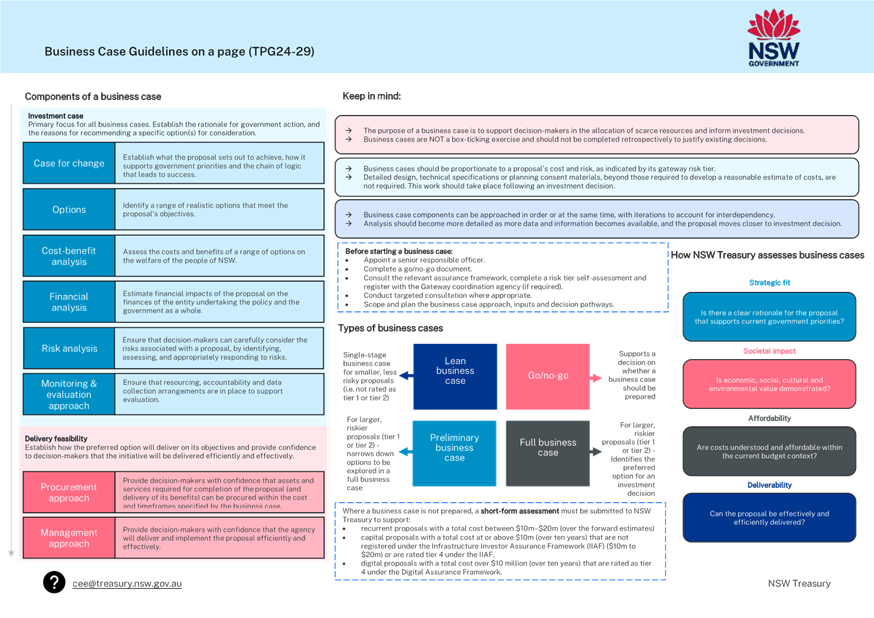
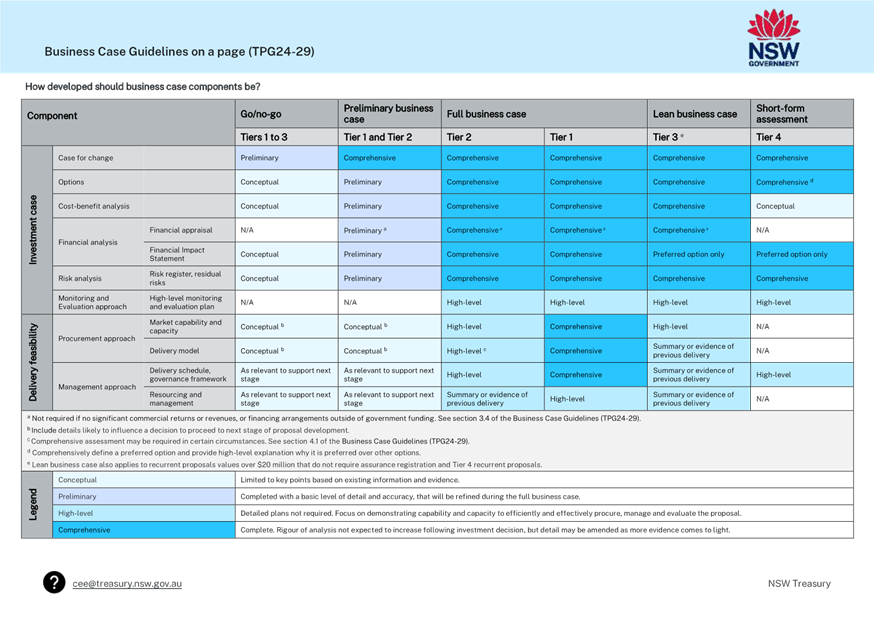
For Information Only 6.1 - Attachment 2
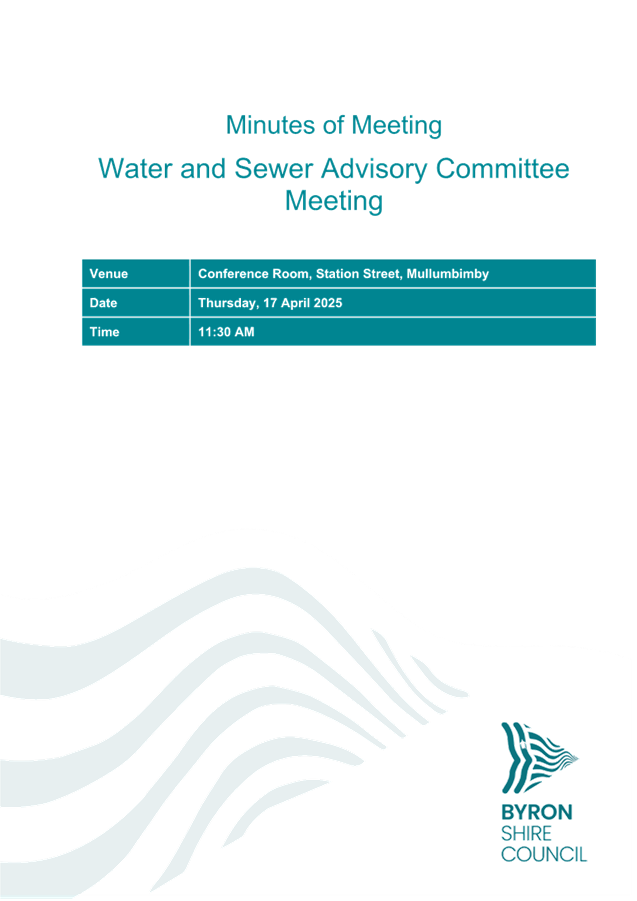

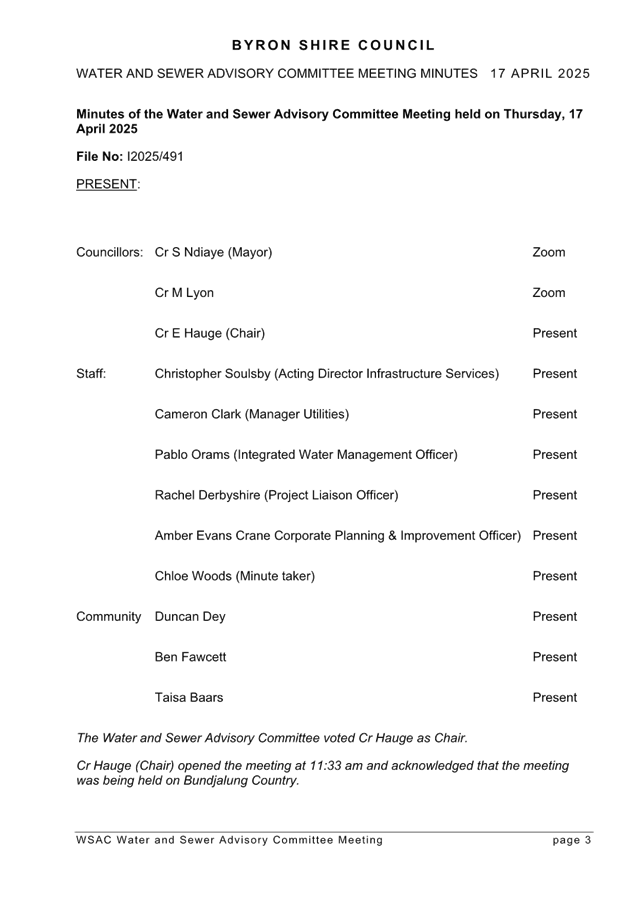

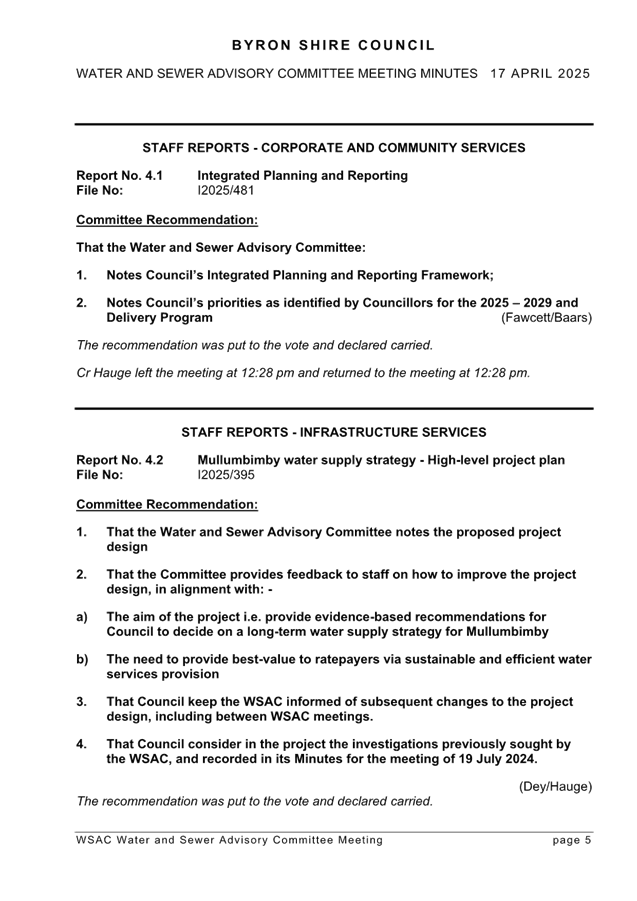

For Information Only 6.1 - Attachment 3
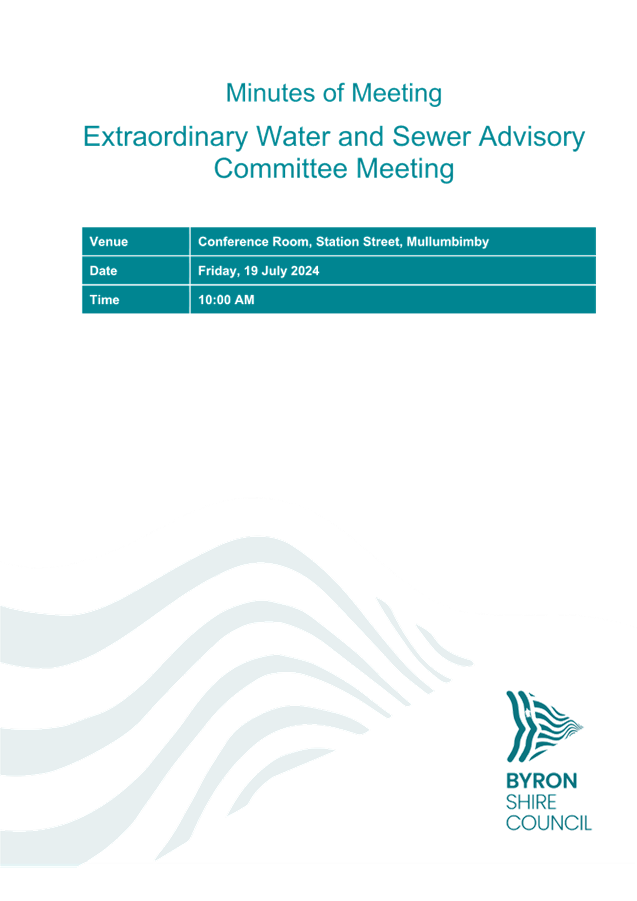

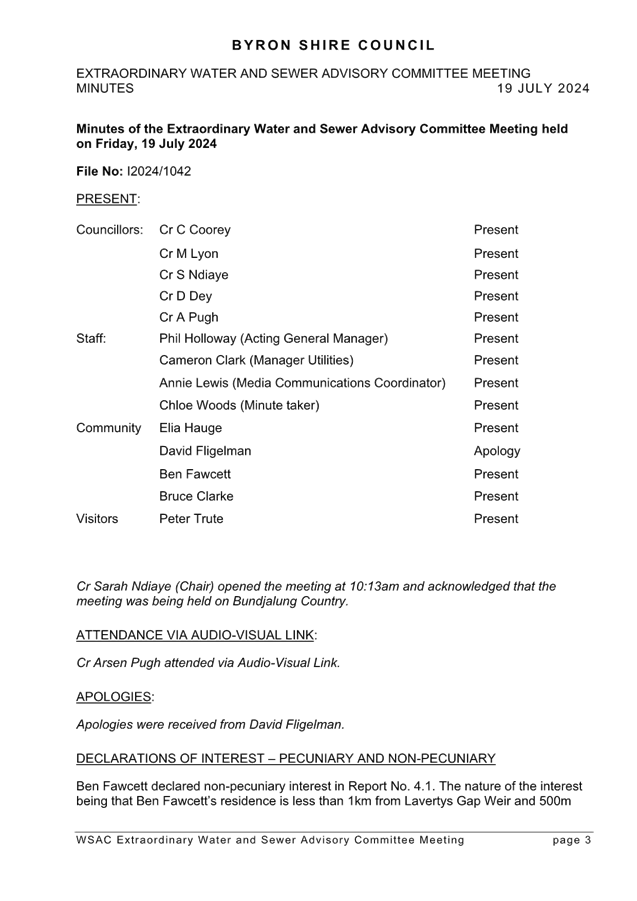
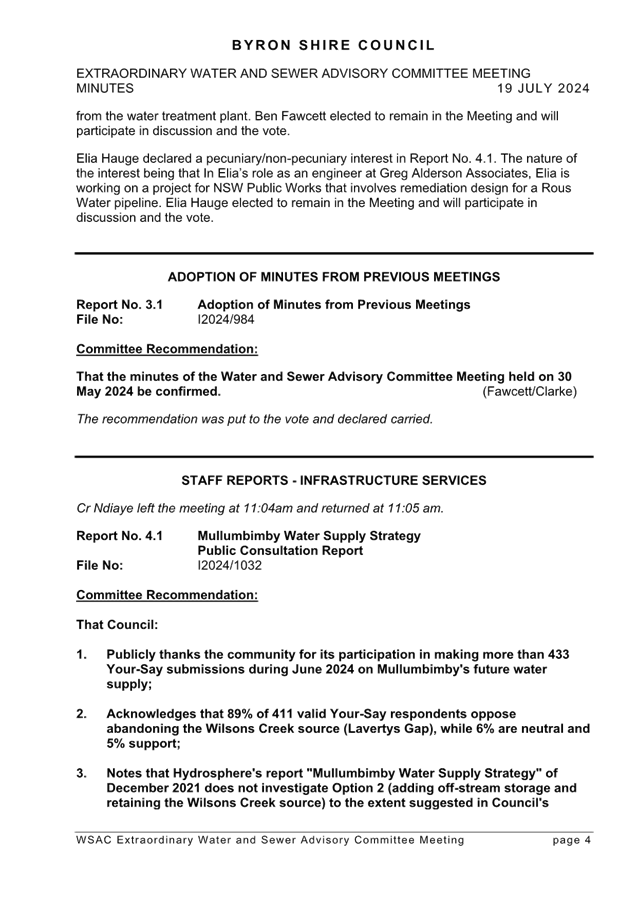

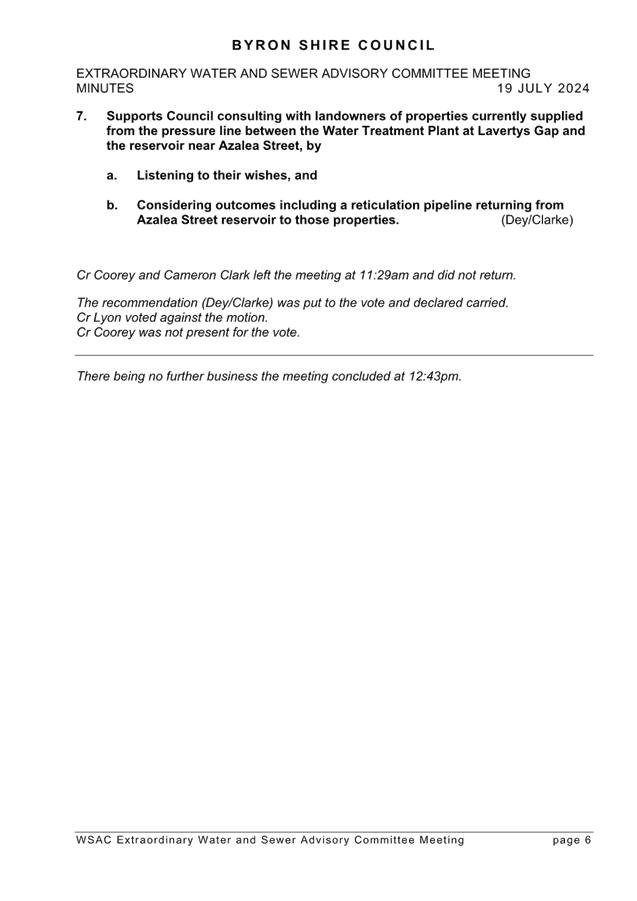
BYRON SHIRE COUNCIL
For Information Only 6.2
Report No. 6.2 Byron
Bay Sewage Treatment Plant Master Plan Update
Directorate: Infrastructure
Services
Report Author: John
Hart, Senior Project Manager
Dean Baulch, Principal Engineer, Systems Planning
File No: I2025/766
Byron Bay STP Master Plan - Status Summary for Information
Only:
Council retained GHD Pty Ltd (GHD)
to conduct a Master Plan for the Byron Bay Sewage Treatment Plant (BBSTP).
Key Findings:
· Inlet flows to BBSTP (2017–2023 data) are nearing 80%
of its design capacity for Average Dry Weather Flow (ADWF).
· BBSTP is at the threshold for planning on capacity
augmentation.
Master
Plan Scope:
· Re-baselined actual inflow and loadings from the catchment.
· Forecast how long the current plant can continue delivering
compliant service under EPA licence: Results suggest that BBSTP shall
remain compliant with its current EPA licence conditions up until 2036 and
2041, subject to the growth experienced between now and that period.
· Identified the timing and need for major treatment process
upgrades.
Interim
Work:
· GHD conducted detailed flow and load sampling to inform
planning.
· Several short- and medium-term projects have been
identified for Council’s capital works program.
· Interim upgrades will be required before major augmentation
begins.
Status:
· Final Master Plan report to be delivered early next
financial year.
· A more detailed update will follow upon receipt of the
final report.
A
timeline of planning stages:
· The
design and approvals are forecast to take 2-3 years to complete
· Procurement
and construction would take 1-2 years.
· Utilities
will plan to repeat the BBSTP loading assessment and capacity re-baselining in
~2030 to inform when the planning process should commence for the augmentation.
Overview
of new approvals or licences likely required for the upgrade:
· An
Environmental Impact Statement (with its ancillary companion studies) and
application for an Environmental Protection Licence amendment shall be the
principal major components for the Development Application for the augmentation
works.
 I2025/867
I2025/867








 Byron
Shire’s water supply network is inherently complex and fragmented across
a large area. It comprises over rateable 13,000 water connections
distributed across 20 water supply catchments (see
Byron
Shire’s water supply network is inherently complex and fragmented across
a large area. It comprises over rateable 13,000 water connections
distributed across 20 water supply catchments (see











































































